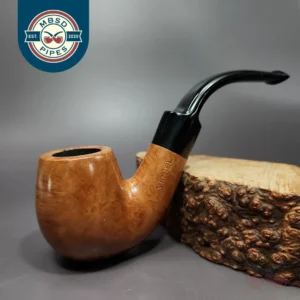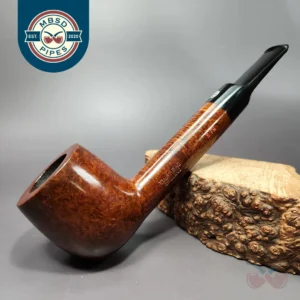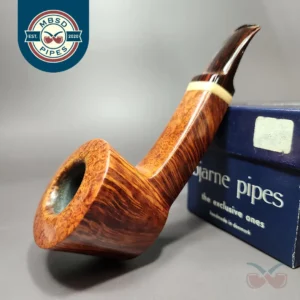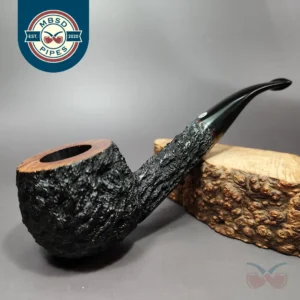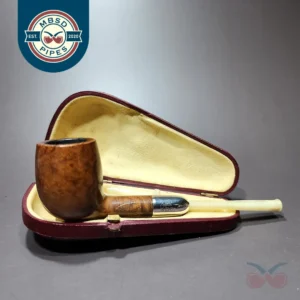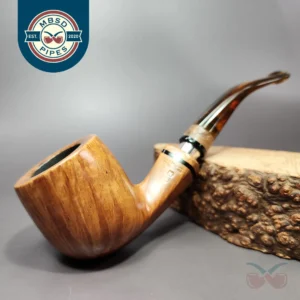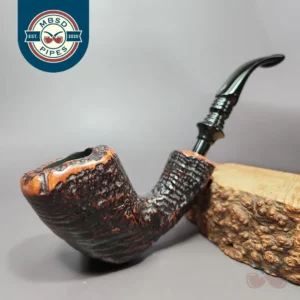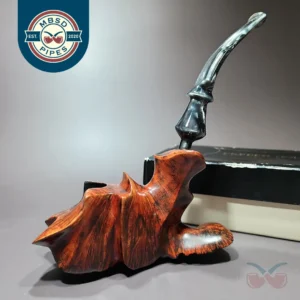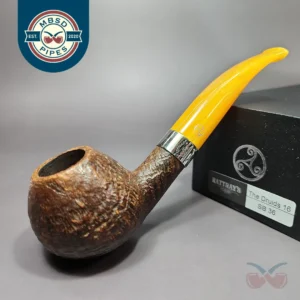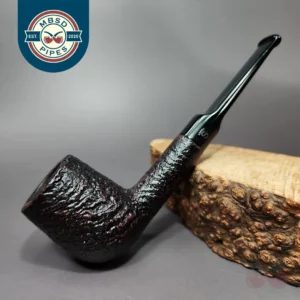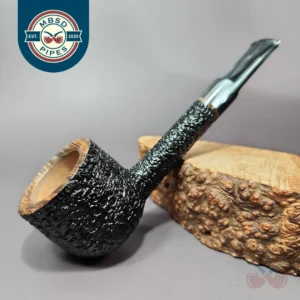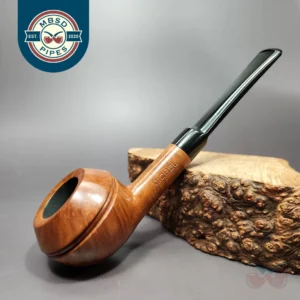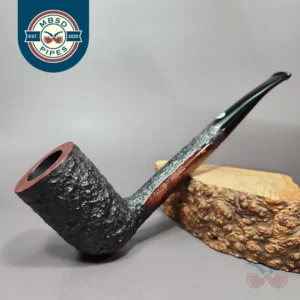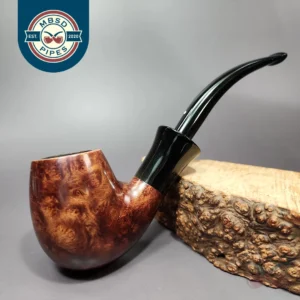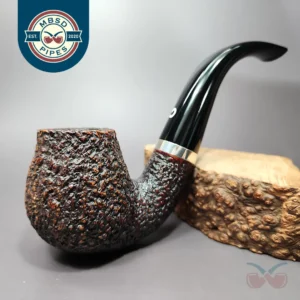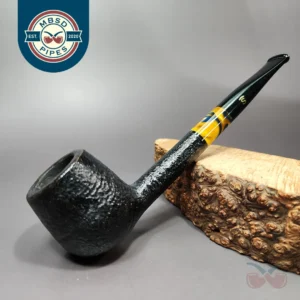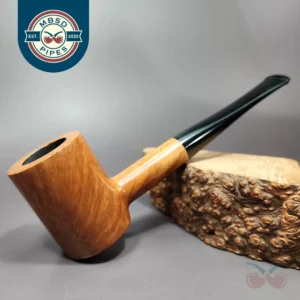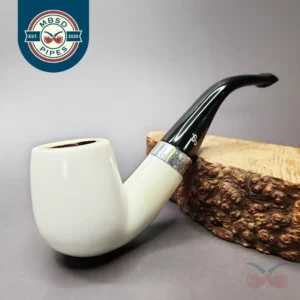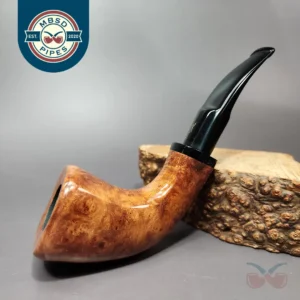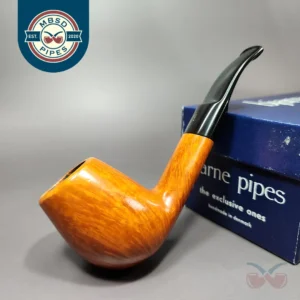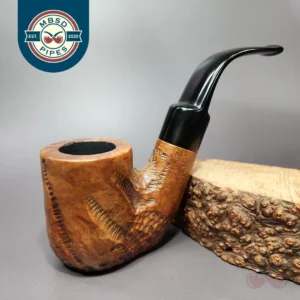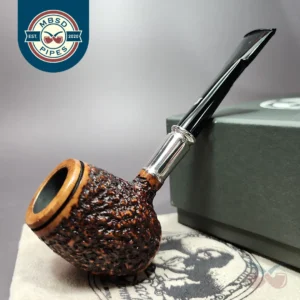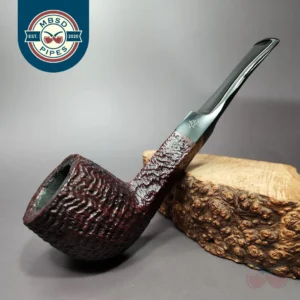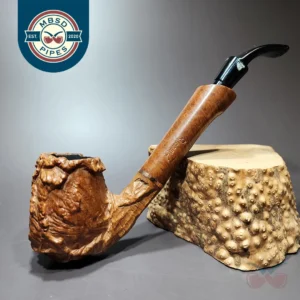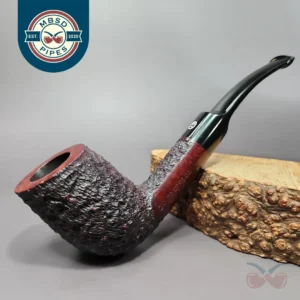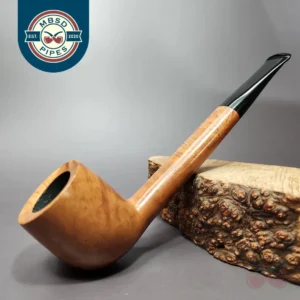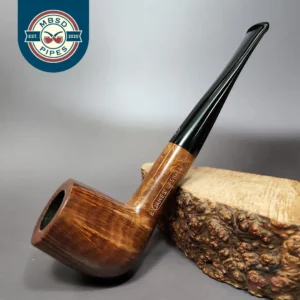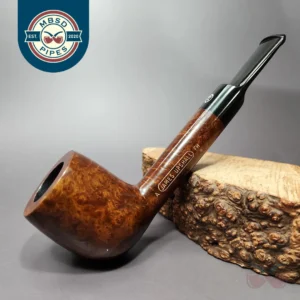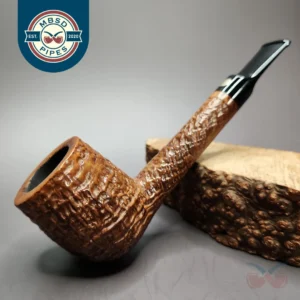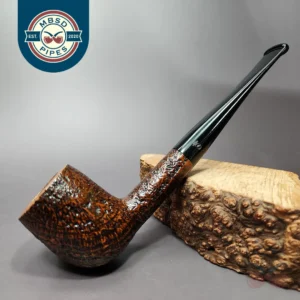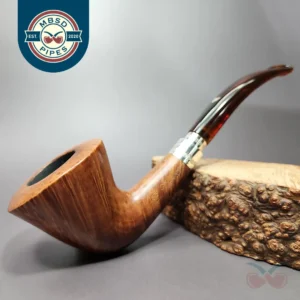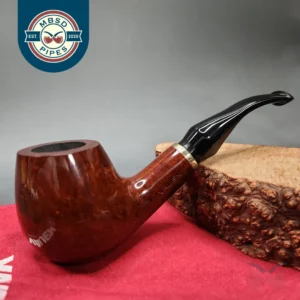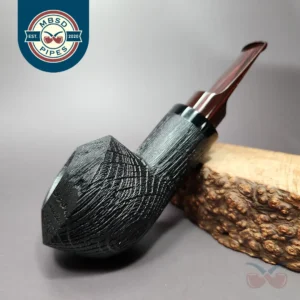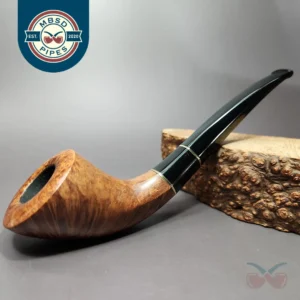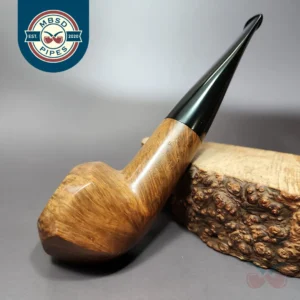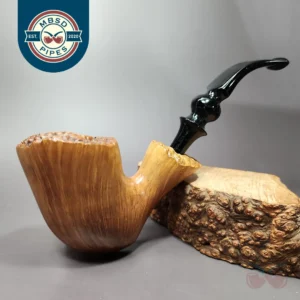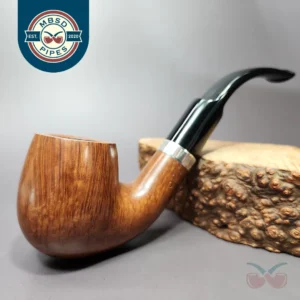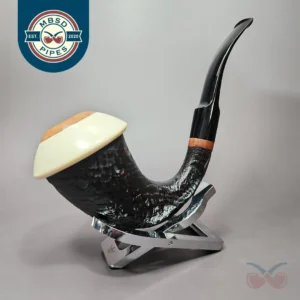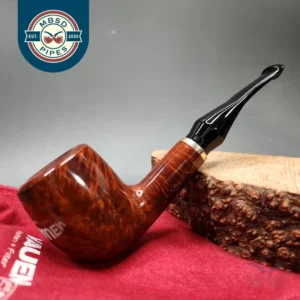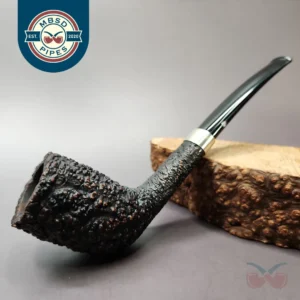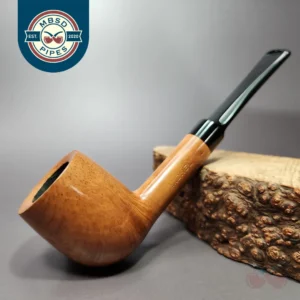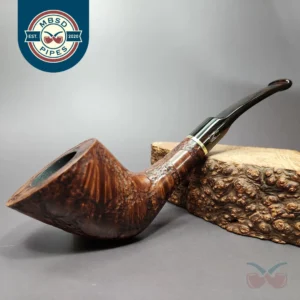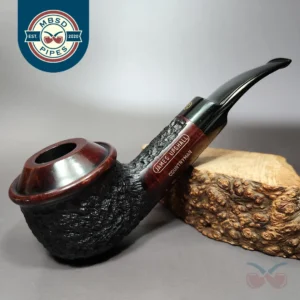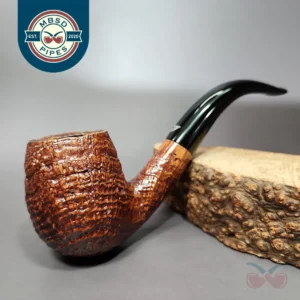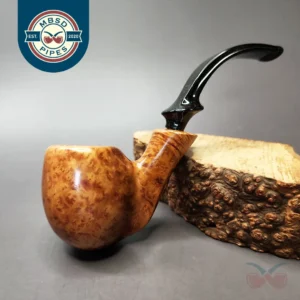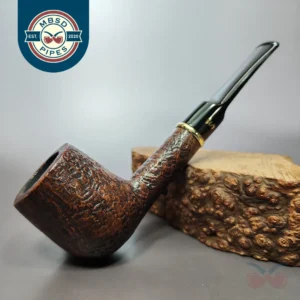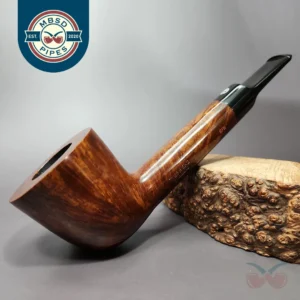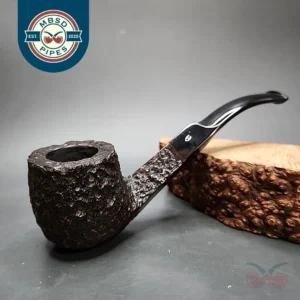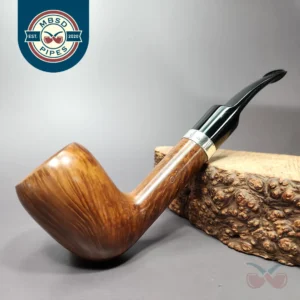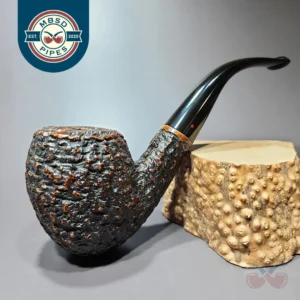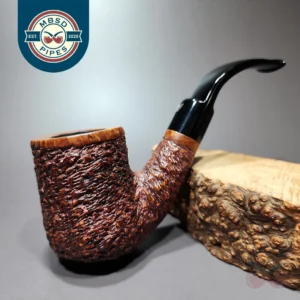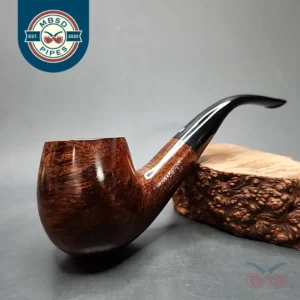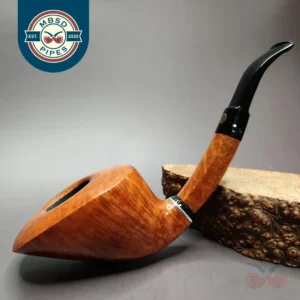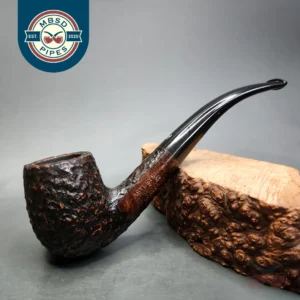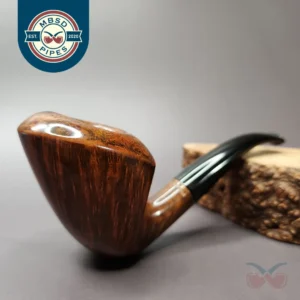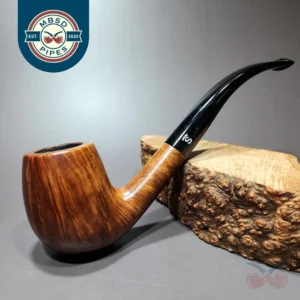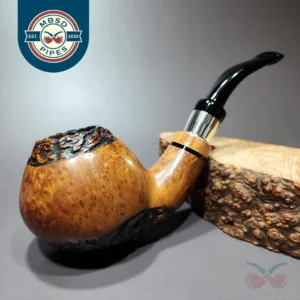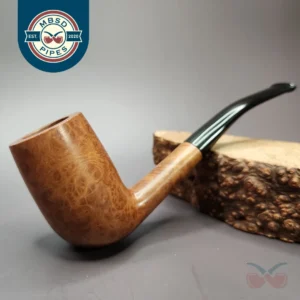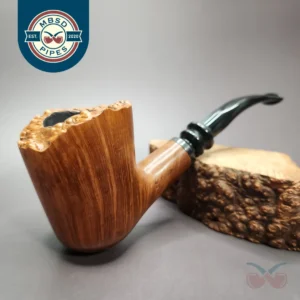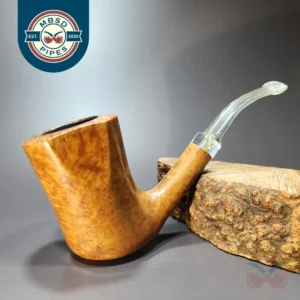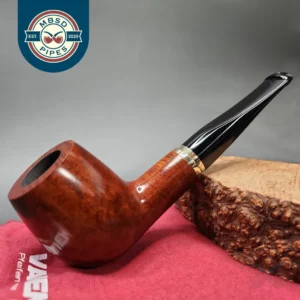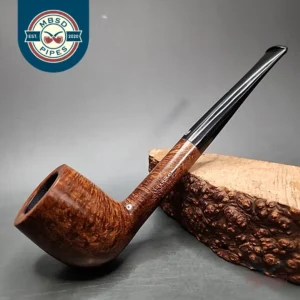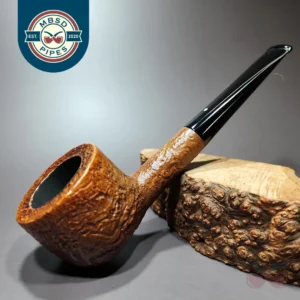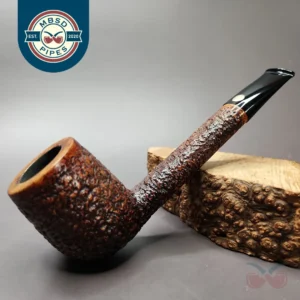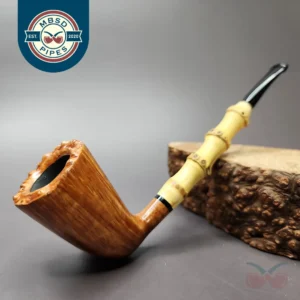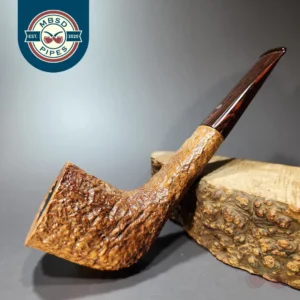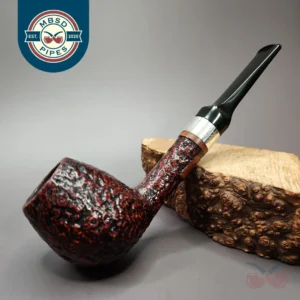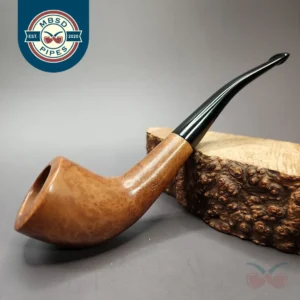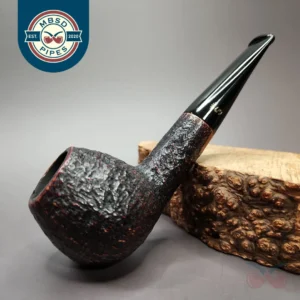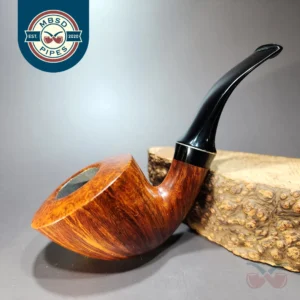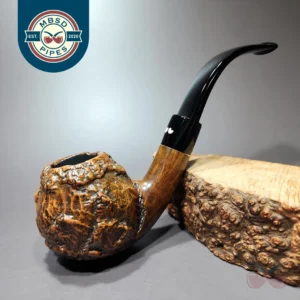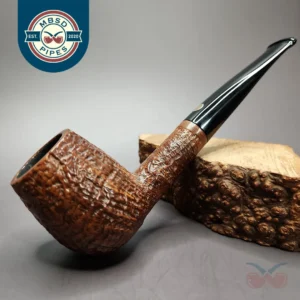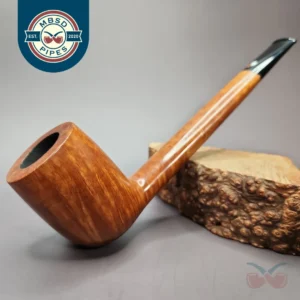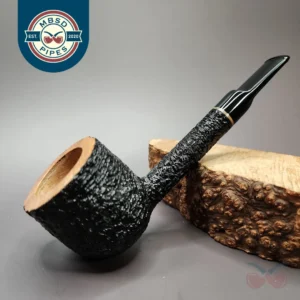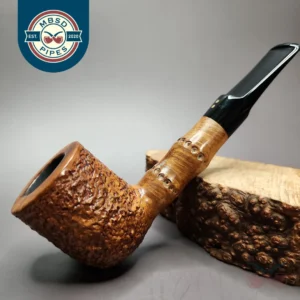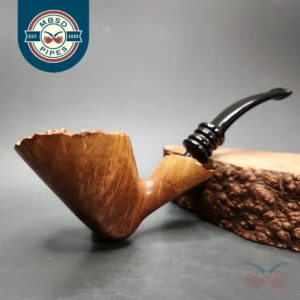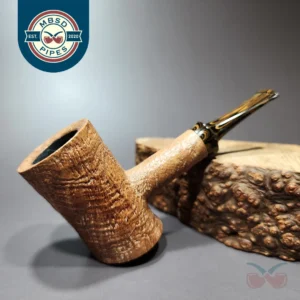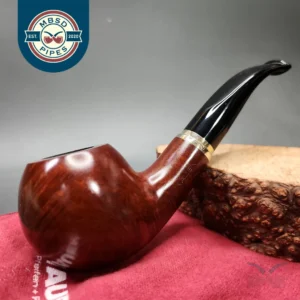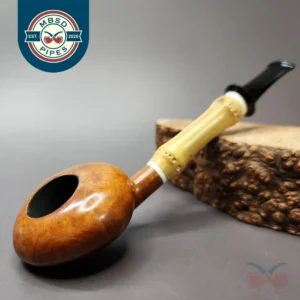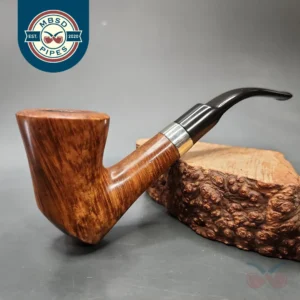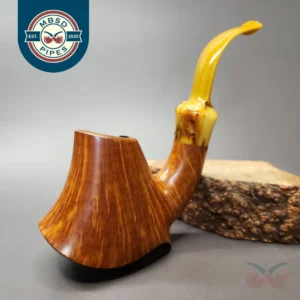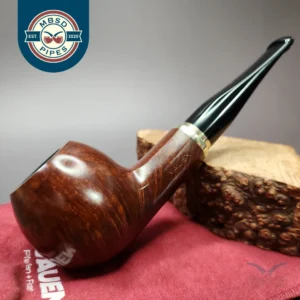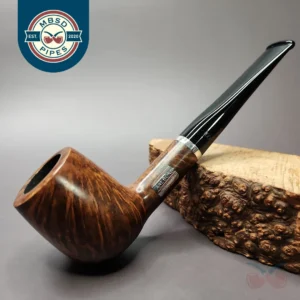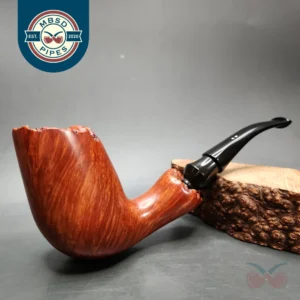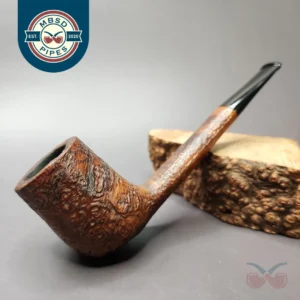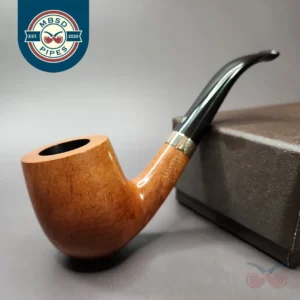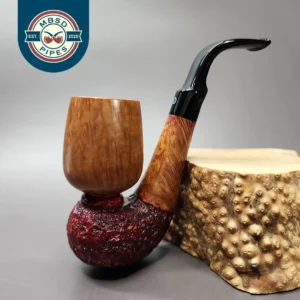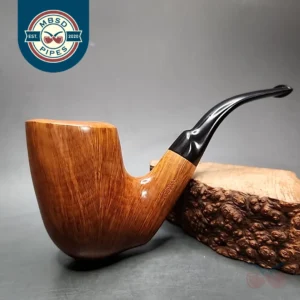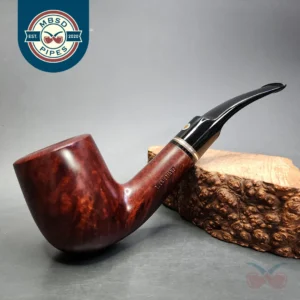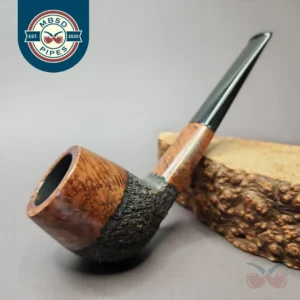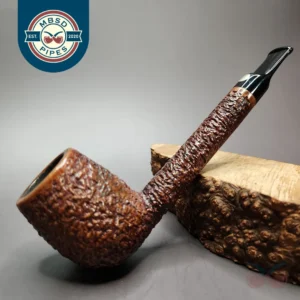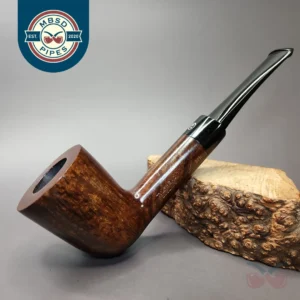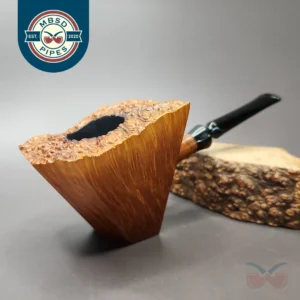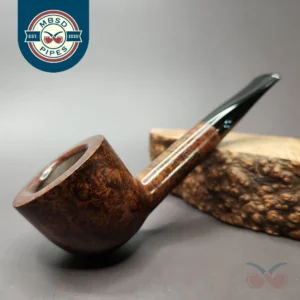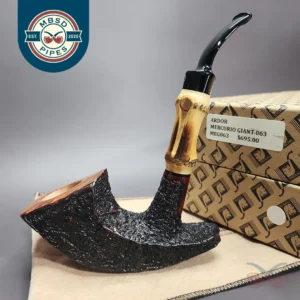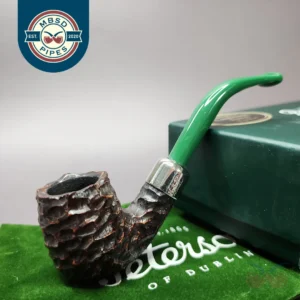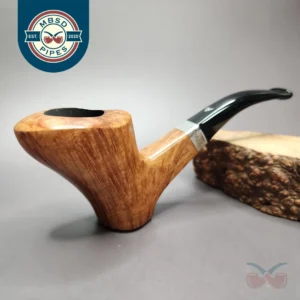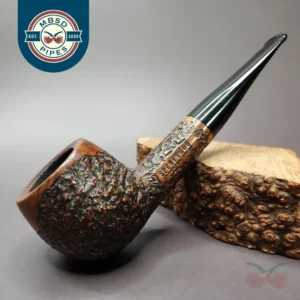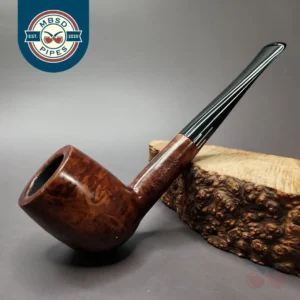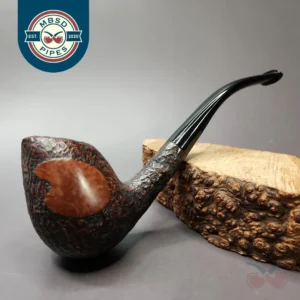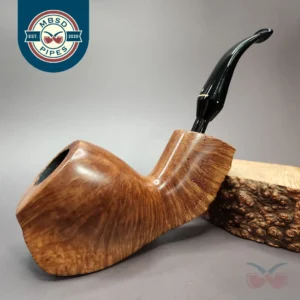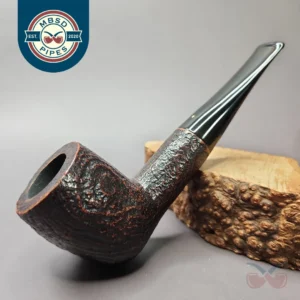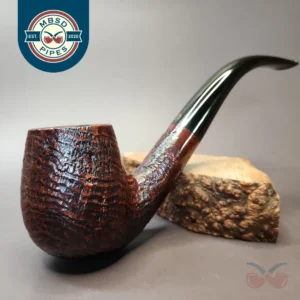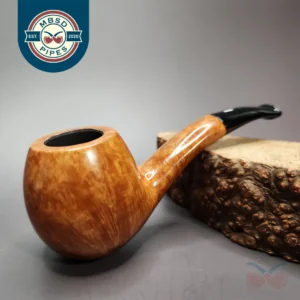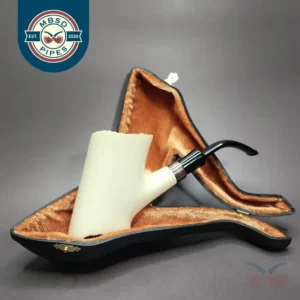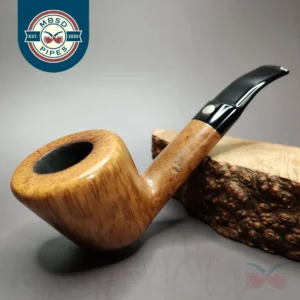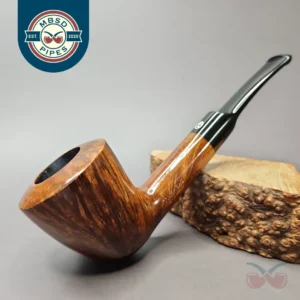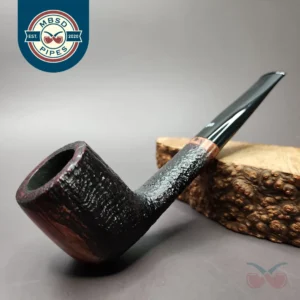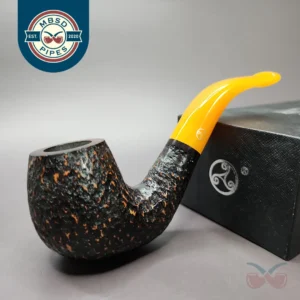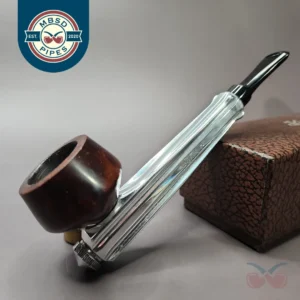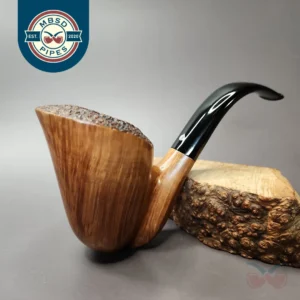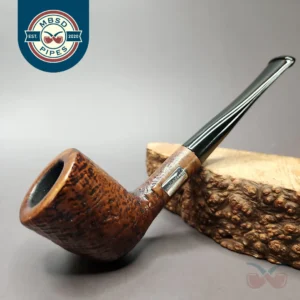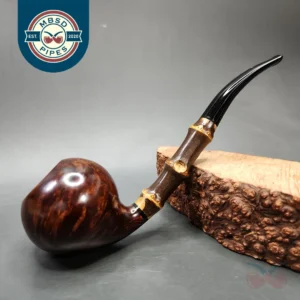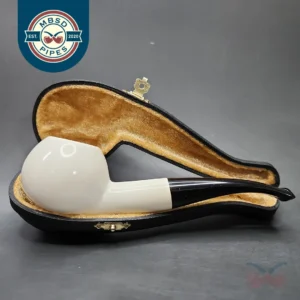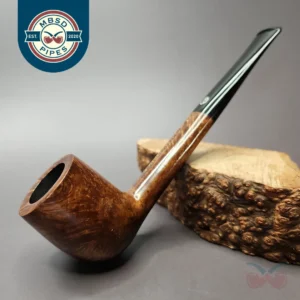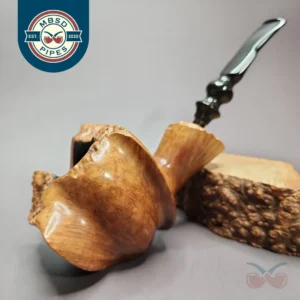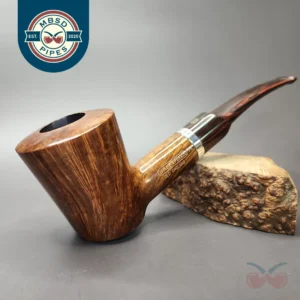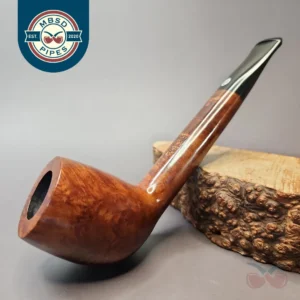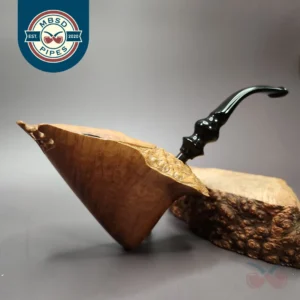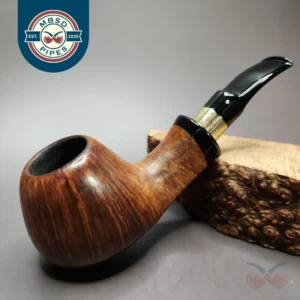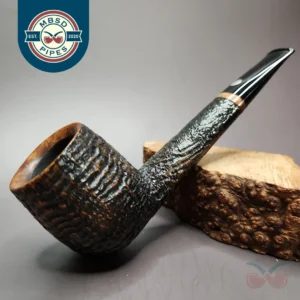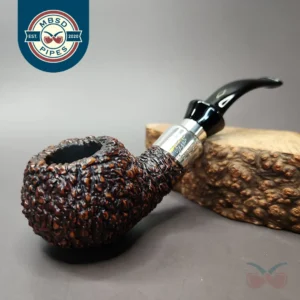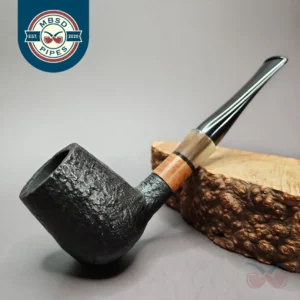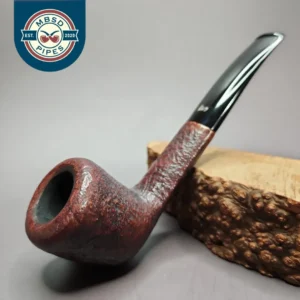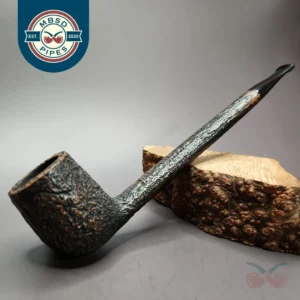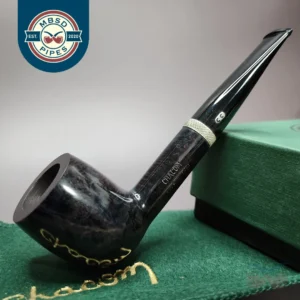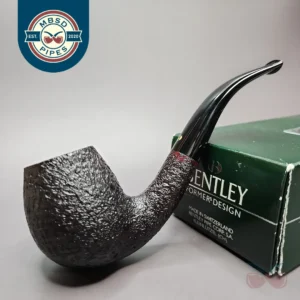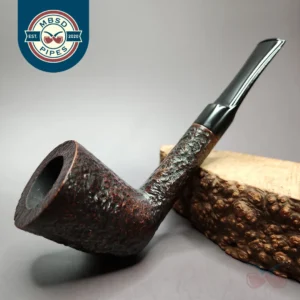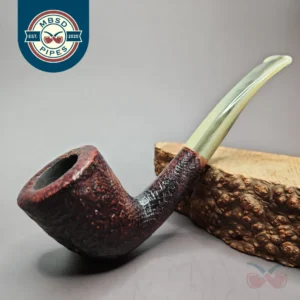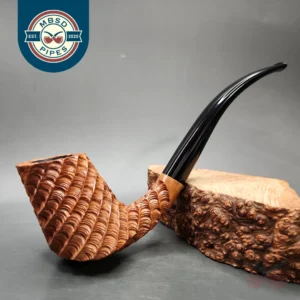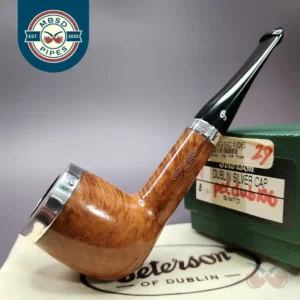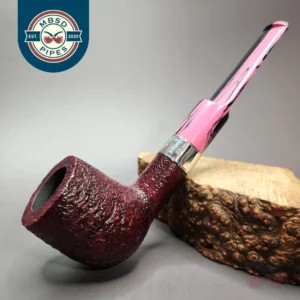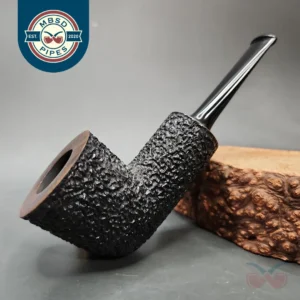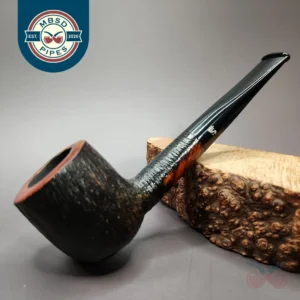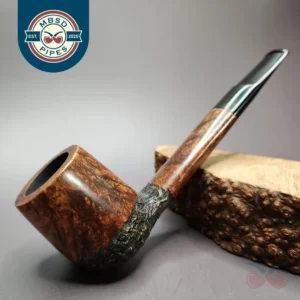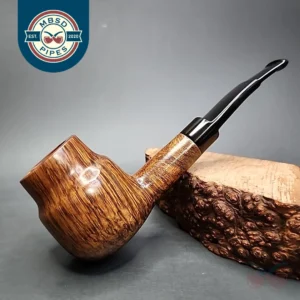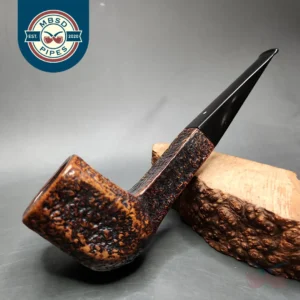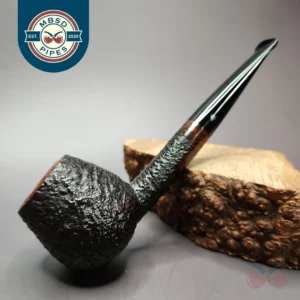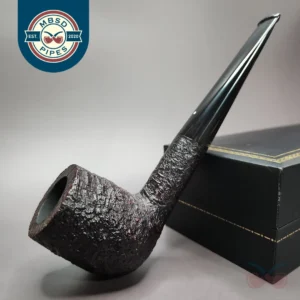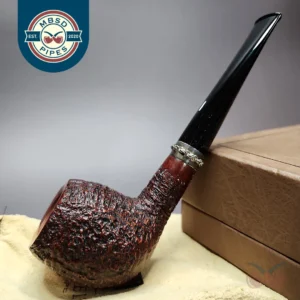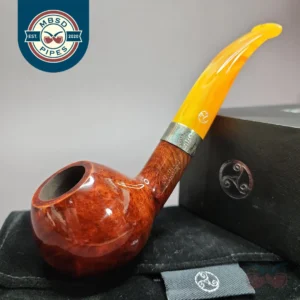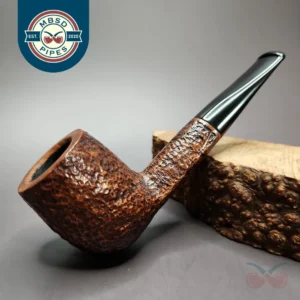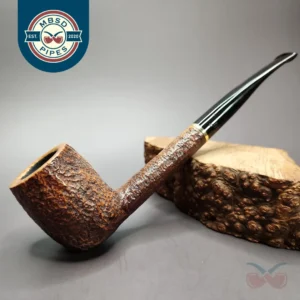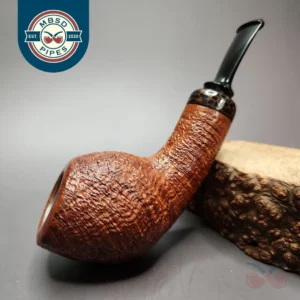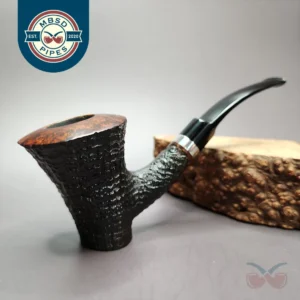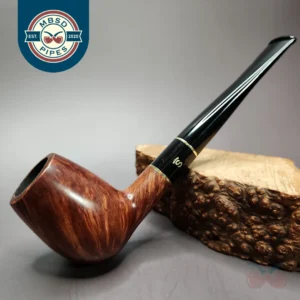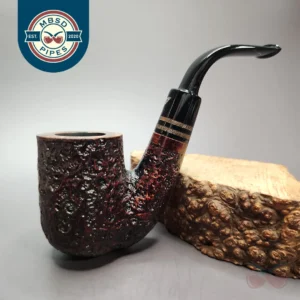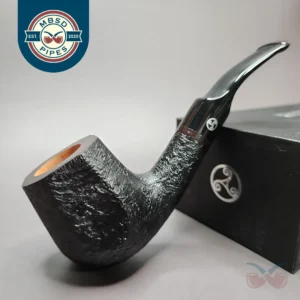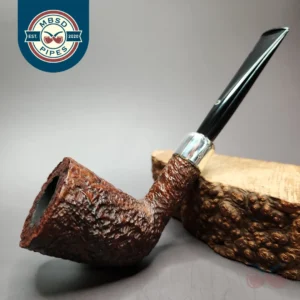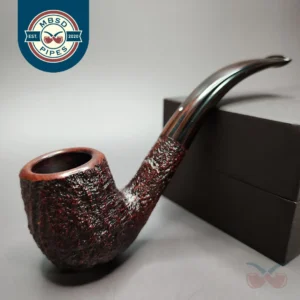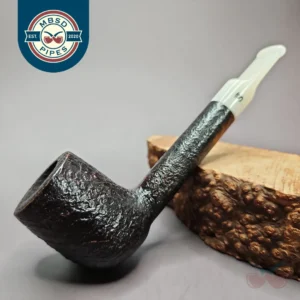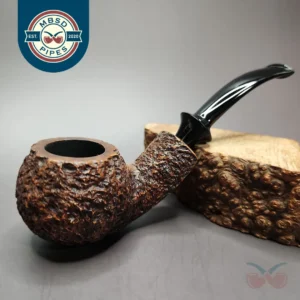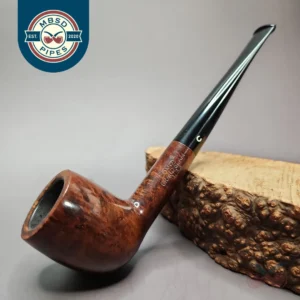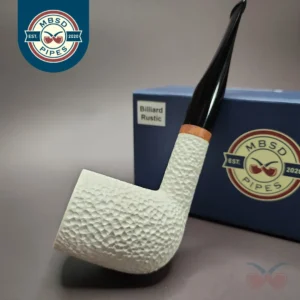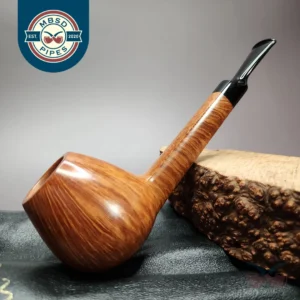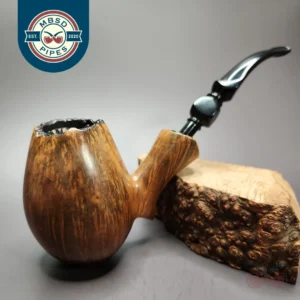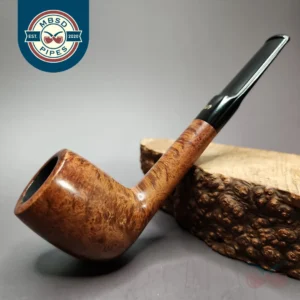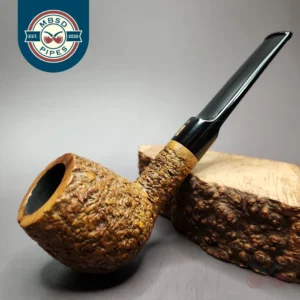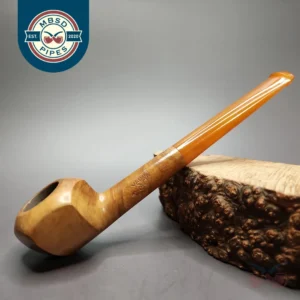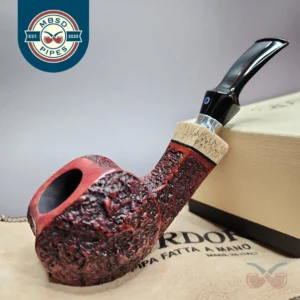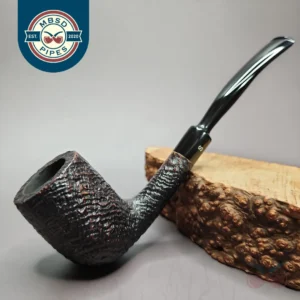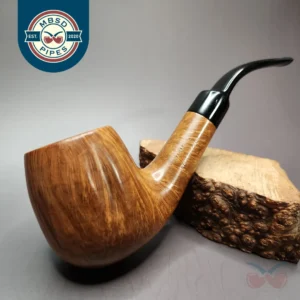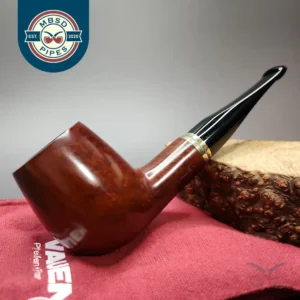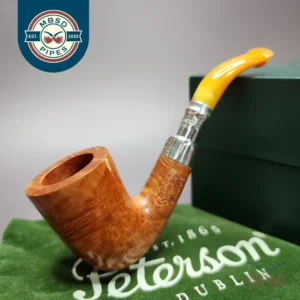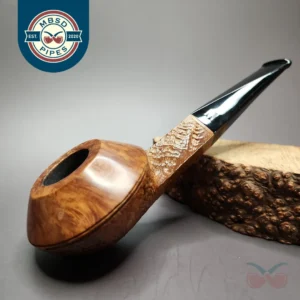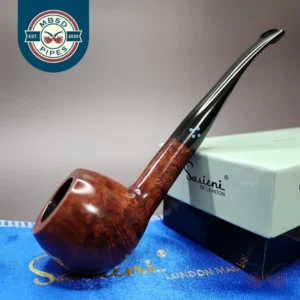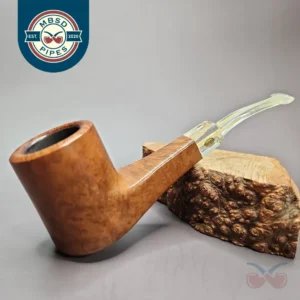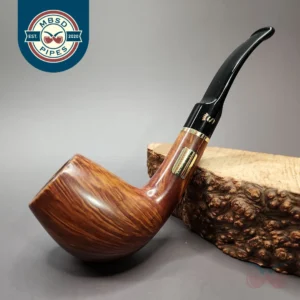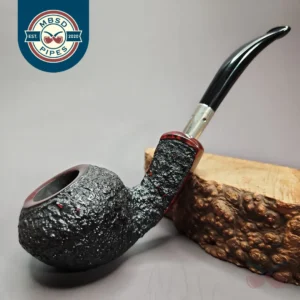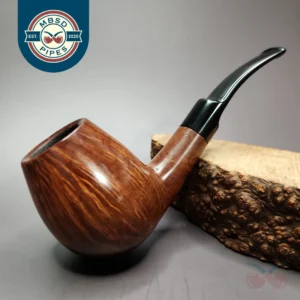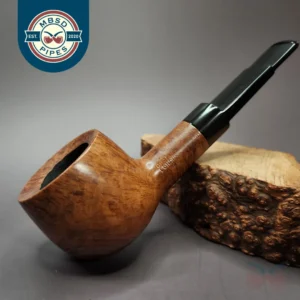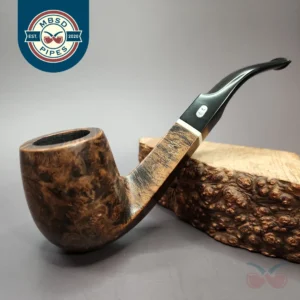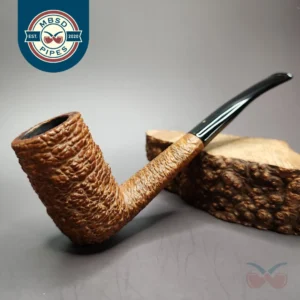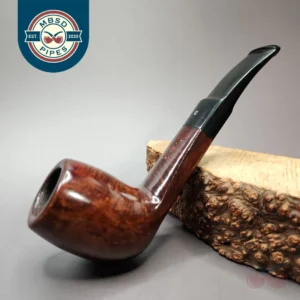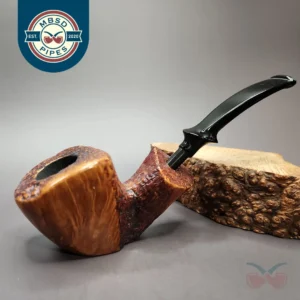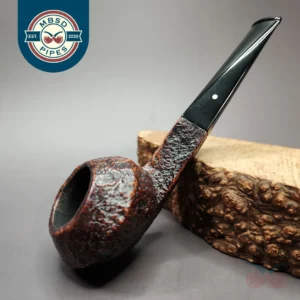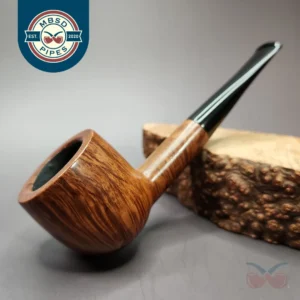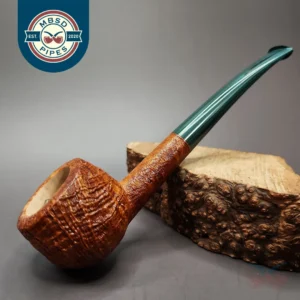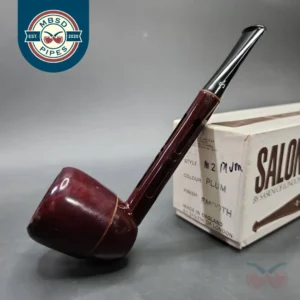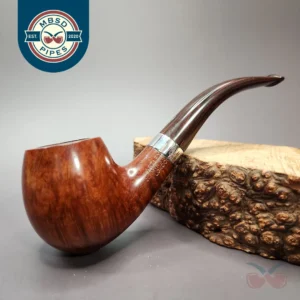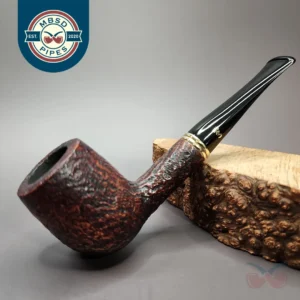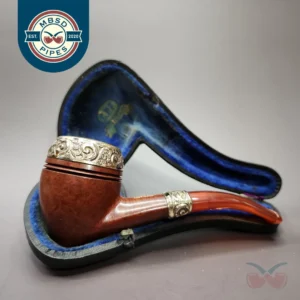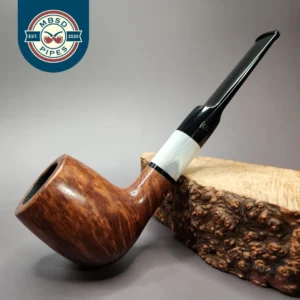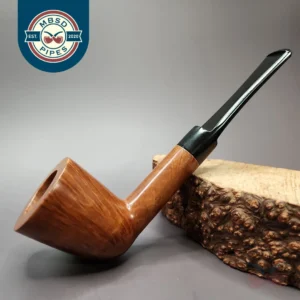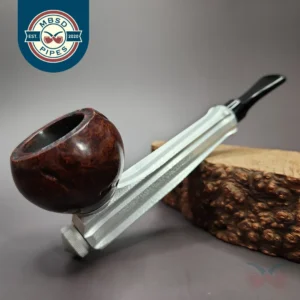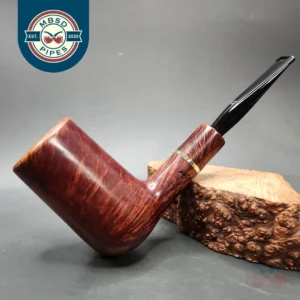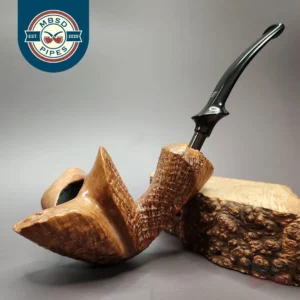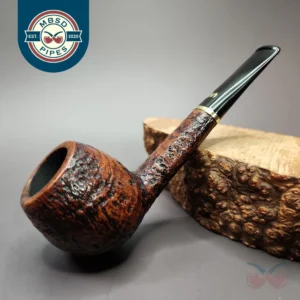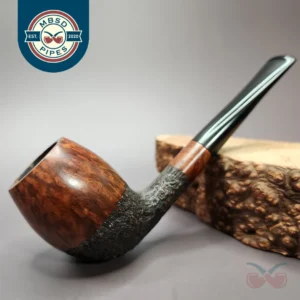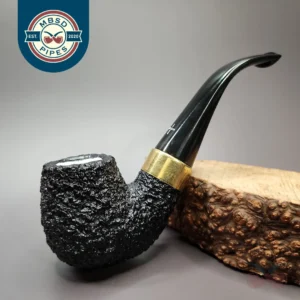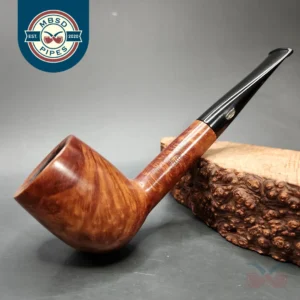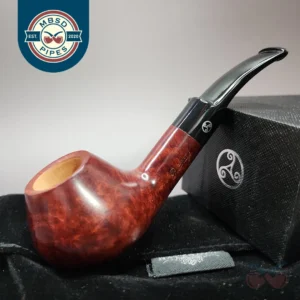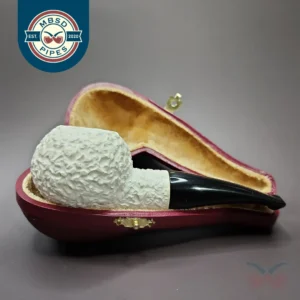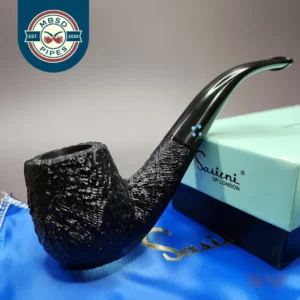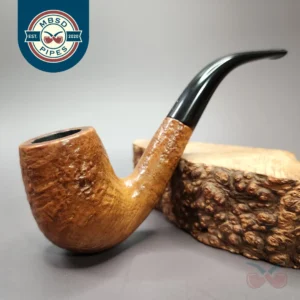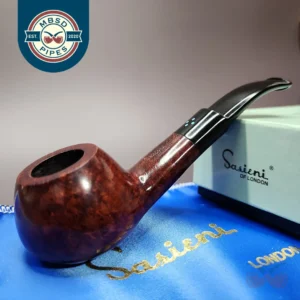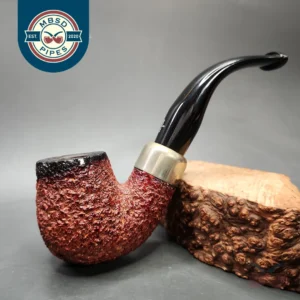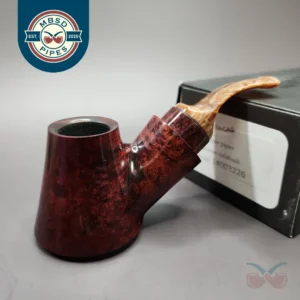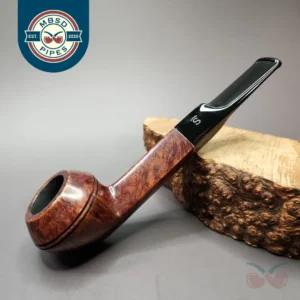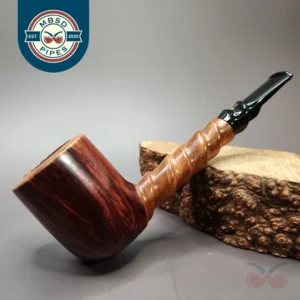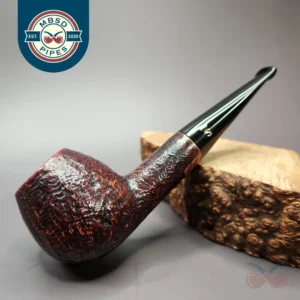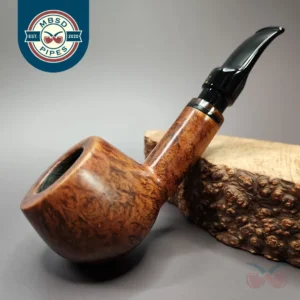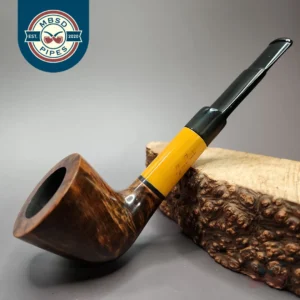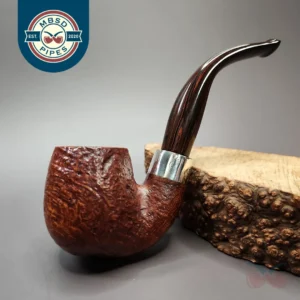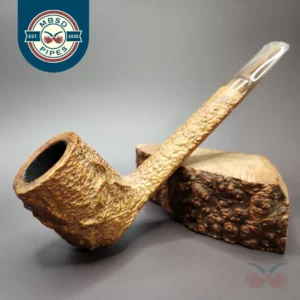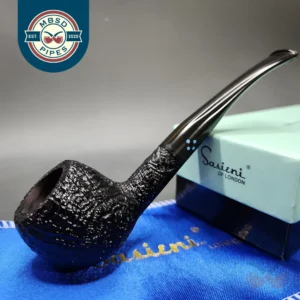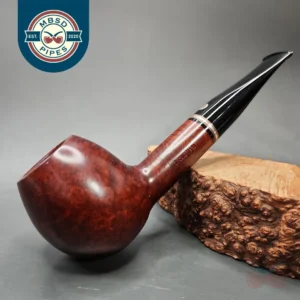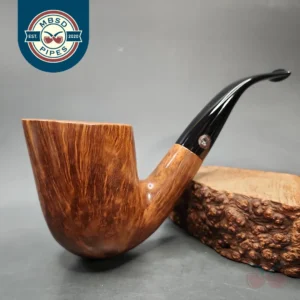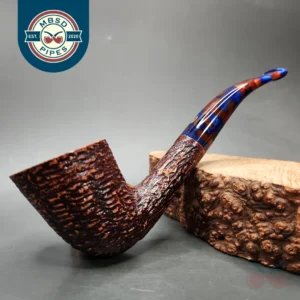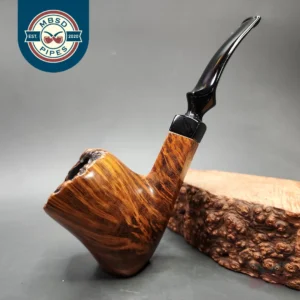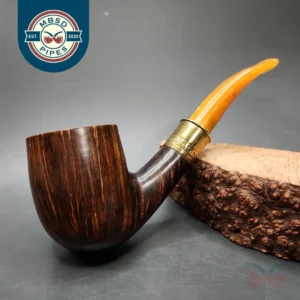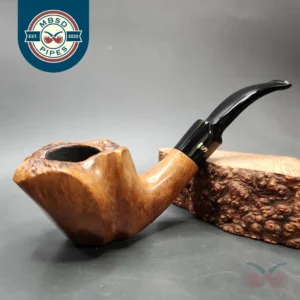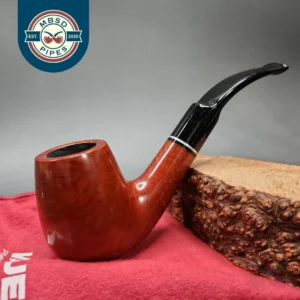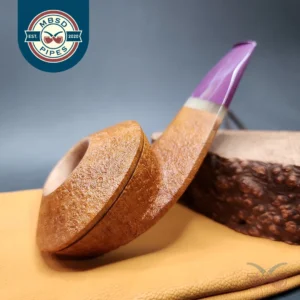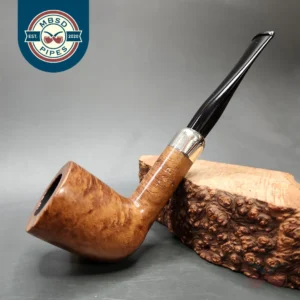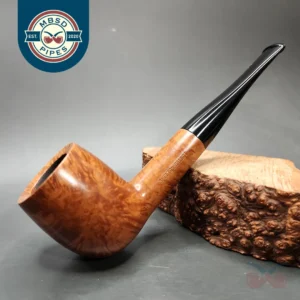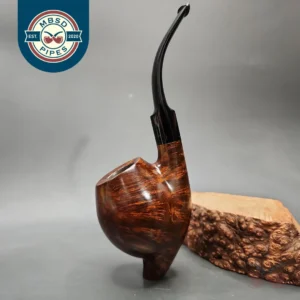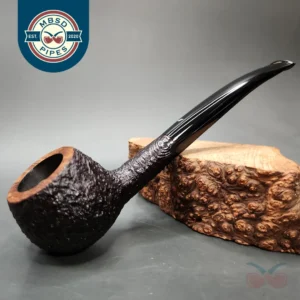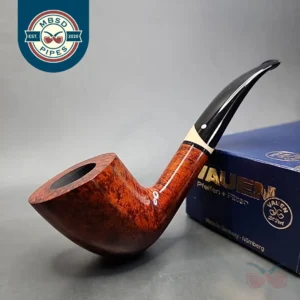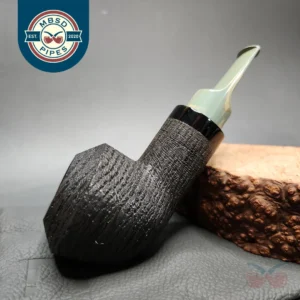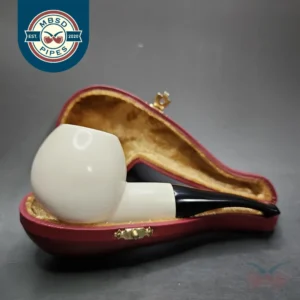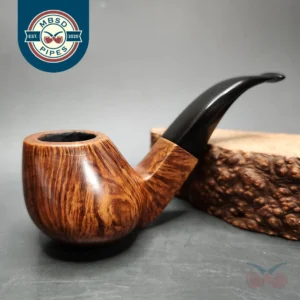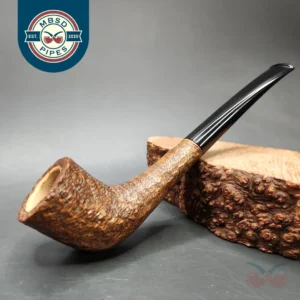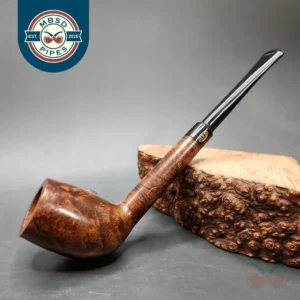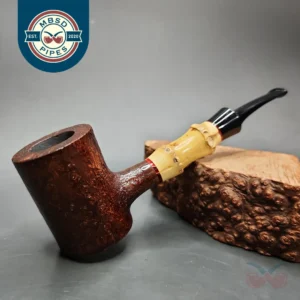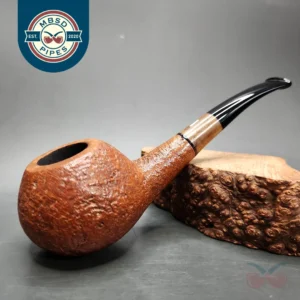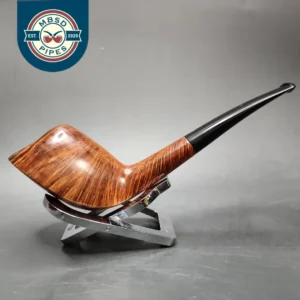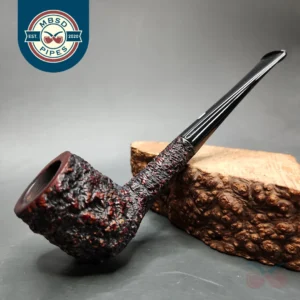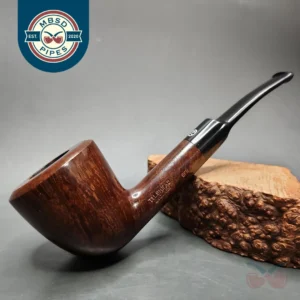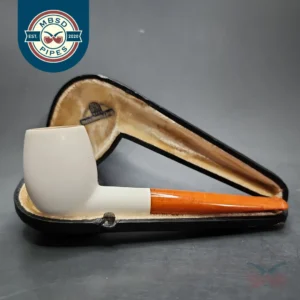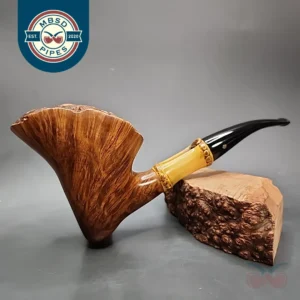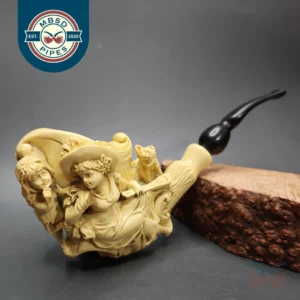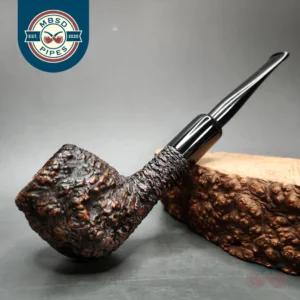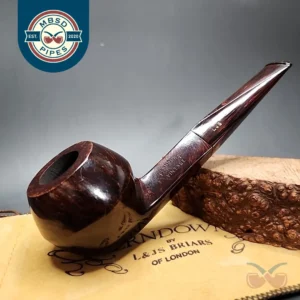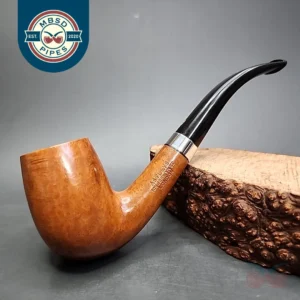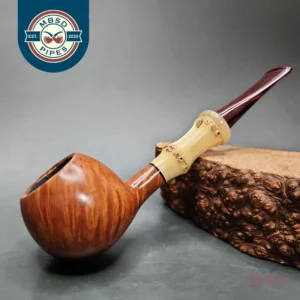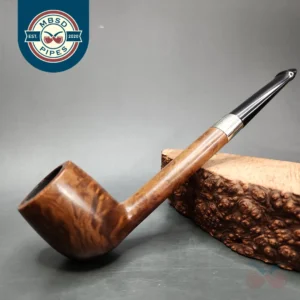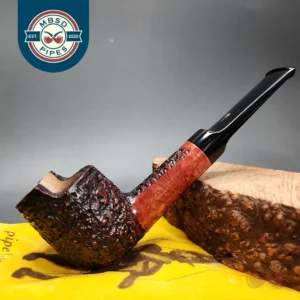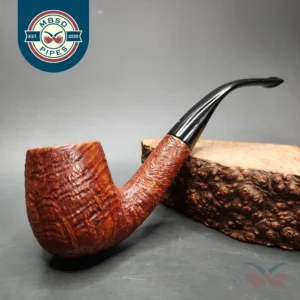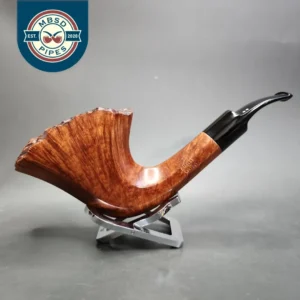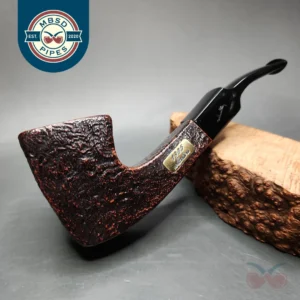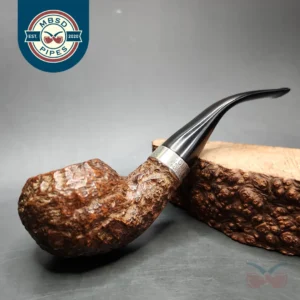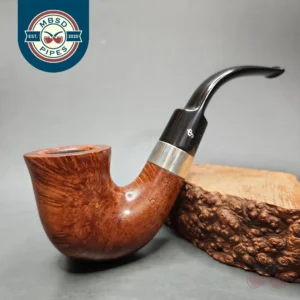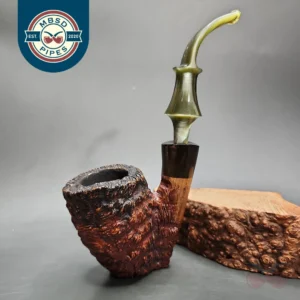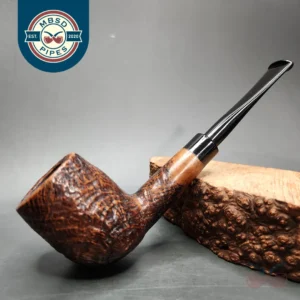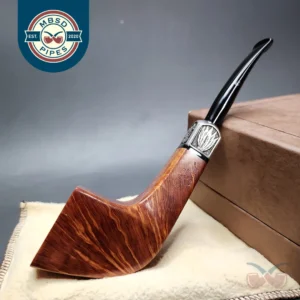Showing 501–1000 of 3444 resultsSorted by latest
-
Michel pipes were store-brand pipes made for Maison Michel, a North Carolina (USA) tobacconist run by Michel J. Mitchell between 1951 and 1980. Over the years, several prominent pipe-makers made pipes for Maison Michel, such as Charatan, Barling, and others. This particular Michel comes from the make’s Natural series, named for its light, almost naked…
-
James Upshall was, along with Ferndown and Ashton, part of a new wave of British hand-made, high-grade pipes in the late 20th century, with their founders largely coming from previous positions in the factories of companies such as Dunhill and Charatan. James Upshall was founded in 1978 by Barry Jones and Ken Barnes, both of…
-
Bjarne Nielsen was one of the towering figures of Danish pipe-making until his passing in 2008. As the founder of Bjarne, Nielsen employed talented pipe-makers from Denmark to produce distinctly Danish pipes and sold them to a devoted international audience. Among those in his employ were figures such as Mogens Johansen (also known as Johs),…
-
James Upshall was, along with Ferndown and Ashton, part of a new wave of British hand-made, high-grade pipes in the late 20th century, with their founders largely coming from previous positions in the factories of companies such as Dunhill and Charatan. James Upshall was founded in 1978 by Barry Jones and Ken Barnes, both of…
-
And now for something completely different… Well, not completely, but it is different. These days, Benson & Hedges is predominantly known for a different kind of nicotine delivery technology but, way back when, the company did dabble in pipes. As far as I know, B&H didn’t manufacture their own pipes, with this being done for them…
-
Much like in Denmark or Japan, many of the great names in Italian artisan pipe-making got their start working for other greats in their famous workshops. This was the case for artisans such as Giancarlo Guidi, Luigi Radice, Sergio Ascorti, and Maurizio Tombari. Luigi Viprati, on the other hand, is one of the few self-taught…
-
Nørding was founded by Erik Nørding in the 1960s, and is one of the oldest remaining companies to come out of the Scandinavian pipe-making renaissance that began in the mid-20th century. Now in his 80s, Erik Nørding is one of the most experienced and skilled pipe-makers in the world, and over the decades he has…
-
Though he would tragically pass away at the age of 42, Preben Holm was one of the pioneering figures in the ‘Danish design’ movement in 20th century pipe-making – a movement that still dominates the high-grade pipe scene. By hand-shaping his pipes on a belt sander, Holm was able to make the most of the…
-
The House of Rattray was originally a tobacconist, opening in Perth, Scotland, in 1903, under the oversight of Charles Rattray. House of Rattray soon became a blending house (whose blends are still sold to this day under the Rattray’s name) and a purveyor of Rattray-brand pipes, made for the tobacconist by established English pipe makers….
-
Stanwell is one of Denmark’s most celebrated and enduring pipe companies, having been founded by Poul Nielsen shortly after the second world war. Over the last six decades, Stanwell has established itself as both a leader in innovative Danish design and for producing well-priced pipes with precision construction and engineering. Many of its designs were…
-
Though this particular pipe is unstamped, I was reliably informed that it was made by Neal Monier. Neal is an excellent pipe-maker, and a real cult favorite, with his style tending toward simpler, more affordable pieces that are nonetheless expertly handmade. This one is a nice, wide pot, which should make it perfect for mixture…
-
Michel pipes were store-brand pipes made for Maison Michel, a North Carolina (USA) tobacconist run by Michel J. Mitchell between 1951 and 1980. Over the years, several prominent pipe-makers made pipes for Maison Michel, such as Charatan, Barling, and others. While the pipes we’ve had come in from Maison Michel have all been very traditional…
-
James Upshall was, along with Ferndown and Ashton, part of a new wave of British hand-made, high-grade pipes in the late 20th century, with their founders largely coming from previous positions in the factories of companies such as Dunhill and Charatan. James Upshall was founded in 1978 by Barry Jones and Ken Barnes, both of…
-
To veteran pipe smokers, Dunhill needs no introduction. Beginning in 1907, Alfred Dunhill began selling Dunhill pipes at the tobacconist shop he owned on London’s Duke Street. Very quickly, these pipes gained the reputation of being the ‘Rolls-Royce’ of pipes due to how expertly crafted they were. Today, Dunhill is likely Britain’s most famous pipe…
-
Il Ceppo is an Italian brand that has been producing high-grade pipes since the 1970s. Founded by the architect Giorgio Imperatori in Pesaro, Italy, Il Ceppo is a central figure in what has been called the Pesaro School of pipe design, along with other companies such as Ser Jacopo and Mastro de Paja. Everyone knows…
-
Stanwell is one of Denmark’s most celebrated and enduring pipe companies, having been founded by Poul Nielsen shortly after the second world war. Over the last six decades, Stanwell has established itself as both a leader in innovative Danish design and for producing well-priced pipes with precision construction and engineering. Many of its designs were…
-
Michel pipes were store-brand pipes made for Maison Michel, a North Carolina (USA) tobacconist run by Michel J. Mitchell between 1951 and 1980. Over the years, several prominent pipe-makers made pipes for Maison Michel. Of all of the pipes that have come through over the years, Michel is one brand that has surprised me the…
-
Peterson pipes generally need no introduction, but just in case you’re unfamiliar: in 1876, a Latvian named Charles Peterson immigrated to Ireland and was hired making pipes in a workshop owned by Frederick and George Kapp. After rising through the ranks to become head craftsman, Peterson bought into the Kapp’s business, which was renamed, Kapp…
-
Nørding was founded by Erik Nørding in the 1960s, and is one of the oldest remaining companies to come out of the Scandinavian pipe-making renaissance that began in the mid-20th century. Now in his 80s, Erik Nørding is one of the most experienced and skilled pipe-makers in the world, and over the decades he has…
-
Bjarne Nielsen was one of the towering figures of Danish pipe-making until his passing in 2008. As the founder of Bjarne, Nielsen employed talented pipe-makers from Denmark to produce distinctly Danish pipes and sold them to a devoted international audience. Among those in his employ were figures such as Mogens Johansen (also known as Johs),…
-
Custom-Bilt (later, as in this case, Custombilt) pipes were originally created in the early 20th century by Tracy Mincer, an American pipe-maker. Later adopting the slogan, ‘As Individual as a Thumbprint,’ Custom-Bilts were each rusticated by hand, giving them their signature rugged look, and ensuring that no two Custom-Bilts were exactly alike. Today, these pipes…
-
Ser Jacopo is one of the most famous contemporary examples of high-grade, workshop-made Italian pipes. It also belongs to a very special tradition in Italian pipe-making, having been established by Giancarlo Guidi and Bruno Sordini after the two had left another great Italian workshop, Mastro de Paja. Together, Guidi and Sordini created a brand of…
-
‘BBB’ originally stood for ‘Blumfeld’s Best Briars’, so named after Louis Blumfeld after he took over the historic Alfred Frankenau Company in 1856. Later, the pipes came to be known as ‘Britain’s Best Briars’. Though the name might have changed, the quality of the pipes did not – they really were fantastic pipes, made in…
-
Ascorti belongs to a historic lineage in Italian artisan pipe-making. Guiseppe ‘Peppino’ Ascorti was first employed as a pipe-maker in the 1950s, in Carlo Scotti’s Castello workshop in Cantu. There he met Luigi Radice, and in the 1960s the two decided to leave Castello to create their own pipe-making workshop, under the name ‘Caminetto.’ At…
-
James Upshall was, along with Ferndown and Ashton, part of a new wave of British hand-made, high-grade pipes in the late 20th century, with their founders largely coming from previous positions in the factories of companies such as Dunhill and Charatan. James Upshall was founded in 1978 by Barry Jones and Ken Barnes, both of…
-
Michel pipes were store-brand pipes made for Maison Michel, a North Carolina (USA) tobacconist run by Michel J. Mitchell between 1951 and 1980. Over the years, several prominent pipe-makers made pipes for Maison Michel, such as Charatan, Barling, and others. Now this is what I’d call a clencher. A good size and bowl capacity, yet…
-
James Upshall was, along with Ferndown and Ashton, part of a new wave of British hand-made, high-grade pipes in the late 20th century, with their founders largely coming from previous positions in the factories of companies such as Dunhill and Charatan. James Upshall was founded in 1978 by Barry Jones and Ken Barnes, both of…
-
James Upshall was, along with Ferndown and Ashton, part of a new wave of British hand-made, high-grade pipes in the late 20th century, with their founders largely coming from previous positions in the factories of companies such as Dunhill and Charatan. James Upshall was founded in 1978 by Barry Jones and Ken Barnes, both of…
-
Like Castello, Mastro de Paja holds a special place in the world of Italian high-grade pipe workshops. Founded in 1972 by Giancarlo Guidi, the MdP team was soon joined by Giannino Spadoni and Bruto Sordini with the Guidi and Spadoni at the helm of the company until 1981. Guidi then left with Sordini to found…
-
Stanwell is one of Denmark’s most celebrated and enduring pipe companies, having been founded by Poul Nielsen shortly after the second world war. Over the last six decades, Stanwell has established itself as both a leader in innovative Danish design and for producing well-priced pipes with precision construction and engineering. Many of its designs were…
-
Much like in Denmark or Japan, many of the great names in Italian artisan pipe-making got their start working for other greats in their famous workshops. This was the case for artisans such as Giancarlo Guidi, Luigi Radice, Sergio Ascorti, and Maurizio Tombari. Luigi Viprati, on the other hand, is one of the few self-taught…
-
Vauen stems from Germany’s oldest tobacco pipe manufacturing company, tracing its roots back to the founding partnership of Karl Ellenberger and Carl August Ziener in Nuremberg, 1848. Out of the Ellenberger-Ziener partnership soon came the Vauen make itself, which grew to become Germany’s largest and most enduring pipe brand – a title that it continues…
-
If you were to ask me how to best describe the pipes of Czech artisan Martin Čermák, I’d probably point to one of his Rhodesian shapes as a good indication. He’s got a real knack for playing with proportions, with this one showing off his predilection for shorter, stubbier designs that nonetheless carry a great…
-
Stanwell is one of Denmark’s most celebrated and enduring pipe companies, having been founded by Poul Nielsen shortly after the second world war. Over the last six decades, Stanwell has established itself as both a leader in innovative Danish design and for producing well-priced pipes with precision construction and engineering. Many of its designs were…
-
Now here is a brand that I haven’t seen in a long time: Sébastien Beo. For those who were not keeping abreast of pipe developments in the early 2010s, Sébastien Beo was a project undertaken by Sébastien Beaud, a French pipe-maker otherwise responsible for the Genod brand. Amidst an ascendant Danish-American hegemony, Sébastien Beo pipes…
-
Verona was a brand of pipes made exclusively for The Tinder box. The Tinder Box itself is a historic North American tobacconist, originally founded in 1928, and over the years, a number of established pipe manufacturers have produced pipes for The Tinder Box house-brand, including Ascorti, Charatan, Nording, and Savinelli. For their Verona pipes, manufacture…
-
Gigi pipes occupy an interesting position in the history of Italian pipe-making. The story begins with the founding of Sociedade Rovera, a pipe-making company in Varese, Italy, by the Rovera family. As members of the Rovera family left to start their own ventures, the dynasty associated with the name would be split into several companies;…
-
While China has long been associated with cheaper factory pipes, a new generation of artisans and workshops have emerged over the past decade, producing some genuinely excellent pipes. HS Studio is an example of the latter, being a Hong Kong workshop dedicated to crafting handmade briars, typically in shapes and styles reminiscent of the post-war…
-
Vauen stems from Germany’s oldest tobacco pipe manufacturing company, tracing its roots back to the founding partnership of Karl Ellenberger and Carl August Ziener in Nuremberg, 1848. Out of the Ellenberger-Ziener partnership soon came the Vauen make itself, which grew to become Germany’s largest and most enduring pipe brand – a title that it continues…
-
Founded in 1947 by Carlo Scotti, Castello quickly became known for producing some of the finest smoking pipes in the world. Over the years, the people involved in making Castello pipes has changed – such as Luigi Radice and Sergio Ascorti, who developed their skills in the Cantu workshop before leaving to start Caminetto, or…
-
Michel pipes were store-brand pipes made for Maison Michel, a North Carolina (USA) tobacconist run by Michel J. Mitchell between 1951 and 1980. Over the years, several prominent pipe-makers made pipes for Maison Michel. Of all of the pipes that have come through over the years, Michel is one brand that has surprised me the…
-
It is probably fair to say that Savinelli is Italy’s most famous pipe brand. Founded in Milan in 1876 by Achille Savinelli, the brand has continuously offered high quality pipes for nearly 150 years. Though various Savinelli lines have come and gone over the years, the brand has always been notable for putting out classically…
-
James Upshall was, along with Ferndown and Ashton, part of a new wave of British hand-made, high-grade pipes in the late 20th century, with their founders largely coming from previous positions in the factories of companies such as Dunhill and Charatan. James Upshall was founded in 1978 by Barry Jones and Ken Barnes, both of…
-
Much like in Denmark or Japan, many of the great names in Italian artisan pipe-making got their start working for other greats in their famous workshops. This was the case for artisans such as Giancarlo Guidi, Luigi Radice, Sergio Ascorti, and Maurizio Tombari. Luigi Viprati, on the other hand, is one of the few self-taught…
-
Though he would tragically pass away at the age of 42, Preben Holm was one of the pioneering figures in the ‘Danish design’ movement in 20th century pipe-making – a movement that still dominates the high-grade pipe scene. By hand-shaping his pipes on a belt sander, Holm was able to make the most of the…
-
Stanwell is one of Denmark’s most celebrated and enduring pipe companies, having been founded by Poul Nielsen shortly after the second world war. Over the last six decades, Stanwell has established itself as both a leader in innovative Danish design and for producing well-priced pipes with precision construction and engineering. Many of its designs were…
-
James Upshall was, along with Ferndown and Ashton, part of a new wave of British hand-made, high-grade pipes in the late 20th century, with their founders largely coming from previous positions in the factories of companies such as Dunhill and Charatan. James Upshall was founded in 1978 by Barry Jones and Ken Barnes, both of…
-
Astleys was one of London’s historic pipe and tobacco shops. Like many pipe tobacconists, its owners had pipes made specially to be sold under the shop’s name. Astleys pipes, however, were made by some of the premier pipe manufacturers and artisans in the UK, such as Dunhill, Charatan, Les Wood and Dolly Wood of Ferndown,…
-
Gigi pipes occupy an interesting position in the history of Italian pipe-making. The story begins with the founding of Sociedade Rovera, a pipe-making company in Varese, Italy, by the Rovera family. As members of the Rovera family left to start their own ventures, the dynasty associated with the name would be split into several companies;…
-
Alongside Julius Vesz, Phillip Trypis, and John Calich, Blatter is one of the pre-eminent names within the history of Canadian handmade pipes. But it is the Blatter name that has thus far endured for the longest time within that history. This is because the Blatter family have been in the business of making and selling…
-
Much like in Denmark or Japan, many of the great names in Italian artisan pipe-making got their start working for other greats in their famous workshops. This was the case for artisans such as Giancarlo Guidi, Luigi Radice, Sergio Ascorti, and Maurizio Tombari. Luigi Viprati, on the other hand, is one of the few self-taught…
-
Astleys was one of London’s most historic pipe and tobacco shops. Like many pipe tobacconists, its owners had pipes made specially to be sold under the shop’s name. Astleys pipes, however, were made by some of the premier pipe manufacturers and artisans in the UK, such as Dunhill, Charatan, Les Wood, and Ken Barnes and…
-
Like Castello, Mastro de Paja holds a special place in the world of Italian high-grade pipe workshops. Founded in 1972 by Giancarlo Guidi, the MdP team was soon joined by Giannino Spadoni and Bruto Sordini with the Guidi and Spadoni at the helm of the company until 1981. Guidi then left with Sordini to found…
-
Astleys was one of London’s most historic pipe and tobacco shops. Like many pipe tobacconists, its owners had pipes made specially to be sold under the shop’s name. Astleys pipes, however, were made by some of the premier pipe manufacturers and artisans in the UK, such as Dunhill, Charatan, Les Wood and Dolly Wood of…
-
WO Larsen was a tobacconist in Copenhagen Denmark. In the 1960s, when Danish-style pipes were becoming highly sought after, thanks to revolutionary pipe-makers such as Sixten Ivarsson, a workshop was set up on the Larsen premises to produce enough high-grade Danish pipes to meet demand. This workshop was staffed by the emerging masters of Danish…
-
Stanwell is one of Denmark’s most celebrated and enduring pipe companies, having been founded by Poul Nielsen shortly after the second world war. Over the last six decades, Stanwell has established itself as both a leader in innovative Danish design and for producing well-priced pipes with precision construction and engineering. Many of its designs were…
-
Much like in Denmark or Japan, many of the great names in Italian artisan pipe-making got their start working for other greats in their famous workshops. This was the case for artisans such as Giancarlo Guidi, Luigi Radice, Sergio Ascorti, and Maurizio Tombari. Luigi Viprati, on the other hand, is one of the few self-taught…
-
Schulte’s was an American pipe tobacconist, located in New Jersey in the second half of the 20th century. Like many pipe stores, Schulte’s sold house brand pipes, but unlike most pipe stores, many of these house brand pipes were made by the store’s owner, Max Schulte. Similarly to a few other American pipe tobacconists, like…
-
When Paul Perri passed away in 2021, at the ripe old age of 101, he established a record that I don’t think will be broken any time soon: he had, to paraphrase Marty Pulvers, “been making pipes for 95 years.” Obviously, Perri started young and hit the ground running, having been born to a father…
-
Along with names like Barling, Charatan, and Dunhill Sasieni holds a special place in the history of English smoking pipes – one near to its very beginnings. So the story goes, Sasieni himself worked for Dunhill during its early days. But eventually he left Dunhill, having his own ideas about how pipes should be made,…
-
Vauen stems from Germany’s oldest tobacco pipe manufacturing company, tracing its roots back to the founding partnership of Karl Ellenberger and Carl August Ziener in Nuremberg, 1848. Out of the Ellenberger-Ziener partnership soon came the Vauen make itself, which grew to become Germany’s largest and most enduring pipe brand – a title that it continues…
-
Astleys was one of London’s most historic pipe and tobacco shops. Like many pipe tobacconists, its owners had pipes made specially to be sold under the shop’s name. Astleys pipes, however, were made by some of the premier pipe manufacturers and artisans in the UK, such as Dunhill, Charatan, Les Wood and Dolly Wood of…
-
To veteran pipe smokers, Dunhill needs no introduction. Beginning in 1907, Alfred Dunhill began selling Dunhill pipes at the tobacconist shop he owned on London’s Duke Street. Very quickly, these pipes gained the reputation of being the ‘Rolls-Royce’ of pipes due to how expertly crafted they were. Today, Dunhill is likely Britain’s most famous pipe…
-
Like Castello, Mastro de Paja holds a special place in the world of Italian high-grade pipe workshops. Founded in 1972 by Giancarlo Guidi, the MdP team was soon joined by Giannino Spadoni and Bruto Sordini with the Guidi and Spadoni at the helm of the company until 1981. Guidi then left with Sordini to found…
-
While China has long been associated with cheaper factory pipes, a new generation of artisans and workshops have emerged over the past decade, producing some genuinely excellent pipes. HS Studio is an example of the latter, being a Hong Kong workshop dedicated to crafting handmade briars, typically in shapes and styles reminiscent of the post-war…
-
Ashton is an English pipe brand created by William Ashton Taylor, a former Dunhill pipe-maker who left Dunhill in the 1980s to make pipes under his own name. Along with other pipe-makers such as Ken Barnes and Barry Jones of James Upshall and Les Wood of Ferndown, Ashton emerged as part of a new wave…
-
WO Larsen was a tobacconist in Copenhagen Denmark. In the 1960s, when Danish-style pipes were becoming highly sought after, thanks to revolutionary pipe-makers such as Sixten Ivarsson, a workshop was set up on the Larsen premises to produce enough high-grade Danish pipes to meet demand. This workshop was staffed by the emerging masters of Danish…
-
Schulte’s was an American pipe tobacconist, located in New Jersey in the second half of the 20th century. Like many pipe stores, Schulte’s sold house brand pipes, but unlike most pipe stores, many of these house brand pipes were made by the store’s owner, Max Schulte. Similarly to a few other American pipe tobacconists, like…
-
Stanwell is one of Denmark’s most celebrated and enduring pipe companies, having been founded by Poul Nielsen shortly after the second world war. Over the last six decades, Stanwell has established itself as both a leader in innovative Danish design and for producing well-priced pipes with precision construction and engineering. Many of its designs were…
-
Tsuge is Japan’s largest and most internationally renowned pipe company, having been founded in 1936 by Kyoichiro Tsuge. In the 1970s, however, Tsuge himself was so impressed by the pipes coming out of Denmark, that he sent two of Tsuge’s own master pipe-makers, Kazuhiro Fukuda and Smio Satou, to hone their craft under the likes…
-
Caminetto was, and is to this day, a decisive figure in the history of Italy’s pipe workshop tradition. After spending time developing their skills in the Castello workshop, Guiseppe Ascorti and Luigi Radice left to found their own venture, which they named, ‘Caminetto.’ Here, Ascorti and Radice were able to create their own now-classic shapes…
-
Like Castello, Mastro de Paja holds a special place in the world of Italian high-grade pipe workshops. Founded in 1972 by Giancarlo Guidi, the MdP team was soon joined by Giannino Spadoni and Bruto Sordini with the Guidi and Spadoni at the helm of the company until 1981. Guidi then left with Sordini to found…
-
James Upshall was, along with Ferndown and Ashton, part of a new wave of British hand-made, high-grade pipes in the late 20th century, with their founders largely coming from previous positions in the factories of companies such as Dunhill and Charatan. James Upshall was founded in 1978 by Barry Jones and Ken Barnes, both of…
-
In 1974, after growing impatient waiting for a pipe he’d ordered, Claudio Cavicchi decided he would simply make his own pipe instead. The former farmer from Bologna, Italy, spent the next 15 years making pipes, until his work took off and received widespread acclaim. Cavicchi’s pipe-making exploits have only become more renowned in the decades…
-
Though this particular pipe is unstamped, I was reliably informed that it was made by Neal Monier. Neal is an excellent pipe-maker, and a real cult favorite, with his style tending toward simpler, more affordable pieces that are nonetheless expertly handmade. This one is a nice, wide pot, which should make it perfect for mixture…
-
Radice is one of the great Italian workshop pipe makes, belonging to a historic lineage of such workshops. The company began as a family affair, being established in 1980 by Luigi Radice, along with his son, Gianluca, and father, Paolo. But Radice’s pipe-making ‘family’ is a little larger than that. Prior to founding Radice, Luigi…
-
Schulte’s was an American pipe tobacconist, located in New Jersey in the second half of the 20th century. Like many pipe stores, Schulte’s sold house brand pipes, but unlike most pipe stores, many of these house brand pipes were made by the store’s owner, Max Schulte. Similarly to a few other American pipe tobacconists, like…
-
I’ve been wondering when we might get one of these come through. For those not in the know, Smith House Pipes are made by American artisan Rich Rosselli, in his workshop in Long Island, New York. His designs tend to lean toward the functionalist school, but are distinguished by their explorations of novel color palettes….
-
Vauen stems from Germany’s oldest tobacco pipe manufacturing company, tracing its roots back to the founding partnership of Karl Ellenberger and Carl August Ziener in Nuremberg, 1848. Out of the Ellenberger-Ziener partnership soon came the Vauen make itself, which grew to become Germany’s largest and most enduring pipe brand – a title that it continues…
-
To veteran pipe smokers, Dunhill needs no introduction. Beginning in 1907, Alfred Dunhill began selling Dunhill pipes at the tobacconist shop he owned on London’s Duke Street. Very quickly, these pipes gained the reputation of being the ‘Rolls-Royce’ of pipes due to how expertly crafted they were. Today, Dunhill is likely Britain’s most famous pipe…
-
Ichi Kitahara is a Japanese pipe-maker, but he’s also something of a renaissance man. He is classically trained in fine art; he has spent time as a high-end jeweler and silversmith; he has also worked as an Itame, the Japanese name for a particularly skilled sushi chef; and last, but not least, he is an artisan…
-
GBD was one of several prominent examples of a French pipe brand that, due to certain circumstances, became a maker most associated with classic ‘British’ pipes. Founded in 1850 by the French trio Ganneval, Bondier & Donninger, the brand was bought by English company Oppenheimer at the beginning of the 20th century, who opened factories…
-
Ser Jacopo is one of the most famous contemporary example of high-grade, workshop-made Italian pipes. It also belongs to a very special tradition in Italian pipe-making, having been established by Giancarlo Guidi and Bruno Sordini after the two had left another great Italian workshop, Mastro de Paja. Together, Guidi and Sordini created a brand of…
-
The 21st century has seen an explosion of new pipe-makers on the international artisan scene, one that, as of yet, shows no sign of stopping. But there is one artisan among them whose successes and impact on pipes writ large are so far unrivaled by any of his contemporaries. This would be Todd Johnson. Following…
-
Vauen stems from Germany’s oldest tobacco pipe manufacturing company, tracing its roots back to the founding partnership of Karl Ellenberger and Carl August Ziener in Nuremberg, 1848. Out of the Ellenberger-Ziener partnership soon came the Vauen make itself, which grew to become Germany’s largest and most enduring pipe brand – a title that it continues…
-
Stanwell is one of Denmark’s most celebrated and enduring pipe companies, having been founded by Poul Nielsen shortly after the second world war. Over the last six decades, Stanwell has established itself as both a leader in innovative Danish design and for producing well-priced pipes with precision construction and engineering. Many of its designs were…
-
Clarence Mickles was a pipe-maker from Illinois, Chicago, and something of a legend within the North American pipe scene. Before making pipes, Mickles was an auto mechanic, which is one reason why he was affectionately known as the ‘Mechanic.’ The other reason is that he was a supremely gifted pipe repairman, in addition to being…
-
WO Larsen was a tobacconist in Copenhagen Denmark. In the 1960s, when Danish-style pipes were becoming highly sought after, thanks to revolutionary pipe-makers such as Sixten Ivarsson, a workshop was set up on the Larsen premises to produce enough high-grade Danish pipes to meet demand. This workshop was staffed by the emerging masters of Danish…
-
Age (or rather, Åge) Bogelund is a somewhat less known carver from the 20th century Danish pipe-making tradition – though he was no less a master than his contemporaries. Originally, he worked for Viggo Nielsen’s Bari pipe company, being charged with making some of its higher-grade freehands. Later, Bogelund made pipes under his own name,…
-
Astleys was one of London’s most historic pipe and tobacco shops. Like many pipe tobacconists, its owners had pipes made specially to be sold under the shop’s name. Astleys pipes, however, were made by some of the premier pipe manufacturers and artisans in the UK, such as Dunhill, Charatan, Les Wood, and Ken Barnes and…
-
Like many Italian workshop brands, Ardor pipes are a family affair. The name itself is an acronym of Angelo Rovera and Dorelio Rovera, father and son pipe-makers who created the brand in 1972. The Rovera family’s history with pipes goes back much further, however, as Angelo’s own father, Francesco, had previously established the Sociedade Rovera…
-
It is probably fair to say that Savinelli is Italy’s most famous pipe brand. Founded in Milan in 1876 by Achille Savinelli, the brand has continuously offered high quality pipes for nearly 150 years. Though various Savinelli lines have come and gone over the years, the brand has always been notable for putting out classically…
-
While originally born in Italy, Thomas Cristiano emigrated to the United States at the age of 16, quickly finding work in the S.M. Frank factory in Long Island. S.M. Frank is a historic American pipe-making company, and at this time Cristiano worked on Frank-owned makes such as Kaywoodie. Later, Cristiano departed to make his own…
-
WO Larsen was a tobacconist in Copenhagen Denmark. In the 1960s, when Danish-style pipes were becoming highly sought after, thanks to revolutionary pipe-makers such as Sixten Ivarsson, a workshop was set up on the Larsen premises to produce enough high-grade Danish pipes to meet demand. This workshop was staffed by the emerging masters of Danish…
-
While China has long been associated with cheaper factory pipes, a new generation of artisans and workshops have emerged over the past decade, producing some genuinely excellent pipes. HS Studio is an example of the latter, being a Hong Kong workshop dedicated to crafting handmade briars, typically in shapes and styles reminiscent of the post-war…
-
KB&B, or Kaufmann Bros & Bondy, was an American pipe company established in the mid-19th century, most famous today for having created Kaywoodie. The company originally made pipes under the KB&B name, but their innovative designs and patents soon led them to market several makes under the KB&B umbrella, including Kaywoodie, Yello-Bole, and CPF. Though…
-
Like Castello, Mastro de Paja holds a special place in the world of Italian high-grade pipe workshops. Founded in 1972 by Giancarlo Guidi, the MdP team was soon joined by Giannino Spadoni and Bruto Sordini with the Guidi and Spadoni at the helm of the company until 1981. Guidi then left with Sordini to found…
-
James Upshall was, along with Ferndown and Ashton, part of a new wave of British hand-made, high-grade pipes in the late 20th century, with their founders largely coming from previous positions in the factories of companies such as Dunhill and Charatan. James Upshall was founded in 1978 by Barry Jones and Ken Barnes, both of…
-
WO Larsen was a historic tobacconist in Copenhagen Denmark. In the 1960s, when Danish-style pipes were becoming highly sought after, thanks to revolutionary pipe-makers such as Sixten Ivarsson, a workshop was set up on the Larsen premises to produce enough high-grade Danish pipes to meet demand. This workshop was staffed by the emerging masters of…
-
Along with names like Barling, Charatan, and Dunhill Sasieni holds a special place in the history of English smoking pipes – one near to its very beginnings. So the story goes, Sasieni himself worked for Dunhill during its early days. But eventually he left Dunhill, having his own ideas about how pipes should be made,…
-
Like many Italian workshop brands, Ardor pipes are a family affair. The name itself is an acronym of Angelo Rovera and Dorelio Rovera, father and son pipe-makers who created the brand in 1972. The Rovera family’s history with pipes goes back much further, however, as Angelo’s own father, Francesco, had previously established the Sociedade Rovera…
-
Peterson pipes generally need no introduction, but just in case you’re unfamiliar: in 1876, a Latvian named Charles Peterson immigrated to Ireland and was hired making pipes in a workshop owned by Frederick and George Kapp. After rising through the ranks to become head craftsman, Peterson bought into the Kapp’s business, which was renamed, Kapp…
-
Much like in Denmark or Japan, many of the great names in Italian artisan pipe-making got their start working for other greats in their famous workshops. This was the case for artisans such as Giancarlo Guidi, Luigi Radice, Sergio Ascorti, and Maurizio Tombari. Luigi Viprati, on the other hand, is one of the few self-taught…
-
The Sportsman is a make that has largely been lost to time—as is the fate of many makes. These pipes were produced around the mid-20th century and distributed by John Hudson Moore, Inc., an American company that distributed other classic 20th century makes, such as Sasieni. This particular Sportsman is a classic apple shape, which…
-
Comoy’s is a historic brand in pipe making, and possibly the most historic brand in the making of briar pipes. Though originally founded in 1825 by a French family from Saint Claude, France, production of Comoy’s pipes was soon moved to London, England, where it established itself as one of the quintessential English pipe companies….
-
James Upshall was, along with Ferndown and Ashton, part of a new wave of British hand-made, high-grade pipes in the late 20th century, with their founders largely coming from previous positions in the factories of companies such as Dunhill and Charatan. James Upshall was founded in 1978 by Barry Jones and Ken Barnes, both of…
-
Royal Danish was a sub-brand of Denmark’s Stanwell company. Using the same shapes as the main Stanwell line, Royal Danish is now a great way for customers to get their hands on iconic Danish pipes that are no longer manufactured by Stanwell or by any of its sub-brands. What’s more, Stanwell sub-brands were of a…
-
Pipa Croci are made by Italian artisans Paolo Croci and Gianni Croci. The two are based in Lombardy, where they have crafted handmade pipes since 1983—hence why all Croci pipes are stamped “dal 1983.” This particular Croci is from Paolo & Gianni’s more freeform “Artistica” collection, a name which seems highly appropriate. Moving away from…
-
It is probably fair to say that Savinelli is Italy’s most famous pipe brand. Founded in Milan in 1876 by Achille Savinelli, the brand has continuously offered high quality pipes for nearly 150 years. Though various Savinelli lines have come and gone over the years, the brand has always been notable for putting out classically…
-
Nørding was founded by Erik Nørding in the 1960s, and is one of the oldest remaining companies to come out of the Scandinavian pipe-making renaissance that began in the mid-20th century. Now in his 80s, Erik Nørding is one of the most experienced and skilled pipe-makers in the world, and over the decades he has…
-
James Upshall was, along with Ferndown and Ashton, part of a new wave of British hand-made, high-grade pipes in the late 20th century, with their founders largely coming from previous positions in the factories of companies such as Dunhill and Charatan. James Upshall was founded in 1978 by Barry Jones and Ken Barnes, both of…
-
Founded in 1947 by Carlo Scotti, Castello quickly became known for producing some of the finest smoking pipes in the world. Over the years, the people involved in making Castello pipes has changed – such as Luigi Radice and Sergio Ascorti, who developed their skills in the Cantu workshop before leaving to start Caminetto, or…
-
Though I’m not sure of the maker, I’m quite impressed with this magnum-sized, army mount meerschaum pipe. The design is a highly unorthodox one for meerschaums, being reminiscent not of typical Turkish shapes but of Danish and American freehands. In fact, it reminds me a little of the very early WO Larsen freehands carved by…
-
Like Castello, Mastro de Paja holds a special place in the world of Italian high-grade pipe workshops. Founded in 1972 by Giancarlo Guidi, the MdP team was soon joined by Giannino Spadoni and Bruto Sordini with the Guidi and Spadoni at the helm of the company until 1981. Guidi then left with Sordini to found…
-
James Upshall was, along with Ferndown and Ashton, part of a new wave of British hand-made, high-grade pipes in the late 20th century, with their founders largely coming from previous positions in the factories of companies such as Dunhill and Charatan. James Upshall was founded in 1978 by Barry Jones and Ken Barnes, both of…
-
Stanwell is one of Denmark’s most celebrated and enduring pipe companies, having been founded by Poul Nielsen shortly after the second world war. Over the last six decades, Stanwell has established itself as both a leader in innovative Danish design and for producing well-priced pipes with precision construction and engineering. Many of its designs were…
-
The House of Rattray was originally a tobacconist, opening in Perth, Scotland, in 1903, under the oversight of Charles Rattray. House of Rattray soon became a blending house (whose blends are still sold to this day under the Rattray’s name) and a purveyor of Rattray-brand pipes, made for the tobacconist by established English pipe makers….
-
Kirsten pipes were originally the creation of Frederik K. Kirsten. A man who immigrated to America at the turn of the century and became a professor of aeronautical engineering, Kirsten’s invention, debuting in 1936, belongs to a category of pipes now known as “metal” pipes, or “metal frame” pipes. As the term suggests, these pipes,…
-
Bellissima pipes were made by Italy’s L’Anatra workshop exclusively for American tobacconist The Tinder Box. L’Anatra itself is one of the high end Italian makes to have emerged as part of the “Pesaro School,” so named after a region which has produced a close network of artisans and workshops offering some of the finest pipes…
-
Stanwell is one of Denmark’s most celebrated and enduring pipe companies, having been founded by Poul Nielsen shortly after the second world war. Over the last six decades, Stanwell has established itself as both a leader in innovative Danish design and for producing well-priced pipes with precision construction and engineering. Many of its designs were…
-
While China has long been associated with cheaper factory pipes, a new generation of artisans and workshops have emerged over the past decade, producing some genuinely excellent pipes. HS Studio is an example of the latter, being a Hong Kong workshop dedicated to crafting handmade briars, typically in shapes and styles reminiscent of the post-war…
-
Though I’m not sure who made it, I’ve a strong suspicion that this particular meerschaum had a very specific inspiration for its design: the “320” shape made by Savinelli. Like the 320, it is a distinctly chubby author shape, with this one also having the advantage of being able to nicely color over time. This…
-
James Upshall was, along with Ferndown and Ashton, part of a new wave of British hand-made, high-grade pipes in the late 20th century, with their founders largely coming from previous positions in the factories of companies such as Dunhill and Charatan. James Upshall was founded in 1978 by Barry Jones and Ken Barnes, both of…
-
J. Andrew Kovacs was an American artisan from Arizona. Working mostly in the late 20th century, Kovacs was part of the great American freehand scene, ultimately passing on his knowledge of pipe-making to later figures such as Horace DeJarnett. The last J. Andrew pipe we had in seemed to lean more toward the Italian freehand…
-
James Upshall was, along with Ferndown and Ashton, part of a new wave of British hand-made, high-grade pipes in the late 20th century, with their founders largely coming from previous positions in the factories of companies such as Dunhill and Charatan. James Upshall was founded in 1978 by Barry Jones and Ken Barnes, both of…
-
James Upshall was, along with Ferndown and Ashton, part of a new wave of British hand-made, high-grade pipes in the late 20th century, with their founders largely coming from previous positions in the factories of companies such as Dunhill and Charatan. James Upshall was founded in 1978 by Barry Jones and Ken Barnes, both of…
-
J. Andrew Kovacs was an American artisan from Arizona. Working mostly in the late 20th century, Kovacs was part of the great American freehand scene, ultimately passing on his knowledge of pipe-making to later figures such as Horace DeJarnett. This particular J. Andrew is a classic of the freehand genre: the fan. It’s a shape…
-
As is often the case with the greats of Danish pipe-making, the story of Poul Winsløw begins as one of a master and an apprentice. That master was none other than Preben Holm; the apprentice was a young Winsløw. Holm held Winsløw in especial regard, with the latter ending up as the former’s head assistant…
-
Like Castello, Mastro de Paja holds a special place in the world of Italian high-grade pipe workshops. Founded in 1972 by Giancarlo Guidi, the MdP team was soon joined by Giannino Spadoni and Bruto Sordini with the Guidi and Spadoni at the helm of the company until 1981. Guidi then left with Sordini to found…
-
Named for the company’s home township, Brebbia was founded in 1953 by Enea Buzzi, an alum of Savinelli’s manufacturing division. Still in operation 70 years later, Brebbia is one of Italy’s oldest extant pipe companies, with production still being undertaken using simple lathes and traditional methods of hand finishing. More recently, Brebbia has also collaborated…
-
WO Larsen was a tobacconist in Copenhagen Denmark. In the 1960s, when Danish-style pipes were becoming highly sought after, thanks to revolutionary pipe-makers such as Sixten Ivarsson, a workshop was set up on the Larsen premises to produce enough high-grade Danish pipes to meet demand. This workshop was staffed by the emerging masters of Danish…
-
Stanwell is one of Denmark’s most celebrated and enduring pipe companies, having been founded by Poul Nielsen shortly after the second world war. Over the last six decades, Stanwell has established itself as both a leader in innovative Danish design and for producing well-priced pipes with precision construction and engineering. Many of its designs were…
-
Michel pipes were store-brand pipes made for Maison Michel, a North Carolina (USA) tobacconist run by Michel J. Mitchell between 1951 and 1980. Over the years, several prominent pipe-makers made pipes for Maison Michel, such as Charatan, Barling, and others. Now this is what I’d call a clencher. A good size and bowl capacity, yet…
-
Trey Rice’s journey into becoming a pipe-maker began in 2009, progressing in parallel to his undergraduate and graduate studies in architecture. As a result, Rice has an acute sense of form and function, which he has himself partly credited to his studies and work as an architect. He has a broad range of influences, from…
-
Sasieni always had particularly exacting standards for its pipes, even within the English pipe scene, so when a bowl was found to have even the tiniest, superficial imperfection, the bowl would be used for one of Sasieni’s many sub-brands. This pipe is one such example. While with many Sasieni sub-brands it is relatively easy to…
-
Ascorti belongs to a historic lineage in Italian artisan pipe-making. Guiseppe ‘Peppino’ Ascorti was first employed as a pipe-maker in the 1950s, in Carlo Scotti’s Castello workshop in Cantu. There he met Luigi Radice, and in the 1960s the two decided to leave Castello to create their own pipe-making workshop, under the name ‘Caminetto.’ At…
-
Chacom is one of France’s most historic and iconic makes. Its founders, the Comoy family, began their career as boxwood pipe-makers in the early 1800s, before briar had even been discovered, with Henri Comoy (of Comoy’s fame) emigrating to England in 1879 and founding the country’s first briar pipe factory. In 1922, Henri and his…
-
If you’re familiar with high-grade pipes – especially those from Denmark – you’ll likely have at least heard of Hans “Former” Nielsen. Former began his career, aged 15, repairing pipes for Poul Rasmussen at Suhr’s Pibemageri. Later, Former was referred to the W.O. Larsen workshop by Rasmussen, where – after an examination by Sven Knudsen,…
-
It is probably fair to say that Savinelli is Italy’s most famous pipe brand. Founded in Milan in 1876 by Achille Savinelli, the brand has continuously offered high quality pipes for nearly 150 years. Though various Savinelli lines have come and gone over the years, the brand has always been notable for putting out classically…
-
Orlik was an English pipe manufacturer founded in 1899 by Louis Orlik. While originally the company’s mission was to produce low-cost pipes, the make would ultimately be known for the distinctly high quality of their products. Consequently, Orlik pipes are today a favorite among pipe smokers and collectors, especially those who prefer the hobby’s Great…
-
Schulte’s was an American pipe tobacconist, located in New Jersey in the second half of the 20th century. Like many pipe stores, Schulte’s sold house brand pipes, but unlike most pipe stores, many of these house brand pipes were made by the store’s owner, Max Schulte. Similarly to a few other American pipe tobacconists, like…
-
Stanwell is one of Denmark’s most celebrated and enduring pipe companies, having been founded by Poul Nielsen shortly after the second world war. Over the last six decades, Stanwell has established itself as both a leader in innovative Danish design and for producing well-priced pipes with precision construction and engineering. Many of its designs were…
-
Peterson pipes generally need no introduction, but just in case you’re unfamiliar: in 1876, a Latvian named Charles Peterson immigrated to Ireland and was hired making pipes in a workshop owned by Frederick and George Kapp. After rising through the ranks to become head craftsman, Peterson bought into the Kapp’s business, which was renamed, Kapp…
-
While China has long been associated with cheaper factory pipes, a new generation of artisans and workshops have emerged over the past decade, producing some genuinely excellent pipes. HS Studio is an example of the latter, being a Hong Kong workshop dedicated to crafting handmade briars, typically in shapes and styles reminiscent of the post-war…
-
Peterson pipes generally need no introduction, but just in case you’re unfamiliar: in 1876, a Latvian named Charles Peterson immigrated to Ireland and was hired making pipes in a workshop owned by Frederick and George Kapp. After rising through the ranks to become head craftsman, Peterson bought into the Kapp’s business, which was renamed, Kapp…
-
Ashton is an English pipe brand created by William Ashton Taylor, a former Dunhill pipe-maker who left Dunhill in the 1980s to make pipes under his own name. Along with other pipe-makers such as Ken Barnes and Barry Jones of James Upshall and Les Wood of Ferndown, Ashton emerged as part of a new wave…
-
GBD was one of several prominent examples of a French pipe brand that, due to certain circumstances, became a maker most associated with classic ‘British’ pipes. Founded in 1850 by the French trio Ganneval, Bondier & Donninger, the brand was bought by English company Oppenheimer at the beginning of the 20th century, who opened factories…
-
Greek artisan Kostas Anastasopoulos was first drawn to pipe-making by a desire to modernize its forms, and thereby to create something more fitting for pipe smokers of his own generation. He first trained with fellow Greek master Kostas Gourvelos, before making a pilgrimage to Denmark, where he spent time further honing his skills under Tom…
-
Stanwell is one of Denmark’s most celebrated and enduring pipe companies, having been founded by Poul Nielsen shortly after the second world war. Over the last six decades, Stanwell has established itself as both a leader in innovative Danish design and for producing well-priced pipes with precision construction and engineering. Many of its designs were…
-
WO Larsen was a tobacconist in Copenhagen Denmark. In the 1960s, when Danish-style pipes were becoming highly sought after, thanks to revolutionary pipe-makers such as Sixten Ivarsson, a workshop was set up on the Larsen premises to produce enough high-grade Danish pipes to meet demand. This workshop was staffed by the emerging masters of Danish…
-
It is probably fair to say that Savinelli is Italy’s most famous pipe brand. Founded in Milan in 1876 by Achille Savinelli, the brand has continuously offered high quality pipes for nearly 150 years. Though various Savinelli lines have come and gone over the years, the brand has always been notable for putting out classically…
-
Tsuge is Japan’s largest and most internationally renowned pipe company, having been founded in 1936 by Kyoichiro Tsuge. In the 1970s, however, Tsuge was so impressed by the pipes coming out of Denmark, that he sent two of Tsuge’s own master pipe-makers, Kazuhiro Fukuda and Smio Satou, to hone their craft under the likes of…
-
GBD was one of several prominent examples of a French pipe brand that, due to certain circumstances, became a maker most associated with classic ‘British’ pipes. Founded in 1850 by the French trio Ganneval, Bondier & Donninger, the brand was bought by English company Oppenheimer at the beginning of the 20th century, who opened factories…
-
While Dunhill may be Britain’s most famous pipe brand, Charatan is not only older, but has the honor of being the first to have made its pipes entirely in-house. ‘Charatan’s Make’ referred to the fact that, at a time when other pipe companies were sourcing stummels and stems carved from other companies before assembling them…
-
While Dunhill may be Britain’s most famous pipe brand, Charatan is not only older, but has the honor of being the first to have made its pipes entirely in-house. ‘Charatan’s Make’ referred to the fact that, at a time when other pipe companies were sourcing stummels and stems carved from other companies before assembling them…
-
To veteran pipe smokers, Dunhill needs no introduction. Beginning in 1907, Alfred Dunhill began selling Dunhill pipes at the tobacconist shop he owned on London’s Duke Street. Very quickly, these pipes gained the reputation of being the ‘Rolls-Royce’ of pipes due to how expertly crafted they were. Today, Dunhill is likely Britain’s most famous pipe…
-
Astleys was one of London’s most historic pipe and tobacco shops. Like many pipe tobacconists, its owners had pipes made specially to be sold under the shop’s name. Astleys pipes, however, were made by some of the premier pipe manufacturers and artisans in the UK, such as Dunhill, Charatan, Les Wood, and Ken Barnes and…
-
Along with figures such as Hans ‘Former’ Nielsen, Anne Julie, and Tom Eltang, Kurt Balleby Hansen is one of the living legends of Danish pipe-making. Balleby celebrated his 40th year in the craft in 2023, having first started as an apprentice to Kai Nielsen and Preben Holm. Owing to a highly selective approach to the…
-
To veteran pipe smokers, Dunhill needs no introduction. Beginning in 1907, Alfred Dunhill began selling Dunhill pipes at the tobacconist shop he owned on London’s Duke Street. Very quickly, these pipes gained the reputation of being the ‘Rolls-Royce’ of pipes due to how expertly crafted they were. Today, Dunhill is likely Britain’s most famous pipe…
-
Founded in 1947 by Carlo Scotti, Castello quickly became known for producing some of the finest smoking pipes in the world. Over the years, the people involved in making Castello pipes has changed – such as Luigi Radice and Sergio Ascorti, who developed their skills in the Cantu workshop before leaving to start Caminetto, or…
-
The House of Rattray was originally a tobacconist, opening in Perth, Scotland, in 1903, under the oversight of Charles Rattray. House of Rattray soon became a blending house (whose blends are still sold to this day under the Rattray’s name) and a purveyor of Rattray-brand pipes, made for the tobacconist by established English pipe makers….
-
It is probably fair to say that Savinelli is Italy’s most famous pipe brand. Founded in Milan in 1876 by Achille Savinelli, the brand has continuously offered high quality pipes for nearly 150 years. Though various Savinelli lines have come and gone over the years, the brand has always been notable for putting out classically…
-
It is probably fair to say that Savinelli is Italy’s most famous pipe brand. Founded in Milan in 1876 by Achille Savinelli, the brand has continuously offered high quality pipes for nearly 150 years. Though various Savinelli lines have come and gone over the years, the brand has always been notable for putting out classically…
-
Sale!
Beginning his career as an apprentice to master Vladimir Grechukhin in the early 2000s, Alexander Tupitsyn quickly rose to becoming one of the preeminent members of the “St Petersburg school” of pipe-making. Along with Sergey Dyomin (another former Grechukhin apprentice), Tupitsyn and Grechukhin are responsible for PS Studio, a laboratory where the three experiment and…
-
In the world of pipes, Tom Eltang needs no introduction. I will, however, give one anyway, if just as a reminder. Eltang made his first pipe from a Pipe-Dan hobby kit at the age of 11. At age 16, he apprenticed under the legendary Anne Julie, before moving on to work for Pipe-Dan three years…
-
Stanwell is one of Denmark’s most celebrated and enduring pipe companies, having been founded by Poul Nielsen shortly after the second world war. Over the last six decades, Stanwell has established itself as both a leader in innovative Danish design and for producing well-priced pipes with precision construction and engineering. Many of its designs were…
-
Sale!
Much like in Denmark or Japan, many of the great names in Italian artisan pipe-making got their start working for other greats in their famous workshops. This was the case for artisans such as Giancarlo Guidi, Luigi Radice, Sergio Ascorti, and Maurizio Tombari. Luigi Viprati, on the other hand, is one of the few self-taught…
-
The House of Rattray was originally a tobacconist, opening in Perth, Scotland, in 1903, under the oversight of Charles Rattray. House of Rattray soon became a blending house (whose blends are still sold to this day under the Rattray’s name) and a purveyor of Rattray-brand pipes, made for the tobacconist by established English pipe makers….
-
Ashton is an English pipe brand created by William Ashton Taylor, a former Dunhill pipe-maker who left Dunhill in the 1980s to make pipes under his own name. Along with other pipe-makers such as Ken Barnes and Barry Jones of James Upshall and Les Wood of Ferndown, Ashton emerged as part of a new wave…
-
To veteran pipe smokers, Dunhill needs no introduction. Beginning in 1907, Alfred Dunhill began selling Dunhill pipes at the tobacconist shop he owned on London’s Duke Street. Very quickly, these pipes gained the reputation of being the ‘Rolls-Royce’ of pipes due to how expertly crafted they were. Today, Dunhill is likely Britain’s most famous pipe…
-
Jørn Larsen was a fascinating figure within Danish pipe-making. Trained in mechanical engineering and locksmithing, Larsen came to pipe-making relatively late in his life, at least in comparison to many of his peers. He had smoked a pipe since he was 15, and he had dabbled with pipe-making during his teenage years and his twenties,…
-
Stanwell is one of Denmark’s most celebrated and enduring pipe companies, having been founded by Poul Nielsen shortly after the second world war. Over the last six decades, Stanwell has established itself as both a leader in innovative Danish design and for producing well-priced pipes with precision construction and engineering. Many of its designs were…
-
Much like in Denmark or Japan, many of the great names in Italian artisan pipe-making got their start working for other greats in their famous workshops. This was the case for artisans such as Giancarlo Guidi, Luigi Radice, Sergio Ascorti, and Maurizio Tombari. Luigi Viprati, on the other hand, is one of the few self-taught…
-
Over the last decade, Sean Reum has emerged as one of North America’s most admired and in-demand pipe-makers, with his fans including, among many others, the one and only G.L. Pease. Having followed Reum’s career for many years, including catching a few glimpses of the artisan in his Montana workshop, I’m happy to say that…
-
Comoy’s is a historic brand in pipe making, and possibly the most historic brand in the making of briar pipes. Though originally founded in 1825 by a French family from Saint Claude, France, production of Comoy’s pipes was soon moved to London, England, where it established itself as one of the quintessential English pipe companies….
-
At MBSD we sell a lot of high-grade, high-quality pipes from various iconic makes, but the pipes we’re most proud of are our meerschaums. Right from the beginning, we wanted to offer the best smoking meers on the market, and to do this, we had them made with two distinct features. First, we made sure…
-
Sale!
Originally founded in 1968 by Svend Bang, a former store manager at Denmark’s legendary W.Ø. Larsen, S. Bang would go on to become a legend in its own right, one that would rival even Larsen in fame and acclaim. While Svend himself was not a pipe-maker, he was able to enlist some of the most…
-
Of all the Austrian artisans alive today, Peter Matzhold may well be the foremost maker of handmade pipes in the entire nation. In fact, he is one of the foremost living artisans in the entire German-speaking region of Europe, rivaled only by figures such as Wolfgang Becker. Originally trained and employed as an architect, Matzhold…
-
Like many pipe companies, Dunhill capitalized on the Danish freehand boom of the 1970s by contracting a master Danish pipe-maker to carve freehand pipes for them. This pipe-maker was a man named Preben Holm. Though he would tragically pass away at the age of 42, Preben Holm was one of the pioneering figures in the…
-
Stanwell is one of Denmark’s most celebrated and enduring pipe companies, having been founded by Poul Nielsen shortly after the second world war. Over the last six decades, Stanwell has established itself as both a leader in innovative Danish design and for producing well-priced pipes with precision construction and engineering. Many of its designs were…
-
Having a high-end briar cutter for a father-in-law, along with a pipe-maker for a brother-in-law, Tonino Jacono began making pipes, in collaboration with his two extended family members, in 1981. In 1983, he started his own pipe workshop in Marche, Italy, founding the Jacono brand. After over four decades in the craft, Tonini continues to…
-
Named for the company’s home township, Brebbia was founded in 1953 by Enea Buzzi, an alum of Savinelli’s manufacturing division. Still in operation 70 years later, Brebbia is one of Italy’s oldest extant pipe companies, with production still being undertaken using simple lathes and traditional methods of hand finishing. More recently, Brebbia has also collaborated…
-
Vauen stems from Germany’s oldest tobacco pipe manufacturing company, tracing its roots back to the founding partnership of Karl Ellenberger and Carl August Ziener in Nuremberg, 1848. Out of the Ellenberger-Ziener partnership soon came the Vauen make itself, which grew to become Germany’s largest and most enduring pipe brand – a title that it continues…
-
Like many Italian workshop brands, Ardor pipes are a family affair. The name itself is an acronym of Angelo Rovera and Dorelio Rovera, father and son pipe-makers who created the brand in 1972. The Rovera family’s history with pipes goes back much further, however, as Angelo’s own father, Francesco, had previously established the Sociedade Rovera…
-
Along with names like Barling, Charatan, and Dunhill Sasieni holds a special place in the history of English smoking pipes – one near to its very beginnings. So the story goes, Sasieni himself worked for Dunhill during its early days. But eventually he left Dunhill, having his own ideas about how pipes should be made,…
-
Stanwell is one of Denmark’s most celebrated and enduring pipe companies, having been founded by Poul Nielsen shortly after the second world war. Over the last six decades, Stanwell has established itself as both a leader in innovative Danish design and for producing well-priced pipes with precision construction and engineering. Many of its designs were…
-
H. Willmer and Sons was an English pipe workshop founded at some point in the mid-20th century and closed in the mid-2000s. Harold Willmer himself was the brother of Dan Tennyson, one of Charatan’s freehand carvers, and would, according to Ken Barnes, often buy bowls from Charatan’s freehand workshop, which would be subsequently finished by…
-
While China has long been associated with cheaper factory pipes, a new generation of artisans and workshops have emerged over the past decade, producing some genuinely excellent pipes. HS Studio is an example of the latter, being a Hong Kong workshop dedicated to crafting handmade briars, typically in shapes and styles reminiscent of the post-war…
-
Vauen stems from Germany’s oldest tobacco pipe manufacturing company, tracing its roots back to the founding partnership of Karl Ellenberger and Carl August Ziener in Nuremberg, 1848. Out of the Ellenberger-Ziener partnership soon came the Vauen make itself, which grew to become Germany’s largest and most enduring pipe brand – a title that it continues…
-
Peterson pipes generally need no introduction, but just in case you’re unfamiliar: in 1876, a Latvian named Charles Peterson immigrated to Ireland and was hired making pipes in a workshop owned by Frederick and George Kapp. After rising through the ranks to become head craftsman, Peterson bought into the Kapp’s business, which was renamed, Kapp…
-
As with so many of Italy’s high-grade, handmade pipes, the story of Fiamma di Re begins with Mastro de Paja. Mastro de Paja was conceived in the early 1970s by Giancarlo Guidi, and the workshop was founded in Pesaro with the help of another pipe-maker, Giannino Spadoni. At the beginning of the 1980s, Guidi departed…
-
Along with names like Barling, Charatan, and Dunhill Sasieni holds a special place in the history of English smoking pipes – one near to its very beginnings. So the story goes, Sasieni himself worked for Dunhill during its early days. But eventually he left Dunhill, having his own ideas about how pipes should be made,…
-
GBD was one of several prominent examples of a French pipe brand that, due to certain circumstances, became a maker most associated with classic ‘British’ pipes. Founded in 1850 by the French trio Ganneval, Bondier & Donninger, the brand was bought by English company Oppenheimer at the beginning of the 20th century, who opened factories…
-
Hilson is something of an outlier in the pipe world, in that it is a successful company not from England, Denmark, France, the USA, or indeed any of the countries typically associated with pipe-making. Instead, Hilson is a pipe company that began in Belgium. Hilson was founded by the Hillen family in Bree in the…
-
Stanwell is one of Denmark’s most celebrated and enduring pipe companies, having been founded by Poul Nielsen shortly after the second world war. Over the last six decades, Stanwell has established itself as both a leader in innovative Danish design and for producing well-priced pipes with precision construction and engineering. Many of its designs were…
-
Nørding was founded by Erik Nørding in the 1960s, and is one of the oldest remaining companies to come out of the Scandinavian pipe-making renaissance that began in the mid-20th century. Now in his 80s, Erik Nørding is one of the most experienced and skilled pipe-makers in the world, and over the decades he has…
-
Peterson pipes generally need no introduction, but just in case you’re unfamiliar: in 1876, a Latvian named Charles Peterson immigrated to Ireland and was hired making pipes in a workshop owned by Frederick and George Kapp. After rising through the ranks to become head craftsman, Peterson bought into the Kapp’s business, which was renamed, Kapp…
-
WO Larsen was a tobacconist in Copenhagen Denmark. In the 1960s, when Danish-style pipes were becoming highly sought after, thanks to revolutionary pipe-makers such as Sixten Ivarsson, a workshop was set up on the Larsen premises to produce enough high-grade Danish pipes to meet demand. This workshop was staffed by the emerging masters of Danish…
-
While Dunhill may be Britain’s most famous pipe brand, Charatan is not only older, but has the honor of being the first to have made its pipes entirely in-house. ‘Charatan’s Make’ referred to the fact that, at a time when other pipe companies were sourcing stummels and stems carved from other companies before assembling them…
-
Chacom is one of France’s most historic and iconic makes. Its founders, the Comoy family, began their career as boxwood pipe-makers in the early 1800s, before briar had even been discovered, with Henri Comoy (of Comoy’s fame) emigrating to England in 1879 and founding the country’s first briar pipe factory. In 1922, Henri and his…
-
It is probably fair to say that Savinelli is Italy’s most famous pipe brand. Founded in Milan in 1876 by Achille Savinelli, the brand has continuously offered high quality pipes for nearly 150 years. Though various Savinelli lines have come and gone over the years, the brand has always been notable for putting out classically…
-
Digby was a sub-brand made by GBD. GBD itself was founded in 1850 by the French trio Ganneval, Bondier & Donninger, before the brand was bought by English company Oppenheimer at the beginning of the 20th century. Retaining the name, Oppenheimer opened GBD factories in London and Paris to meet an increasing demand for the…
-
I’m afraid I don’t know who made this freehand, though I do know that it was made by a Danish carver, and the country of manufacture stamping is uncannily similar to the one used by Preben Holm. The mixed finish is also something Holm had a proclivity for. It’s a nice, solid pipe, though, with…
-
To veteran pipe smokers, Dunhill needs no introduction. Beginning in 1907, Alfred Dunhill began selling Dunhill pipes at the tobacconist shop he owned on London’s Duke Street. Very quickly, these pipes gained the reputation of being the ‘Rolls-Royce’ of pipes due to how expertly crafted they were. Today, Dunhill is likely Britain’s most famous pipe…
-
Peterson pipes generally need no introduction, but just in case you’re unfamiliar: in 1876, a Latvian named Charles Peterson immigrated to Ireland and was hired making pipes in a workshop owned by Frederick and George Kapp. After rising through the ranks to become head craftsman, Peterson bought into the Kapp’s business, which was renamed, Kapp…
-
Peterson pipes generally need no introduction, but just in case you’re unfamiliar: in 1876, a Latvian named Charles Peterson immigrated to Ireland and was hired making pipes in a workshop owned by Frederick and George Kapp. After rising through the ranks to become head craftsman, Peterson bought into the Kapp’s business, which was renamed, Kapp…
-
Stanwell is one of Denmark’s most celebrated and enduring pipe companies, having been founded by Poul Nielsen shortly after the second world war. Over the last six decades, Stanwell has established itself as both a leader in innovative Danish design and for producing well-priced pipes with precision construction and engineering. Many of its designs were…
-
Along with names like Barling, Charatan, and Dunhill Sasieni holds a special place in the history of English smoking pipes – one near to its very beginnings. So the story goes, Sasieni himself worked for Dunhill during its early days. But eventually he left Dunhill, having his own ideas about how pipes should be made,…
-
The House of Rattray was originally a tobacconist, opening in Perth, Scotland, in 1903, under the oversight of Charles Rattray. House of Rattray soon became a blending house (whose blends are still sold to this day under the Rattray’s name) and a purveyor of Rattray-brand pipes, made for the tobacconist by established English pipe makers….
-
Selected Straight Grain was a “seconds” make from Comoy’s, the historic English-French pipe manufacturer. Selected Straight Grains were made from stummels that were destined to be Comoy’s rare, high-grade Specimen Straight Grain pipes, but which were ultimately discovered to have a small imperfection. As I’ve previously mentioned, the Selected Straight Grain could well be the…
-
Jesse Jones is a Texan artisan, and one of the most prominent figures in the American handmades scene. A lifelong smoker of pipes, Jones first began making them in 2010. In 2014, he was offered a job at the Ohio pipe shop Smokers’ Haven, which included doing pipe restoration work and carving pipes alongside and…
-
Founded in 1947 by Carlo Scotti, Castello quickly became known for producing some of the finest smoking pipes in the world. Over the years, the people involved in making Castello pipes has changed – such as Luigi Radice and Sergio Ascorti, who developed their skills in the Cantu workshop before leaving to start Caminetto, or…
-
The House of Rattray was originally a tobacconist, opening in Perth, Scotland, in 1903, under the oversight of Charles Rattray. House of Rattray soon became a blending house (whose blends are still sold to this day under the Rattray’s name) and a purveyor of Rattray-brand pipes, made for the tobacconist by established English pipe makers….
-
Along with names like Barling, Charatan, and Dunhill Sasieni holds a special place in the history of English smoking pipes – one near to its very beginnings. So the story goes, Sasieni himself worked for Dunhill during its early days. But eventually he left Dunhill, having his own ideas about how pipes should be made,…
-
Astleys was one of London’s most historic pipe and tobacco shops. Like many pipe tobacconists, its owners had pipes made specially to be sold under the shop’s name. Astleys pipes, however, were made by some of the premier pipe manufacturers and artisans in the UK, such as Dunhill, Charatan, Les Wood, and Ken Barnes and…
-
It is probably fair to say that Savinelli is Italy’s most famous pipe brand. Founded in Milan in 1876 by Achille Savinelli, the brand has continuously offered high quality pipes for nearly 150 years. Though various Savinelli lines have come and gone over the years, the brand has always been notable for putting out classically…
-
Stanwell is one of Denmark’s most celebrated and enduring pipe companies, having been founded by Poul Nielsen shortly after the second world war. Over the last six decades, Stanwell has established itself as both a leader in innovative Danish design and for producing well-priced pipes with precision construction and engineering. Many of its designs were…
-
While China has long been associated with cheaper factory pipes, a new generation of artisans and workshops have emerged over the past decade, producing some genuinely excellent pipes. HS Studio is an example of the latter, being a Hong Kong workshop dedicated to crafting handmade briars, typically in shapes and styles reminiscent of the post-war…
-
The Colossus Pipe Factory, known by its initials C.P.F., is a make that is – as of yet – still a little shrouded in mystery. What is known is that the make was established in 1851 and that it was owned by Kaufman Bros & Bondy (later of Kaywoodie fame) by at least 1898. It is…
-
To appreciate who Kai Nielsen is, we must go all the way back to the very beginnings of modern Danish pipes. Around 1950, a man named Viggo Nielsen founded Bari Piber in Kolding, Denmark. Viggo was an extremely talented pipe-maker, and his Bari Piber grew to become one of the most renowned makes in the…
-
Like Castello, Mastro de Paja holds a special place in the world of Italian high-grade pipe workshops. Founded in 1972 by Giancarlo Guidi, the MdP team was soon joined by Giannino Spadoni and Bruto Sordini with the Guidi and Spadoni at the helm of the company until 1981. Guidi then left with Sordini to found…
-
Stanwell is one of Denmark’s most celebrated and enduring pipe companies, having been founded by Poul Nielsen shortly after the second world war. Over the last six decades, Stanwell has established itself as both a leader in innovative Danish design and for producing well-priced pipes with precision construction and engineering. Many of its designs were…
-
Astleys was one of London’s most historic pipe and tobacco shops. Like many pipe tobacconists, its owners had pipes made specially to be sold under the shop’s name. Astleys pipes, however, were made by some of the premier pipe manufacturers and artisans in the UK, such as Dunhill, Charatan, Les Wood, and Ken Barnes and…
-
Custom-Bilt (later, as in this case, Custombilt) pipes were originally created in the early 20th century by Tracy Mincer, an American pipe-maker. Later adopting the slogan, ‘As Individual as a Thumbprint,’ Custom-Bilts were each rusticated by hand, giving them their signature rugged look, and ensuring that no two Custom-Bilts were exactly alike. Today, these pipes…
-
Schulte’s was an American pipe tobacconist, located in New Jersey in the second half of the 20th century. Like many pipe stores, Schulte’s sold house brand pipes, but unlike most pipe stores, many of these house brand pipes were made by the store’s owner, Max Schulte. Similarly to a few other American pipe tobacconists, like…
-
Kirsten pipes were originally the creation of Frederik K. Kirsten. A man who immigrated to America at the turn of the century and became a professor of aeronautical engineering, Kirsten’s invention, debuting in 1936, belongs to a category of pipes now known as “metal” pipes, or “metal frame” pipes. As the term suggests, these pipes,…
-
While China has long been associated with cheaper factory pipes, a new generation of artisans and workshops have emerged over the past decade, producing some genuinely excellent pipes. HS Studio is an example of the latter, being a Hong Kong workshop dedicated to crafting handmade briars, typically in shapes and styles reminiscent of the post-war…
-
The name ‘Parker’ is closely linked with that of Dunhill in pipe smokers’ minds and in the brand’s history, as Parker was originally something of a seconds outlet for Dunhill pipes, before becoming an independent product whose brand name was simply owned and overseen by the Dunhill company. In either case, they’re great, British pipes,…
-
Ascorti belongs to a historic lineage in Italian artisan pipe-making. Guiseppe ‘Peppino’ Ascorti was first employed as a pipe-maker in the 1950s, in Carlo Scotti’s Castello workshop in Cantu. There he met Luigi Radice, and in the 1960s the two decided to leave Castello to create their own pipe-making workshop, under the name ‘Caminetto.’ At…
-
Stanwell is one of Denmark’s most celebrated and enduring pipe companies, having been founded by Poul Nielsen shortly after the second world war. Over the last six decades, Stanwell has established itself as both a leader in innovative Danish design and for producing well-priced pipes with precision construction and engineering. Many of its designs were…
-
Nørding was founded by Erik Nørding in the 1960s, and is one of the oldest remaining companies to come out of the Scandinavian pipe-making renaissance that began in the mid-20th century. Now in his 80s, Erik Nørding is one of the most experienced and skilled pipe-makers in the world, and over the decades he has…
-
This might just be the gnarliest rustication I’ve ever seen. In fact, it almost looks like it’s been rusticated and sandblasted, which would certainly be something. It looks even better when juxtaposed with the far more classical bent brandy shape underneath. Combine that with the pipe’s horn ferrule, and you’ve got a workhorse if I ever…
-
Though he would tragically pass away at the age of 42, Preben Holm was one of the pioneering figures in the ‘Danish design’ movement in 20th century pipe-making – a movement that still dominates the high-grade pipe scene. By hand-shaping his pipes on a belt sander, Holm was able to make the most of the…
-
Along with names like Barling, Charatan, and Dunhill Sasieni holds a special place in the history of English smoking pipes – one near to its very beginnings. So the story goes, Sasieni himself worked for Dunhill during its early days. But eventually he left Dunhill, having his own ideas about how pipes should be made,…
-
Peterson pipes generally need no introduction, but just in case you’re unfamiliar: in 1876, a Latvian named Charles Peterson immigrated to Ireland and was hired making pipes in a workshop owned by Frederick and George Kapp. After rising through the ranks to become head craftsman, Peterson bought into the Kapp’s business, which was renamed, Kapp…
-
Stanwell is one of Denmark’s most celebrated and enduring pipe companies, having been founded by Poul Nielsen shortly after the second world war. Over the last six decades, Stanwell has established itself as both a leader in innovative Danish design and for producing well-priced pipes with precision construction and engineering. Many of its designs were…
-
WO Larsen was a tobacconist in Copenhagen Denmark. In the 1960s, when Danish-style pipes were becoming highly sought after, thanks to revolutionary pipe-makers such as Sixten Ivarsson, a workshop was set up on the Larsen premises to produce enough high-grade Danish pipes to meet demand. This workshop was staffed by the emerging masters of Danish…
-
Barling and Sons was originally founded in 1812 by Benjamin Barling and began as a family business making silver-adorned meerschaum pipes. In the early 20th century, however, the Barling family began to produce what the brand is today most famous for – expertly made briar pipes. While predominantly known for their excellent briar pieces, the…
-
GBD was one of several prominent examples of a French pipe brand that, due to certain circumstances, became a maker most associated with classic ‘British’ pipes. Founded in 1850 by the French trio Ganneval, Bondier & Donninger, the brand was bought by English company Oppenheimer at the beginning of the 20th century, who opened factories…
-
GBD was one of several prominent examples of a French pipe brand that, due to certain circumstances, became a maker most associated with classic ‘British’ pipes. Founded in 1850 by the French trio Ganneval, Bondier & Donninger, the brand was bought by English company Oppenheimer at the beginning of the 20th century, who opened factories…
-
The Becker family is one of Italy’s most renowned pipe-making lineages. Beginning with the painter, sculptor, and WW2 British intelligence officer Fritz Becker, the Becker name became synonymous with Italian high-quality pipes after Fritz was discovered by Giorgio Musico, a pipe-maker himself, and owner of a popular pipe shop in Rome. Both Fritz and Giorgio…
-
While Dunhill may be Britain’s most famous pipe brand, Charatan is not only older, but has the honor of being the first to have made its pipes entirely in-house. ‘Charatan’s Make’ referred to the fact that, at a time when other pipe companies were sourcing stummels and stems carved from other companies before assembling them…
-
Like Alfred Dunhill’s Windshield, or various silver-capped briars, the Hurricane was one of the many 20th century inventions intended to help smokers enjoy their pipes in less than favorable weather. Many of these inventions originated in Britain, which makes sense for a nation infamously beleaguered by gales and rainfall. The “Hurricane” wind cap system was…
-
The House of Rattray was originally a tobacconist, opening in Perth, Scotland, in 1903, under the oversight of Charles Rattray. House of Rattray soon became a blending house (whose blends are still sold to this day under the Rattray’s name) and a purveyor of Rattray-brand pipes, made for the tobacconist by established English pipe makers….
-
Though I’m not sure who made it, I’ve a strong suspicion that this particular meerschaum had a very specific inspiration for its design: the “320” shape made by Savinelli. Like the 320, it is a distinctly chubby author shape, and even features a rustication style similar to certain Savinelli models. This pipe is completely unsmoked….
-
Along with names like Barling, Charatan, and Dunhill Sasieni holds a special place in the history of English smoking pipes – one near to its very beginnings. So the story goes, Sasieni himself worked for Dunhill during its early days. But eventually he left Dunhill, having his own ideas about how pipes should be made,…
-
The name ‘Parker’ is closely linked with that of Dunhill in pipe smokers’ minds and in the brand’s history, as Parker was originally something of a seconds outlet for Dunhill pipes, before becoming an independent product whose brand name was simply owned and overseen by the Dunhill company. In either case, they’re great, British pipes,…
-
To veteran pipe smokers, Dunhill needs no introduction. Beginning in 1907, Alfred Dunhill began selling Dunhill pipes at the tobacconist shop he owned on London’s Duke Street. Very quickly, these pipes gained the reputation of being the ‘Rolls-Royce’ of pipes due to how expertly crafted they were. Today, Dunhill is likely Britain’s most famous pipe…
-
While Dunhill may be Britain’s most famous pipe brand, Charatan is not only older, but has the honor of being the first to have made its pipes entirely in-house. ‘Charatan’s Make’ referred to the fact that, at a time when other pipe companies were sourcing stummels and stems carved from other companies before assembling them…
-
Nørding was founded by Erik Nørding in the 1960s, and is one of the oldest remaining companies to come out of the Scandinavian pipe-making renaissance that began in the mid-20th century. Now in his 80s, Erik Nørding is one of the most experienced and skilled pipe-makers in the world, and over the decades he has…
-
Along with names like Barling, Charatan, and Dunhill Sasieni holds a special place in the history of English smoking pipes – one near to its very beginnings. So the story goes, Sasieni himself worked for Dunhill during its early days. But eventually he left Dunhill, having his own ideas about how pipes should be made,…
-
It is probably fair to say that Savinelli is Italy’s most famous pipe brand. Founded in Milan in 1876 by Achille Savinelli, the brand has continuously offered high quality pipes for nearly 150 years. Though various Savinelli lines have come and gone over the years, the brand has always been notable for putting out classically…
-
Barling and Sons was originally founded in 1812 by Benjamin Barling and began as a family business making silver-adorned meerschaum pipes. In the early 20th century, however, the Barling family began to produce what the brand is today most famous for – expertly made briar pipes. While predominantly known for their excellent briar pieces, the…
-
Johny Pipes are made by artisan Meysam Jahani. While Jahani previously worked in a university, he ultimately left to take on pipe-making in a professional capacity. Jahani’s specialties are calabash shapes – some traditional, some more modern – through which he continues to explore and perfect designs that have been constant fixtures in the world…
-
Stanwell is one of Denmark’s most celebrated and enduring pipe companies, having been founded by Poul Nielsen shortly after the second world war. Over the last six decades, Stanwell has established itself as both a leader in innovative Danish design and for producing well-priced pipes with precision construction and engineering. Many of its designs were…
-
KB&B, or Kaufmann Bros & Bondy, was an American pipe company established in the mid-19th century, most famous today for having created Kaywoodie. The company originally made pipes under the KB&B name, but their innovative designs and patents soon led them to market several makes under the KB&B umbrella, including Kaywoodie, Yello-Bole, and CPF. Though…
-
Radice is one of the great Italian workshop pipe makes, belonging to a historic lineage of such workshops. The company began as a family affair, being established in 1980 by Luigi Radice, along with his son, Gianluca, and father, Paolo. But Radice’s pipe-making ‘family’ is a little larger than that. Prior to founding Radice, Luigi…
-
Stanwell is one of Denmark’s most celebrated and enduring pipe companies, having been founded by Poul Nielsen shortly after the second world war. Over the last six decades, Stanwell has established itself as both a leader in innovative Danish design and for producing well-priced pipes with precision construction and engineering. Many of its designs were…
-
Karl Erik was a Danish pipe-maker, and one of the originators of the Danish style of pipe-making that swept the world in the 20th century. He was a prolific carver and many who apprenticed in his workshop went on to become iconic pipe-makers in their own right, such as Peder Jeppesen and Bent Nielsen (Benner)….
-
While Dunhill may be Britain’s most famous pipe brand, Charatan is not only older, but has the honor of being the first to have made its pipes entirely in-house. ‘Charatan’s Make’ referred to the fact that, at a time when other pipe companies were sourcing stummels and stems carved from other companies before assembling them…
-
Mastro Geppetto pipes are made by the Italian workshop brand Ser Jacopo. One could call them Ser Jacopo’s series of ‘affordable’ pipes, and while this would be correct purely from the standpoint of price, it wouldn’t be entirely fair to them in other regards. Geppetto pipes are hand made from the same high-grade briar as…
-
Les Wood and Dolly Wood began their careers in pipes working for Dunhill, with Les working in the silver mounting department, and Dolly working in the finishing department. While at Dunhill, both learned the fundamentals of making pipes, and after marrying and leaving the company, the two began to create pipes of their own. This…
-
While China has long been associated with cheaper factory pipes, a new generation of artisans and workshops have emerged over the past decade, producing some genuinely excellent pipes. HS Studio is an example of the latter, being a Hong Kong workshop dedicated to crafting handmade briars, typically in shapes and styles reminiscent of the post-war…
-
The Briar Workshop was an integral part of a new generation of North American pipe-makers in the second half of the 20th century, and helped create a new American hand made pipe movement. Originally based in Vermont, USA, The Briar Workshop was founded by Jorg Jemelka and Eliot Nachtwalter. Over the years, Jemelka and Nachtwalter…
-
Peterson pipes generally need no introduction, but just in case you’re unfamiliar: in 1876, a Latvian named Charles Peterson immigrated to Ireland and was hired making pipes in a workshop owned by Frederick and George Kapp. After rising through the ranks to become head craftsman, Peterson bought into the Kapp’s business, which was renamed, Kapp…
-
Introducing the Volkan make requires a brief detour into Italian pipe history. Jean-Marie Alberto Paronelli, born in 1914, was one of the ‘fathers’ of Italian artisan pipe-making, a renown he achieved through pipes made under his own name, through designs he contributed to major Italian makes, and through his distribution of other artisan makes, such…
-
It is probably fair to say that Savinelli is Italy’s most famous pipe brand. Founded in Milan in 1876 by Achille Savinelli, the brand has continuously offered high quality pipes for nearly 150 years. Though various Savinelli lines have come and gone over the years, the brand has always been notable for putting out classically…
-
Comoy’s is a historic brand in pipe making, and possibly the most historic brand in the making of briar pipes. Though originally founded in 1825 by a French family from Saint Claude, France, production of Comoy’s pipes was soon moved to London, England, where it established itself as one of the quintessential English pipe companies….
-
Ser Jacopo is one of the most famous contemporary examples of high-grade, workshop-made Italian pipes. It also belongs to a very special tradition in Italian pipe-making, having been established by Giancarlo Guidi and Bruno Sordini after the two had left another great Italian workshop, Mastro de Paja. Together, Guidi and Sordini created a brand of…
-
It is probably fair to say that Savinelli is Italy’s most famous pipe brand. Founded in Milan in 1876 by Achille Savinelli, the brand has continuously offered high quality pipes for nearly 150 years. Though various Savinelli lines have come and gone over the years, the brand has always been notable for putting out classically…
-
Peterson pipes generally need no introduction, but just in case you’re unfamiliar: in 1876, a Latvian named Charles Peterson immigrated to Ireland and was hired making pipes in a workshop owned by Frederick and George Kapp. After rising through the ranks to become head craftsman, Peterson bought into the Kapp’s business, which was renamed, Kapp…
-
Hungarian-Canadian artisan Julius Vesz carved his first pipe all the way back in 1959, and continues making pipes today in the 2020s. With 60 years of experience in the craft, he is recognized as one of the most seasoned and skilled pipe-makers around, counting among his admirers luminaries such as Richard Carleton Hacker, who remarked…
-
Along with names like Barling, Charatan, and Dunhill Sasieni holds a special place in the history of English smoking pipes – one near to its very beginnings. So the story goes, Sasieni himself worked for Dunhill during its early days. But eventually he left Dunhill, having his own ideas about how pipes should be made,…
-
Vauen stems from Germany’s oldest tobacco pipe manufacturing company, tracing its roots back to the founding partnership of Karl Ellenberger and Carl August Ziener in Nuremberg, 1848. Out of the Ellenberger-Ziener partnership soon came the Vauen make itself, which grew to become Germany’s largest and most enduring pipe brand – a title that it continues…
-
B. Barling and Sons was originally founded in 1812 by Benjamin Barling and began as a family business making silver-adorned meerschaum pipes. In the early 20th century, however, the Barling family began to produce what the brand is today most famous for – expertly made briar pipes. The “Fossil” was the name adopted for sandblasted…
-
While originally born in Italy, Thomas Cristiano emigrated to the United States at the age of 16, quickly finding work in the S.M. Frank factory in Long Island. S.M. Frank is a historic American pipe-making company, and at this time Cristiano worked on Frank-owned makes such as Kaywoodie. Later, Cristiano departed to make his own…
-
The American Smoking Pipe Company was founded in 1978 by artisans Mark Tinsky and Curt Rollar. Tinsky and Rollar’s venture was part of a new wave of North American hand made pipe making that emerged in the 1970s and ’80s, including artisan carvers such as Mike Butera, Tim West, Elliot Nachtwalter and Jorg Jemelka. Despite…
-
Along with names like Barling, Charatan, and Dunhill Sasieni holds a special place in the history of English smoking pipes – one near to its very beginnings. So the story goes, Sasieni himself worked for Dunhill during its early days. But eventually he left Dunhill, having his own ideas about how pipes should be made,…
-
While Dunhill may be Britain’s most famous pipe brand, Charatan is not only older, but has the honor of being the first to have made its pipes entirely in-house. ‘Charatan’s Make’ referred to the fact that, at a time when other pipe companies were sourcing stummels and stems carved from other companies before assembling them…
-
The House of Rattray was originally a tobacconist, opening in Perth, Scotland, in 1903, under the oversight of Charles Rattray. House of Rattray soon became a blending house (whose blends are still sold to this day under the Rattray’s name) and a purveyor of Rattray-brand pipes, made for the tobacconist by established English pipe makers….
-
One could say that Silver Gray is one of America’s preeminent female pipe-makers. While this would be true, it would perhaps not be entirely fair, both because pipe-making is overwhelmingly male as a professional demographic, and because Silver Gray is a preeminent pipe-maker, full stop. Gray previously worked as a fabric designer, but through her…
-
‘BBB’ originally stood for ‘Blumfeld’s Best Briars’, so named after Louis Blumfeld after he took over the historic Alfred Frankenau Company in 1856. Later, the pipes came to be known as ‘Britain’s Best Briars’. Though the name might have changed, the quality of the pipes did not – they really were fantastic pipes, made in…
-
Ryan Alden is an artisan pipe-maker from Texas in the United States. Something of a renaissance man, Alden is not only an extremely talented pipe-maker, but also someone trained in fine arts and other crafts, such as painting, sculpture, ceramics, and leather-working. For us in the pipe world, however, it is his hand made smoking…
-
This pipe requires some explaining. In fact, it requires quite a lot of explaining, which is covered in our interview with Les Wood on the main MBSD hub. For a brief summary, however: Les Wood is most famous for Ferndown, a make of pipes created by Les and his wife Dolly. But Les and Dolly’s…
-
Along with names like Barling, Charatan, and Dunhill Sasieni holds a special place in the history of English smoking pipes – one near to its very beginnings. So the story goes, Sasieni himself worked for Dunhill during its early days. But eventually he left Dunhill, having his own ideas about how pipes should be made,…
-
It is probably fair to say that Savinelli is Italy’s most famous pipe brand. Founded in Milan in 1876 by Achille Savinelli, the brand has continuously offered high quality pipes for nearly 150 years. Though various Savinelli lines have come and gone over the years, the brand has always been notable for putting out classically…
-
GBD was one of several prominent examples of a French pipe brand that, due to certain circumstances, became a maker most associated with classic ‘British’ pipes. Founded in 1850 by the French trio Ganneval, Bondier & Donninger, the brand was bought by English company Oppenheimer at the beginning of the 20th century, who opened factories…
-
The House of Rattray was originally a tobacconist, opening in Perth, Scotland, in 1903, under the oversight of Charles Rattray. House of Rattray soon became a blending house (whose blends are still sold to this day under the Rattray’s name) and a purveyor of Rattray-brand pipes, made for the tobacconist by established English pipe makers….
-
Founded in 1947 by Carlo Scotti, Castello quickly became known for producing some of the finest smoking pipes in the world. Over the years, the people involved in making Castello pipes has changed – such as Luigi Radice and Sergio Ascorti, who developed their skills in the Cantu workshop before leaving to start Caminetto, or…
-
To veteran pipe smokers, Dunhill needs no introduction. Beginning in 1907, Alfred Dunhill began selling Dunhill pipes at the tobacconist shop he owned on London’s Duke Street. Very quickly, these pipes gained the reputation of being the ‘Rolls-Royce’ of pipes due to how expertly crafted they were. Today, Dunhill is likely Britain’s most famous pipe…
-
Along with names like Barling, Charatan, and Dunhill Sasieni holds a special place in the history of English smoking pipes – one near to its very beginnings. So the story goes, Sasieni himself worked for Dunhill during its early days. But eventually he left Dunhill, having his own ideas about how pipes should be made,…
-
Stanwell is one of Denmark’s most celebrated and enduring pipe companies, having been founded by Poul Nielsen shortly after the second world war. Over the last six decades, Stanwell has established itself as both a leader in innovative Danish design and for producing well-priced pipes with precision construction and engineering. Many of its designs were…
-
Kiko was a brand of pipes produced by the Kilimanjaro Pipe Company, a pipe company based in what is now Tanganyika in the United Republic of Tanzania. Kiko pipes were made from what is commonly known as African meerschaum, a denser variety of the mineral than its Turkish counterpart. Unfortunately, the last African meerschaum pipes…
-
It is probably fair to say that Savinelli is Italy’s most famous pipe brand. Founded in Milan in 1876 by Achille Savinelli, the brand has continuously offered high quality pipes for nearly 150 years. Though various Savinelli lines have come and gone over the years, the brand has always been notable for putting out classically…
-
Karl Erik was a Danish pipe-maker, and one of the originators of the Danish style of pipe-making that swept the world in the 20th century. He was a prolific carver and many who apprenticed in his workshop went on to become iconic pipe-makers in their own right, such as Peder Jeppesen and Bent Nielsen (Benner)….
-
Peterson pipes generally need no introduction, but just in case you’re unfamiliar: in 1876, a Latvian named Charles Peterson immigrated to Ireland and was hired making pipes in a workshop owned by Frederick and George Kapp. After rising through the ranks to become head craftsman, Peterson bought into the Kapp’s business, which was renamed, Kapp…
-
Tsuge is Japan’s largest and most internationally renowned pipe company, having been founded in 1936 by Kyoichiro Tsuge. In the 1970s, however, Tsuge himself was so impressed by the pipes coming out of Denmark, that he sent two of Tsuge’s own master pipe-makers, Kazuhiro Fukuda and Smio Satou, to hone their craft under the likes…
-
J.T. Cooke is a Vermont-based American artisan carver with a number of impressive credentials under his belt. Cooke was originally based at Elliot Nachtwalter and Jeorg Jemelka’s The Briar Workshop, in a role which included making pipes for Wilke’s tobacconist in Philadelphia. After leaving the Workshop, Cooke collaborated with Barry Levin in establishing the estate…
-
Peterson pipes generally need no introduction, but just in case you’re unfamiliar: in 1876, a Latvian named Charles Peterson immigrated to Ireland and was hired making pipes in a workshop owned by Frederick and George Kapp. After rising through the ranks to become head craftsman, Peterson bought into the Kapp’s business, which was renamed, Kapp…
-
Stanwell is one of Denmark’s most celebrated and enduring pipe companies, having been founded by Poul Nielsen shortly after the second world war. Over the last six decades, Stanwell has established itself as both a leader in innovative Danish design and for producing well-priced pipes with precision construction and engineering. Many of its designs were…
-
Vauen stems from Germany’s oldest tobacco pipe manufacturing company, tracing its roots back to the founding partnership of Karl Ellenberger and Carl August Ziener in Nuremberg, 1848. Out of the Ellenberger-Ziener partnership soon came the Vauen make itself, which grew to become Germany’s largest and most enduring pipe brand – a title that it continues…
-
Michel pipes were store-brand pipes made for Maison Michel, a North Carolina (USA) tobacconist run by Michel J. Mitchell between 1951 and 1980. Over the years, several prominent pipe-makers made pipes for Maison Michel, such as Charatan, Barling, and others. The opera is a relatively strange shape in the world of pipe design, even in…
-
While Dunhill may be Britain’s most famous pipe brand, Charatan is not only older, but has the honor of being the first to have made its pipes entirely in-house. ‘Charatan’s Make’ referred to the fact that, at a time when other pipe companies were sourcing stummels and stems carved from other companies before assembling them…
-
Mastro Geppetto pipes are made by the Italian workshop brand Ser Jacopo. One could call them Ser Jacopo’s series of ‘affordable’ pipes, and while this would be correct purely from the standpoint of price, it wouldn’t be entirely fair to them in other regards. Geppetto pipes are hand made from the same high-grade briar as…
-
Steve Weiner was an American artisan based in Cleveland, Ohio. While Weiner first began experimenting with pipe-making in 1989, his development as an artisan radically progressed after spending time learning from American master Mike Butera in the subsequent year. By 1994, he had won the coveted Pipe Maker of the Year award from the Conclave…
-
If you were to ask me how to best describe the pipes of Czech artisan Martin Čermák, I’d probably point to one of his Rhodesian shapes as a good indication. He’s got a real knack for playing with proportions, with this one showing off his predilection for shorter, stubbier designs that nonetheless carry a great…
-
Nørding was founded by Erik Nørding in the 1960s, and is one of the oldest remaining companies to come out of the Scandinavian pipe-making renaissance that began in the mid-20th century. Now in his 80s, Erik Nørding is one of the most experienced and skilled pipe-makers in the world, and over the decades he has…
-
Stanwell is one of Denmark’s most celebrated and enduring pipe companies, having been founded by Poul Nielsen shortly after the second world war. Over the last six decades, Stanwell has established itself as both a leader in innovative Danish design and for producing well-priced pipes with precision construction and engineering. Many of its designs were…
-
James Upshall was, along with Ferndown and Ashton, part of a new wave of British hand-made, high-grade pipes in the late 20th century, with their founders largely coming from previous positions in the factories of companies such as Dunhill and Charatan. James Upshall was founded in 1978 by Barry Jones and Ken Barnes, both of…
-
To veteran pipe smokers, Dunhill needs no introduction. Beginning in 1907, Alfred Dunhill began selling Dunhill pipes at the tobacconist shop he owned on London’s Duke Street. Very quickly, these pipes gained the reputation of being the ‘Rolls-Royce’ of pipes due to how expertly crafted they were. Today, Dunhill is likely Britain’s most famous pipe…
-
Nørding was founded by Erik Nørding in the 1960s, and is one of the oldest remaining companies to come out of the Scandinavian pipe-making renaissance that began in the mid-20th century. Now in his 80s, Erik Nørding is one of the most experienced and skilled pipe-makers in the world, and over the decades he has…
-
Peterson pipes generally need no introduction, but just in case you’re unfamiliar: in 1876, a Latvian named Charles Peterson immigrated to Ireland and was hired making pipes in a workshop owned by Frederick and George Kapp. After rising through the ranks to become head craftsman, Peterson bought into the Kapp’s business, which was renamed, Kapp…
-
Ser Jacopo is one of the most famous contemporary examples of high-grade, workshop-made Italian pipes. It also belongs to a very special tradition in Italian pipe-making, having been established by Giancarlo Guidi and Bruno Sordini after the two had left another great Italian workshop, Mastro de Paja. Together, Guidi and Sordini created a brand of…
-
I’m not quite sure who made this Shelton pipe. From the stamping, I know it was made in France, and it’s reasonable to assume that it was made for some kind of Anglophone establishment. Perhaps for a tobacconist of the name Shelton? That was certainly the norm last century. The pipe itself is very nice—a…
-
To veteran pipe smokers, Dunhill needs no introduction. Beginning in 1907, Alfred Dunhill began selling Dunhill pipes at the tobacconist shop he owned on London’s Duke Street. Very quickly, these pipes gained the reputation of being the ‘Rolls-Royce’ of pipes due to how expertly crafted they were. Today, Dunhill is likely Britain’s most famous pipe…
-
Along with names like Barling, Charatan, and Dunhill Sasieni holds a special place in the history of English smoking pipes – one near to its very beginnings. So the story goes, Sasieni himself worked for Dunhill during its early days. But eventually he left Dunhill, having his own ideas about how pipes should be made,…
-
In the world of pipes, Tom Eltang needs no introduction. I will, however, give one anyway, if just as a reminder. Eltang made his first pipe from a Pipe-Dan hobby kit at the age of 11. At age 16, he apprenticed under the legendary Anne Julie, before moving on to work for Pipe-Dan three years…
-
KB&B, or Kaufmann Bros & Bondy, was an American pipe company established in the mid-19th century, most famous today for having created Kaywoodie. The company originally made pipes under the KB&B name, but their innovative designs and patents soon led them to market several makes under the KB&B umbrella, including Kaywoodie, Yello-Bole, and CPF. Though…
-
While China has long been associated with cheaper factory pipes, a new generation of artisans and workshops have emerged over the past decade, producing some genuinely excellent pipes. HS Studio is an example of the latter, being a Hong Kong workshop dedicated to crafting handmade briars, typically in shapes and styles reminiscent of the post-war…
-
American artisan Scott Klein spent the first part of his working life as a tradesman in various fields. As a student he had been keenly interested in design and manufacture, and after graduating he spent time working in construction, as a woodworker, and as a painter. In 2009, Klein was introduced by an extended family…
-
To veteran pipe smokers, Dunhill needs no introduction. Beginning in 1907, Alfred Dunhill began selling Dunhill pipes at the tobacconist shop he owned on London’s Duke Street. Very quickly, these pipes gained the reputation of being the ‘Rolls-Royce’ of pipes due to how expertly crafted they were. Today, Dunhill is likely Britain’s most famous pipe…
-
While China has long been associated with cheaper factory pipes, a new generation of artisans and workshops have emerged over the past decade, producing some genuinely excellent pipes. HS Studio is an example of the latter, being a Hong Kong workshop dedicated to crafting handmade briars, typically in shapes and styles reminiscent of the post-war…
-
Originally a science teacher in California, Nathan Armentrout began making pipes in 2009 and has since emerged as one of North America’s most talented, high-grade artisan pipe-makers. Inspired by Denmark’s legendary carvers, Nathan’s designs continue the legacy of the Danish pipe-making movement into the present day and expand that legacy through his own unique interpretations…
-
Along with names like Barling, Charatan, and Dunhill Sasieni holds a special place in the history of English smoking pipes – one near to its very beginnings. So the story goes, Sasieni himself worked for Dunhill during its early days. But eventually he left Dunhill, having his own ideas about how pipes should be made,…
-
Collaborations in the world of artisan pipes are rare, but when they do occur, the results can be quite special. Both Paolo Becker and Massimo Musicò were second-generation pipe-makers, inheriting from their fathers, Fritz Becker and Giorgio Musicò, a great talent for crafting handmade pipes. In 1990, Paolo and Massimo began making pipes together under…
-
To veteran pipe smokers, Dunhill needs no introduction. Beginning in 1907, Alfred Dunhill began selling Dunhill pipes at the tobacconist shop he owned on London’s Duke Street. Very quickly, these pipes gained the reputation of being the ‘Rolls-Royce’ of pipes due to how expertly crafted they were. Today, Dunhill is likely Britain’s most famous pipe…
-
J.M. Boswell is one of North America’s most revered artisan pipe-makers, with Boswell pipes typically selling out within minutes of going on sale. With a pipe-making career that started in the 1970s, J.M. Boswell has become the equivalent of a household name in the pipe world, both for his pipes and for serving as the…
-
L. Pease once said that, “Robert Vacher, the man behind Laughing Moon Pipes, makes pipes that are much better than they have any right to be.” Vacher was an artisan pipe-maker from California, in the United States. He began making pipes around 1998/9, and had a dedicated following in the ensuing years. Vacher even helped…
-
Design Berlin is, as the name suggests, a German pipe-making company – and is in fact the number two best-selling German pipe make after Vauen. Founded in 1948 as Pfeifenstudio Hartmann by Hubert Hartmann, the company adopted the name Design Berlin and the lowercase ‘db’ logo in 1975 as part of a modernization push. This…
-
It is probably fair to say that Savinelli is Italy’s most famous pipe brand. Founded in Milan in 1876 by Achille Savinelli, the brand has continuously offered high quality pipes for nearly 150 years. Though various Savinelli lines have come and gone over the years, the brand has always been notable for putting out classically…
-
To veteran pipe smokers, Dunhill needs no introduction. Beginning in 1907, Alfred Dunhill began selling Dunhill pipes at the tobacconist shop he owned on London’s Duke Street. Very quickly, these pipes gained the reputation of being the ‘Rolls-Royce’ of pipes due to how expertly crafted they were. Today, Dunhill is likely Britain’s most famous pipe…
-
Founded in 1947 by Carlo Scotti, Castello quickly became known for producing some of the finest smoking pipes in the world. Over the years, the people involved in making Castello pipes has changed – such as Luigi Radice and Sergio Ascorti, who developed their skills in the Cantu workshop before leaving to start Caminetto, or…
-
Along with names like Barling, Charatan, and Dunhill Sasieni holds a special place in the history of English smoking pipes – one near to its very beginnings. So the story goes, Sasieni himself worked for Dunhill during its early days. But eventually he left Dunhill, having his own ideas about how pipes should be made,…
-
Vauen stems from Germany’s oldest tobacco pipe manufacturing company, tracing its roots back to the founding partnership of Karl Ellenberger and Carl August Ziener in Nuremberg, 1848. Out of the Ellenberger-Ziener partnership soon came the Vauen make itself, which grew to become Germany’s largest and most enduring pipe brand – a title that it continues…
-
GBD was one of several prominent examples of a French pipe brand that, due to certain circumstances, became a maker most associated with classic ‘British’ pipes. Founded in 1850 by the French trio Ganneval, Bondier & Donninger, the brand was bought by English company Oppenheimer at the beginning of the 20th century, who opened factories…
-
Though sparse in nomenclature, I think this pipe may be from Pasquale “Pat” Vottis, a mid-century pipe-maker and tobacconist based in New York. I’m not 100% certain, so If I’m wrong, please let me know. The pipe itself is a very nice, large Liverpool design, with a screw tenon, which I have seen before on…
-
Astleys was one of London’s most historic pipe and tobacco shops. Like many pipe tobacconists, its owners had pipes made specially to be sold under the shop’s name. Astleys pipes, however, were made by some of the premier pipe manufacturers and artisans in the UK, such as Dunhill, Charatan, Ashton, Les Wood and Dolly Wood…
-
To veteran pipe smokers, Dunhill needs no introduction. Beginning in 1907, Alfred Dunhill began selling Dunhill pipes at the tobacconist shop he owned on London’s Duke Street. Very quickly, these pipes gained the reputation of being the ‘Rolls-Royce’ of pipes due to how expertly crafted they were. Today, Dunhill is likely Britain’s most famous pipe…
-
It is probably fair to say that Savinelli is Italy’s most famous pipe brand. Founded in Milan in 1876 by Achille Savinelli, the brand has continuously offered high quality pipes for nearly 150 years. Though various Savinelli lines have come and gone over the years, the brand has always been notable for putting out classically…
-
Richard “R.C.” Johnson started his pipe-making career at Weber, all the way back in 1939, later leaving and making pipes under his own name. Over the years, he established himself as one of America’s most notable pipe-makers. This large and highly unique panel design is very much in the American freehand tradition, while also being…
-
Comoy’s is a historic brand in pipe making, and possibly the most historic brand in the making of briar pipes. Though originally founded in 1825 by a French family from Saint Claude, France, production of Comoy’s pipes was soon moved to London, England, where it established itself as one of the quintessential English pipe companies….
-
Hungarian-Canadian artisan Julius Vesz carved his first pipe all the way back in 1959, and continues making pipes today in the 2020s. With 60 years of experience in the craft, he is recognized as one of the most seasoned and skilled pipe-makers around, counting among his admirers luminaries such as Richard Carleton Hacker, who remarked…
-
While originally born in Italy, Thomas Cristiano emigrated to the United States at the age of 16, quickly finding work in the S.M. Frank factory in Long Island. S.M. Frank is a historic American pipe-making company, and at this time Cristiano worked on Frank-owned makes such as Kaywoodie. Later, Cristiano departed to make his own…
-
Radice is one of the great Italian workshop pipe makes, belonging to a historic lineage of such workshops. The company began as a family affair, being established in 1980 by Luigi Radice, along with his son, Gianluca, and father, Paolo. But Radice’s pipe-making ‘family’ is a little larger than that. Prior to founding Radice, Luigi…
-
To veteran pipe smokers, Dunhill needs no introduction. Beginning in 1907, Alfred Dunhill began selling Dunhill pipes at the tobacconist shop he owned on London’s Duke Street. Very quickly, these pipes gained the reputation of being the ‘Rolls-Royce’ of pipes due to how expertly crafted they were. Today, Dunhill is likely Britain’s most famous pipe…
-
If you were to ask me how to best describe the pipes of Czech artisan Martin Čermák, I’d probably point to one of his Rhodesian shapes as a good indication. He’s got a real knack for playing with proportions, with this one showing off his predilection for shorter, stubbier designs that nonetheless carry a great…
-
Astleys was one of London’s most historic pipe and tobacco shops. Like many pipe tobacconists, its owners had pipes made specially to be sold under the shop’s name. Astleys pipes, however, were made by some of the premier pipe manufacturers and artisans in the UK, such as Dunhill, Charatan, Les Wood, and Ken Barnes and…
-
Though I can’t be sure who made this meerschaum, it does have an enjoyable plumpness to it, reminiscent of Savinelli’s famous 320 author shape. It is also completely unsmoked. Details: Length: 5.2″ / 132.0mm Bowl Width: 0.78 / 19.81mm Bowl Depth: 1.3″ / 33.02mm Weight: 2.1oz / 62g
-
Schulte’s was an American pipe tobacconist, located in New Jersey in the second half of the 20th century. Like many pipe stores, Schulte’s sold house brand pipes, but unlike most pipe stores, many of these house brand pipes were made by the store’s owner, Max Schulte. Similarly to a few other American pipe tobacconists, like…
-
To veteran pipe smokers, Dunhill needs no introduction. Beginning in 1907, Alfred Dunhill began selling Dunhill pipes at the tobacconist shop he owned on London’s Duke Street. Very quickly, these pipes gained the reputation of being the ‘Rolls-Royce’ of pipes due to how expertly crafted they were. Today, Dunhill is likely Britain’s most famous pipe…
-
It is probably fair to say that Savinelli is Italy’s most famous pipe brand. Founded in Milan in 1876 by Achille Savinelli, the brand has continuously offered high quality pipes for nearly 150 years. Though various Savinelli lines have come and gone over the years, the brand has always been notable for putting out classically…
-
American artisan Mark Tinsky first came to prominence as a pipe-maker during the late 1970s, when he and Curt Rollar founded the appropriately named American Pipe Smoking Co. Tinsky and Rollar’s partnership continued until 1990, when the pair split amicably, with Tinsky retaining ownership of the company. In the early 21st century, Mark Tinsky began…
-
Ferndown pipes were made by the legendary British pipe-maker Leslie ‘Les’ John Wood, along with his wife Dolly. Both Les and Dolly previously worked for Dunhill, where Les developed his skills and reputation as Britain’s premier pipe silversmith, as well as one of its premier pipe carvers. Ferndown pipes are highly coveted by pipe-smokers due…
-
Custom-Bilt (later, as in this case, Custombilt) pipes were originally created in the early 20th century by Tracy Mincer, an American pipe-maker. Later adopting the slogan, ‘As Individual as a Thumbprint,’ Custom-Bilts were each rusticated by hand, giving them their signature rugged look, and ensuring that no two Custom-Bilts were exactly alike. Today, these pipes…
-
Peterson pipes generally need no introduction, but just in case you’re unfamiliar: in 1876, a Latvian named Charles Peterson immigrated to Ireland and was hired making pipes in a workshop owned by Frederick and George Kapp. After rising through the ranks to become head craftsman, Peterson bought into the Kapp’s business, which was renamed, Kapp…
-
Originally founded in 1968 by Svend Bang, a former store manager at Denmark’s legendary W.Ø. Larsen, S. Bang would go on to become a legend in its own right, one that would rival even Larsen in fame and acclaim. While Svend himself was not a pipe-maker, he was able to enlist some of the most…
-
Hungarian-Canadian artisan Julius Vesz carved his first pipe all the way back in 1959, and continues making pipes today in the 2020s. With 60 years of experience in the craft, he is recognized as one of the most seasoned and skilled pipe-makers around, counting among his admirers luminaries such as Richard Carleton Hacker, who remarked…
-
This Moore Mark looks a lot like a Custom-Bilt (later Custombilt), and there seems to be a good reason for that. Moore Mark was a brand owned by John Hudson Moore, Inc., an American pipe distributor in the 1940s. As far as I have been able to research, one of the makes that JH Moore…
-
Astleys was one of London’s most historic pipe and tobacco shops. Like many pipe tobacconists, its owners had pipes made specially to be sold under the shop’s name. Astleys pipes, however, were made by some of the premier pipe manufacturers and artisans in the UK, such as Dunhill, Charatan, Les Wood, and Ken Barnes and…
-
Armellini is something of a hidden gem in the world of Italian pipe-making. It is also a make that deserves more recognition, given the singular contributions of its namesake, Mauro Armellini, to Italian pipe history. Mauro himself began his pipe-making career at the Rossi factory in the 1960s, before it was acquired by Savinelli. Later,…
-
Peterson pipes generally need no introduction, but just in case you’re unfamiliar: in 1876, a Latvian named Charles Peterson immigrated to Ireland and was hired making pipes in a workshop owned by Frederick and George Kapp. After rising through the ranks to become head craftsman, Peterson bought into the Kapp’s business, which was renamed, Kapp…
-
To veteran pipe smokers, Dunhill needs no introduction. Beginning in 1907, Alfred Dunhill began selling Dunhill pipes at the tobacconist shop he owned on London’s Duke Street. Very quickly, these pipes gained the reputation of being the ‘Rolls-Royce’ of pipes due to how expertly crafted they were. Today, Dunhill is likely Britain’s most famous pipe…
-
Peterson pipes generally need no introduction, but just in case you’re unfamiliar: in 1876, a Latvian named Charles Peterson immigrated to Ireland and was hired making pipes in a workshop owned by Frederick and George Kapp. After rising through the ranks to become head craftsman, Peterson bought into the Kapp’s business, which was renamed, Kapp…
-
GBD was one of several prominent examples of a French pipe brand that, due to certain circumstances, became a maker most associated with classic ‘British’ pipes. Founded in 1850 by the French trio Ganneval, Bondier & Donninger, the brand was bought by English company Oppenheimer at the beginning of the 20th century, who opened factories…
-
Along with names like Barling, Charatan, and Dunhill Sasieni holds a special place in the history of English smoking pipes – one near to its very beginnings. So the story goes, Sasieni himself worked for Dunhill during its early days. But eventually he left Dunhill, having his own ideas about how pipes should be made,…
-
It is a happy irony that Mike Sebastian Bay was introduced to pipe-making by breaking one. After dropping his father’s old Peterson and searching for someone to repair it, he visited the workshop of Tom Eltang, whom Bay had briefly met as a child on a family vacation. The Peterson—sadly—could not be saved but, during…
-
Along with names like Barling, Charatan, and Dunhill Sasieni holds a special place in the history of English smoking pipes – one near to its very beginnings. So the story goes, Sasieni himself worked for Dunhill during its early days. But eventually he left Dunhill, having his own ideas about how pipes should be made,…
-
GBD was one of several prominent examples of a French pipe brand that, due to certain circumstances, became a maker most associated with classic ‘British’ pipes. Founded in 1850 by the French trio Ganneval, Bondier & Donninger, the brand was bought by English company Oppenheimer at the beginning of the 20th century, who opened factories…
-
Custom-Bilt (later, as in this case, Custombilt) pipes were originally created in the early 20th century by Tracy Mincer, an American pipe-maker. Later adopting the slogan, ‘As Individual as a Thumbprint,’ Custom-Bilts were each rusticated by hand, giving them their signature rugged look, and ensuring that no two Custom-Bilts were exactly alike. Today, these pipes…
-
Stanwell is one of Denmark’s most celebrated and enduring pipe companies, having been founded by Poul Nielsen shortly after the second world war. Over the last six decades, Stanwell has established itself as both a leader in innovative Danish design and for producing well-priced pipes with precision construction and engineering. Many of its designs were…
-
Like Castello, Mastro de Paja holds a special place in the world of Italian high-grade pipe workshops. Founded in 1972 by Giancarlo Guidi, the MdP team was soon joined by Giannino Spadoni and Bruto Sordini with the Guidi and Spadoni at the helm of the company until 1981. Guidi then left with Sordini to found…
-
This pipe requires some explaining. In fact, it requires quite a lot of explaining, which is covered in our interview with Les Wood on the main MBSD hub. For a brief summary, however: Les Wood is most famous for Ferndown, a make of pipes created by Les and his wife Dolly. But Les and Dolly’s…
-
While originally born in Italy, Thomas Cristiano emigrated to the United States at the age of 16, quickly finding work in the S.M. Frank factory in Long Island. S.M. Frank is a historic American pipe-making company, and at this time Cristiano worked on Frank-owned makes such as Kaywoodie. Later, Cristiano departed to make his own…
-
Ashton is an English pipe brand created by William Ashton Taylor, a former Dunhill pipe-maker who left Dunhill in the 1980s to make pipes under his own name. Along with other pipe-makers such as Ken Barnes and Barry Jones of James Upshall and Les Wood of Ferndown, Ashton emerged as part of a new wave…
-
Ascorti belongs to a historic lineage in Italian artisan pipe-making. Guiseppe ‘Peppino’ Ascorti was first employed as a pipe-maker in the 1950s, in Carlo Scotti’s Castello workshop in Cantu. There he met Luigi Radice, and in the 1960s the two decided to leave Castello to create their own pipe-making workshop, under the name ‘Caminetto.’ At…
-
Sven Lar was the name used by a workshop headed by American freehand carver Michael Kabik. Kabik got his start as one of the earliest freehand carvers in the United States, working for CHP-X Pipes, owned by Chuck Holiday, in the early-1970s. After CHP-X was forced to close, Kabik was approached with the offer of…
-
Vauen stems from Germany’s oldest tobacco pipe manufacturing company, tracing its roots back to the founding partnership of Karl Ellenberger and Carl August Ziener in Nuremberg, 1848. Out of the Ellenberger-Ziener partnership soon came the Vauen make itself, which grew to become Germany’s largest and most enduring pipe brand – a title that it continues…
-
I’ve been wondering when we might get one of Mike’s pipes through our estates trade-in program. He’s been making pipes for about 10 years now, but his production remains fairly limited the pipes he does make are pretty hard to get your hands on—and in my line of work, pretty hard to get people to…
-
To veteran pipe smokers, Dunhill needs no introduction. Beginning in 1907, Alfred Dunhill began selling Dunhill pipes at the tobacconist shop he owned on London’s Duke Street. Very quickly, these pipes gained the reputation of being the ‘Rolls-Royce’ of pipes due to how expertly crafted they were. Today, Dunhill is likely Britain’s most famous pipe…
-
Along with names like Barling, Charatan, and Dunhill Sasieni holds a special place in the history of English smoking pipes – one near to its very beginnings. So the story goes, Sasieni himself worked for Dunhill during its early days. But eventually he left Dunhill, having his own ideas about how pipes should be made,…
-
Schulte’s was an American pipe tobacconist, located in New Jersey in the second half of the 20th century. Like many pipe stores, Schulte’s sold house brand pipes, but unlike most pipe stores, many of these house brand pipes were made by the store’s owner, Max Schulte. Similarly to a few other American pipe tobacconists, like…
-
Danish pipe-making is notable not only for its masters, but its dynasties. The most famous is, of course, Sixten Ivarsson and his son Lars Ivarsson and granddaughter Nanna Ivarsson; but there is also Anne Julie, her son Bernhard Julie, and her grandson Johannes “Suhr” Rasmussen; Ib Loran and his daughter Tine Loran; Kurt Balleby and…
-
The Becker family is one of Italy’s most renowned pipe-making lineages. Beginning with the painter, sculptor, and WW2 British intelligence officer Fritz Becker, the Becker name became synonymous with Italian high-quality pipes after Fritz was discovered by Giorgio Musico, a pipe-maker himself, and owner of a popular pipe shop in Rome. Both Fritz and Giorgio…
-
Astleys was one of London’s most historic pipe and tobacco shops. Like many pipe tobacconists, its owners had pipes made specially to be sold under the shop’s name. Astleys pipes, however, were made by some of the premier pipe manufacturers and artisans in the UK, such as Dunhill, Charatan, Ashton, Les Wood and Dolly Wood…
-
While Davidoff is most popularly known for its cigars, the company has also sold tobacco pipes (and pipe tobacco) since the 1970s. Like S.T. Dupont, Davidoff contracted established pipe-makers from across Europe to create high-grade smoking instruments that would match the luxury status of their other wares. This pipe is a particularly reserved rendition of…
-
While for many years China has been associated with factories pumping out cheap rosewood pipes, HS Studio is different because, as far as my understanding goes, the pipes are mostly made freehand by artisan carvers, kinda like the great Danish ones of old, or Savinelli’s Autograph division. If you’ve been keeping up with the world…
-
Bjarne Nielsen was one of the towering figures of Danish pipe-making until his passing in 2008. As the founder of Bjarne, Nielsen employed talented pipe-makers from Denmark to produce distinctly Danish pipes and sold them to a devoted international audience. Among those in his employ were figures such as Mogens Johansen (also known as Johs),…
-
Radice is one of the great Italian workshop pipe makes, belonging to a historic lineage of such workshops. The company began as a family affair, being established in 1980 by Luigi Radice, along with his son, Gianluca, and father, Paolo. But Radice’s pipe-making ‘family’ is a little larger than that. Prior to founding Radice, Luigi…
-
Along with names like Barling, Charatan, and Dunhill Sasieni holds a special place in the history of English smoking pipes – one near to its very beginnings. So the story goes, Sasieni himself worked for Dunhill during its early days. But eventually he left Dunhill, having his own ideas about how pipes should be made,…
-
Armellini is something of a hidden gem in the world of Italian pipe-making. It is also a make that deserves more recognition, given the singular contributions of its namesake, Mauro Armellini, to Italian pipe history. Mauro himself began his pipe-making career at the Rossi factory in the 1960s, before it was acquired by Savinelli. Later,…
-
To veteran pipe smokers, Dunhill needs no introduction. Beginning in 1907, Alfred Dunhill began selling Dunhill pipes at the tobacconist shop he owned on London’s Duke Street. Very quickly, these pipes gained the reputation of being the ‘Rolls-Royce’ of pipes due to how expertly crafted they were. Today, Dunhill is likely Britain’s most famous pipe…
-
Founded in 1947 by Carlo Scotti, Castello quickly became known for producing some of the finest smoking pipes in the world. Over the years, the people involved in making Castello pipes has changed – such as Luigi Radice and Sergio Ascorti, who developed their skills in the Cantu workshop before leaving to start Caminetto, or…
-
Peterson pipes generally need no introduction, but just in case you’re unfamiliar: in 1876, a Latvian named Charles Peterson immigrated to Ireland and was hired making pipes in a workshop owned by Frederick and George Kapp. After rising through the ranks to become head craftsman, Peterson bought into the Kapp’s business, which was renamed, Kapp…
-
Astleys was one of London’s most historic pipe and tobacco shops. Like many pipe tobacconists, its owners had pipes made specially to be sold under the shop’s name. Astleys pipes, however, were made by some of the premier pipe manufacturers and artisans in the UK, such as Dunhill, Charatan, Les Wood, and Ken Barnes and…
-
Jørgen Larsen was was one of the all-time greats of Danish pipe-making for a number of reasons. He began his career working for Stanwell, before departing to create his own brand of high-grade, artisan pipes. Larsen’s skills and reputation led to him being contracted to also make pipes for Peter Stokkebye, which, decades later, continue…
-
Stanwell is one of Denmark’s most celebrated and enduring pipe companies, having been founded by Poul Nielsen shortly after the second world war. Over the last six decades, Stanwell has established itself as both a leader in innovative Danish design and for producing well-priced pipes with precision construction and engineering. Many of its designs were…
-
Jack Howell is an American artisan pipe-maker based in Pittsburgh, Pennsylvania. Beginning his pipe-making profession in 1999, Howell balances making high-grade pipes with his other career as a musician in the Pittsburgh Symphony Orchestra. While the latter is Howell’s self-admitted primary vocation, Howell’s pipes are a cult favorite among pipe-smokers and are renowned for their…
-
Stanwell is one of Denmark’s most celebrated and enduring pipe companies, having been founded by Poul Nielsen shortly after the second world war. Over the last six decades, Stanwell has established itself as both a leader in innovative Danish design and for producing well-priced pipes with precision construction and engineering. Many of its designs were…
-
John Middleton Co. is an American tobacco company founded in 1856. Pipes such as this one were made for John Middleton by Comoy’s in the early 20th century. Comoy’s itself is a historic brand in pipe making, and possibly the most historic brand in the making of briar pipes. Though originally founded in 1825 by…
-
Tsuge is Japan’s largest and most internationally renowned pipe company, having been founded in 1936 by Kyoichiro Tsuge. In the 1970s, however, Tsuge was so impressed by the pipes coming out of Denmark, that he sent two of Tsuge’s own master pipe-makers, Kazuhiro Fukuda and Smio Satou, to hone their craft under the likes of…
-
This pipe requires some explaining. In fact, it requires quite a lot of explaining, which is covered in our interview with Les Wood on the main MBSD hub. For a brief summary, however: Les Wood is most famous for Ferndown, a make of pipes created by Les and his wife Dolly. But Les and Dolly’s…
-
It is probably fair to say that Savinelli is Italy’s most famous pipe brand. Founded in Milan in 1876 by Achille Savinelli, the brand has continuously offered high quality pipes for nearly 150 years. Though various Savinelli lines have come and gone over the years, the brand has always been notable for putting out classically…
-
Founded in 1947 by Carlo Scotti, Castello quickly became known for producing some of the finest smoking pipes in the world. Over the years, the people involved in making Castello pipes has changed – such as Luigi Radice and Sergio Ascorti, who developed their skills in the Cantu workshop before leaving to start Caminetto, or…
-
It is probably fair to say that Savinelli is Italy’s most famous pipe brand. Founded in Milan in 1876 by Achille Savinelli, the brand has continuously offered high quality pipes for nearly 150 years. Though various Savinelli lines have come and gone over the years, the brand has always been notable for putting out classically…
-
To veteran pipe smokers, Dunhill needs no introduction. Beginning in 1907, Alfred Dunhill began selling Dunhill pipes at the tobacconist shop he owned on London’s Duke Street. Very quickly, these pipes gained the reputation of being the ‘Rolls-Royce’ of pipes due to how expertly crafted they were. Today, Dunhill is likely Britain’s most famous pipe…
-
James Upshall was, along with Ferndown and Ashton, part of a new wave of British hand-made, high-grade pipes in the late 20th century, with their founders largely coming from previous positions in the factories of companies such as Dunhill and Charatan. James Upshall was founded in 1978 by Barry Jones and Ken Barnes, both of…
-
It is probably fair to say that Savinelli is Italy’s most famous pipe brand. Founded in Milan in 1876 by Achille Savinelli, the brand has continuously offered high quality pipes for nearly 150 years. Though various Savinelli lines have come and gone over the years, the brand has always been notable for putting out classically…
-
Nørding was founded by Erik Nørding in the 1960s, and is one of the oldest remaining companies to come out of the Scandinavian pipe-making renaissance that began in the mid-20th century. Now in his 80s, Erik Nørding is one of the most experienced and skilled pipe-makers in the world, and over the decades he has…
-
KB&B, or Kaufmann Bros & Bondy, was an American pipe company established in the mid-19th century, most famous today for having created Kaywoodie. The company originally made pipes under the KB&B name, but their innovative designs and patents soon led them to market several makes under the KB&B umbrella, including Kaywoodie, Yello-Bole, and CPF. While…
-
GBD was one of several prominent examples of a French pipe brand that, due to certain circumstances, became a maker most associated with classic ‘British’ pipes. Founded in 1850 by the French trio Ganneval, Bondier & Donninger, the brand was bought by English company Oppenheimer at the beginning of the 20th century, who opened factories…
-
Karl Erik was a Danish pipe-maker, and one of the originators of the Danish style of pipe-making that swept the world in the 20th century. He was a prolific carver and many who apprenticed in his workshop went on to become iconic pipe-makers in their own right, such as Peder Jeppesen and Bent Nielsen (Benner)….
-
I always feel a pang of shame when I can’t identify a pipe. This is especially the case when the pipe is as nice as this one. If I had to guess, I’d guess it was made by an American artisan, probably in the second half of the 20th century when the great American freehand…
-
While for many years China has been associated with factories pumping out cheap rosewood pipes, HS Studio is different because, as far as my understanding goes, the pipes are mostly made freehand by artisan carvers, kinda like the great Danish ones of old, or Savinelli’s Autograph division. If you’ve been keeping up with the world…
-
Stanwell is one of Denmark’s most celebrated and enduring pipe companies, having been founded by Poul Nielsen shortly after the second world war. Over the last six decades, Stanwell has established itself as both a leader in innovative Danish design and for producing well-priced pipes with precision construction and engineering. Many of its designs were…
-
While Dunhill may be Britain’s most famous pipe brand, Charatan is not only older, but has the honor of being the first to have made its pipes entirely in-house. ‘Charatan’s Make’ referred to the fact that, at a time when other pipe companies were sourcing stummels and stems carved from other companies before assembling them…
-
I’ve said before that the closest analog to meerschaum carving in fine art (as traditionally defined) is sculpture. More specifically, its closest analog is subtractive sculpture, such as in the medium of marble. A question I’ve sometimes wondered, however, is of which period in the history of sculpture that meerschaum carving would be analogous to….
-
To veteran pipe smokers, Dunhill needs no introduction. Beginning in 1907, Alfred Dunhill began selling Dunhill pipes at the tobacconist shop he owned on London’s Duke Street. Very quickly, these pipes gained the reputation of being the ‘Rolls-Royce’ of pipes due to how expertly crafted they were. Today, Dunhill is likely Britain’s most famous pipe…
-
James Upshall was, along with Ferndown and Ashton, part of a new wave of British hand-made, high-grade pipes in the late 20th century, with their founders largely coming from previous positions in the factories of companies such as Dunhill and Charatan. James Upshall was founded in 1978 by Barry Jones and Ken Barnes, both of…
-
Along with names like Barling, Charatan, and Dunhill Sasieni holds a special place in the history of English smoking pipes – one near to its very beginnings. So the story goes, Sasieni himself worked for Dunhill during its early days. But eventually he left Dunhill, having his own ideas about how pipes should be made,…
-
Founded in 1947 by Carlo Scotti, Castello quickly became known for producing some of the finest smoking pipes in the world. Over the years, the people involved in making Castello pipes has changed – such as Luigi Radice and Sergio Ascorti, who developed their skills in the Cantu workshop before leaving to start Caminetto, or…
-
James Upshall was, along with Ferndown and Ashton, part of a new wave of British hand-made, high-grade pipes in the late 20th century, with their founders largely coming from previous positions in the factories of companies such as Dunhill and Charatan. James Upshall was founded in 1978 by Barry Jones and Ken Barnes, both of…
-
Vauen stems from Germany’s oldest tobacco pipe manufacturing company, tracing its roots back to the founding partnership of Karl Ellenberger and Carl August Ziener in Nuremberg, 1848. Out of the Ellenberger-Ziener partnership soon came the Vauen make itself, which grew to become Germany’s largest and most enduring pipe brand – a title that it continues…
-
WO Larsen was a tobacconist in Copenhagen Denmark. In the 1960s, when Danish-style pipes were becoming highly sought after, thanks to revolutionary pipe-makers such as Sixten Ivarsson, a workshop was set up on the Larsen premises to produce enough high-grade Danish pipes to meet demand. This workshop was staffed by the emerging masters of Danish…
-
Ser Jacopo is likely the most famous contemporary example of high-grade, workshop-made Italian pipes. It also belongs to a very special tradition in Italian pipe-making, having been established by Giancarlo Guidi and Bruno Sordini after the two had left another great Italian workshop, Mastro de Paja. Together, Guidi and Sordini created a brand of pipes…
-
Nørding was founded by Erik Nørding in the 1960s, and is one of the oldest remaining companies to come out of the Scandinavian pipe-making renaissance that began in the mid-20th century. Now in his 80s, Erik Nørding is one of the most experienced and skilled pipe-makers in the world, and over the decades he has…
-
It is probably fair to say that Savinelli is Italy’s most famous pipe brand. Founded in Milan in 1876 by Achille Savinelli, the brand has continuously offered high quality pipes for nearly 150 years. Though various Savinelli lines have come and gone over the years, the brand has always been notable for putting out classically…
-
Founded in 1947 by Carlo Scotti, Castello quickly became known for producing some of the finest smoking pipes in the world. Over the years, the people involved in making Castello pipes has changed – such as Luigi Radice and Sergio Ascorti, who developed their skills in the Cantu workshop before leaving to start Caminetto, or…
-
Chacom is one of France’s most historic and iconic makes. Its founders, the Comoy family, began their career as boxwood pipe-makers in the early 1800s, before briar had even been discovered, with Henri Comoy (of Comoy’s fame) emigrating to England in 1879 and founding the country’s first briar pipe factory. In 1922, Henri and his…
-
PapaBearPipes are made by American artisan Tim Beaumont. Beaumont has been making pipes since 2018, cultivating a unique style that isn’t afraid to mix and match design elements and to create something completely out of the ordinary. Here we have a distinctly stout, distinctly plump, and distinctly Danish egg from American artisan Tim Beaumont. On…
-
Les Wood and Dolly Wood began their careers in pipes working for Dunhill, with Les working in the silver mounting department, and Dolly working in the finishing department. While at Dunhill, both learned the fundamentals of making pipes, and after marrying and leaving the company, the two began to create pipes of their own. This…
-
Astleys was one of London’s most historic pipe and tobacco shops. Like many pipe tobacconists, its owners had pipes made specially to be sold under the shop’s name. Astleys pipes, however, were made by some of the premier pipe manufacturers and artisans in the UK, such as Dunhill, Charatan, Les Wood, and Ken Barnes and…
-
Les Wood and Dolly Wood began their careers in pipes working for Dunhill, with Les working in the silver mounting department, and Dolly working in the finishing department. While at Dunhill, both learned the fundamentals of making pipes, and after marrying and leaving the company, the two began to create pipes of their own. This…
-
Though he would tragically pass away at the age of 42, Preben Holm was one of the pioneering figures in the ‘Danish design’ movement in 20th century pipe-making – a movement that still dominates the high-grade pipe scene. By hand-shaping his pipes on a belt sander, Holm was able to make the most of the…
-
It is probably fair to say that Savinelli is Italy’s most famous pipe brand. Founded in Milan in 1876 by Achille Savinelli, the brand has continuously offered high quality pipes for nearly 150 years. Though various Savinelli lines have come and gone over the years, the brand has always been notable for putting out classically…
-
Astleys was one of London’s most historic pipe and tobacco shops. Like many pipe tobacconists, its owners had pipes made specially to be sold under the shop’s name. Astleys pipes, however, were made by some of the premier pipe manufacturers and artisans in the UK, such as Dunhill, Charatan, Les Wood and Dolly Wood of…
-
James Upshall was, along with Ferndown and Ashton, part of a new wave of British hand-made, high-grade pipes in the late 20th century, with their founders largely coming from previous positions in the factories of companies such as Dunhill and Charatan. James Upshall was founded in 1978 by Barry Jones and Ken Barnes, both of…
-
Vauen stems from Germany’s oldest tobacco pipe manufacturing company, tracing its roots back to the founding partnership of Karl Ellenberger and Carl August Ziener in Nuremberg, 1848. Out of the Ellenberger-Ziener partnership soon came the Vauen make itself, which grew to become Germany’s largest and most enduring pipe brand – a title that it continues…
-
Founded in 1947 by Carlo Scotti, Castello quickly became known for producing some of the finest smoking pipes in the world. Over the years, the people involved in making Castello pipes has changed – such as Luigi Radice and Sergio Ascorti, who developed their skills in the Cantu workshop before leaving to start Caminetto, or…
-
James Upshall was, along with Ferndown and Ashton, part of a new wave of British hand-made, high-grade pipes in the late 20th century, with their founders largely coming from previous positions in the factories of companies such as Dunhill and Charatan. James Upshall was founded in 1978 by Barry Jones and Ken Barnes, both of…
-
This pipe requires some explaining. In fact, it requires quite a lot of explaining, which will be covered more extensively in our upcoming interview with the now-retired pipe-maker Les Wood. Because that interview is taking more time than expected to edit, I figured I’d ask the interviewer, James, to let me know the basic story…
-
Garrett Woo is an American artisan pipe-maker based in Los Angeles, California. A technician by trade, Woo applies his years of experience working with machine tools to the production of hand made smoking pipes, which are crafted with the same amount of precision expected in his other professional duties. While the use of bamboo in…
-
This pipe requires some explaining. In fact, it requires quite a lot of explaining, which will be covered more extensively in our upcoming interview with the now-retired pipe-maker Les Wood. Because that interview is taking more time than expected to edit, I figured I’d ask the interviewer, James, to let me know the basic story…
-
Peterson pipes generally need no introduction, but just in case you’re unfamiliar: in 1876, a Latvian named Charles Peterson immigrated to Ireland and was hired making pipes in a workshop owned by Frederick and George Kapp. After rising through the ranks to become head craftsman, Peterson bought into the Kapp’s business, which was renamed, Kapp…
-
Ser Jacopo is likely the most famous contemporary example of high-grade, workshop-made Italian pipes. It also belongs to a very special tradition in Italian pipe-making, having been established by Giancarlo Guidi and Bruno Sordini after the two had left another great Italian workshop, Mastro de Paja. Together, Guidi and Sordini created a brand of pipes…
-
Mastro Geppetto pipes are made by the Italian workshop brand Ser Jacopo. One could call them Ser Jacopo’s series of ‘affordable’ pipes, and while this would be correct purely from the standpoint of price, it wouldn’t be entirely fair to them in other regards. Geppetto pipes are hand made from the same high-grade briar as…
-
Astleys was one of London’s most historic pipe and tobacco shops. Like many pipe tobacconists, its owners had pipes made specially to be sold under the shop’s name. Astleys pipes, however, were made by some of the premier pipe manufacturers and artisans in the UK, such as Dunhill, Charatan, Les Wood, and Ken Barnes and…
-
To veteran pipe smokers, Dunhill needs no introduction. Beginning in 1907, Alfred Dunhill began selling Dunhill pipes at the tobacconist shop he owned on London’s Duke Street. Very quickly, these pipes gained the reputation of being the ‘Rolls-Royce’ of pipes due to how expertly crafted they were. Today, Dunhill is likely Britain’s most famous pipe…
-
Radice is one of the great Italian workshop pipe makes, belonging to a historic lineage of such workshops. The company began as a family affair, being established in 1980 by Luigi Radice, along with his son, Gianluca, and father, Paolo. But Radice’s pipe-making ‘family’ is a little larger than that. Prior to founding Radice, Luigi…
-
James Upshall was, along with Ferndown and Ashton, part of a new wave of British hand-made, high-grade pipes in the late 20th century, with their founders largely coming from previous positions in the factories of companies such as Dunhill and Charatan. James Upshall was founded in 1978 by Barry Jones and Ken Barnes, both of…
-
Ben Wade was founded, as might be expected, by Leeds-based English pipe merchant Benjamin Wade in 1860. Soon after, Wade opened his own workshop to produce quintessentially British pipes. As one of the first makes to create pipes from briar, Ben Wade has a special place in pipe history, one only made more special by…
-
Vauen stems from Germany’s oldest tobacco pipe manufacturing company, tracing its roots back to the founding partnership of Karl Ellenberger and Carl August Ziener in Nuremberg, 1848. Out of the Ellenberger-Ziener partnership soon came the Vauen make itself, which grew to become Germany’s largest and most enduring pipe brand – a title that it continues…
-
It is probably fair to say that Savinelli is Italy’s most famous pipe brand. Founded in Milan in 1876 by Achille Savinelli, the brand has continuously offered high quality pipes for nearly 150 years. Though various Savinelli lines have come and gone over the years, the brand has always been notable for putting out classically…
-
To veteran pipe smokers, Dunhill needs no introduction. Beginning in 1907, Alfred Dunhill began selling Dunhill pipes at the tobacconist shop he owned on London’s Duke Street. Very quickly, these pipes gained the reputation of being the ‘Rolls-Royce’ of pipes due to how expertly crafted they were. Today, Dunhill is likely Britain’s most famous pipe…
-
James Upshall was, along with Ferndown and Ashton, part of a new wave of British hand-made, high-grade pipes in the late 20th century, with their founders largely coming from previous positions in the factories of companies such as Dunhill and Charatan. James Upshall was founded in 1978 by Barry Jones and Ken Barnes, both of…
-
To veteran pipe smokers, Dunhill needs no introduction. Beginning in 1907, Alfred Dunhill began selling Dunhill pipes at the tobacconist shop he owned on London’s Duke Street. Very quickly, these pipes gained the reputation of being the ‘Rolls-Royce’ of pipes due to how expertly crafted they were. Today, Dunhill is likely Britain’s most famous pipe…
-
Nørding was founded by Erik Nørding in the 1960s, and is one of the oldest remaining companies to come out of the Scandinavian pipe-making renaissance that began in the mid-20th century. Now in his 80s, Erik Nørding is one of the most experienced and skilled pipe-makers in the world, and over the decades he has…
-
It is probably fair to say that Savinelli is Italy’s most famous pipe brand. Founded in Milan in 1876 by Achille Savinelli, the brand has continuously offered high quality pipes for nearly 150 years. Though various Savinelli lines have come and gone over the years, the brand has always been notable for putting out classically…
-
Gigi pipes occupy an interesting position in the history of Italian pipe-making. The story begins with the founding of Sociedade Rovera, a pipe-making company in Varese, Italy, by the Rovera family. As members of the Rovera family left to start their own ventures, the dynasty associated with the name would be split into several companies;…
-
Mario Grandi pipes are made by Italy’s Pierluigi family, headed by Aldo Pierluigi, an artisan pipe-maker since the 1970s. The Pierluigi family are also responsible for the Pierluigi make, as well as Mastro Beraldi. This particular pipe is a highly distinct rendition of the traditional apple by Aldo Pierluigi’s Mastro Beraldi make. While its shank…
-
To veteran pipe smokers, Dunhill needs no introduction. Beginning in 1907, Alfred Dunhill began selling Dunhill pipes at the tobacconist shop he owned on London’s Duke Street. Very quickly, these pipes gained the reputation of being the ‘Rolls-Royce’ of pipes due to how expertly crafted they were. Today, Dunhill is likely Britain’s most famous pipe…
-
It is probably fair to say that Savinelli is Italy’s most famous pipe brand. Founded in Milan in 1876 by Achille Savinelli, the brand has continuously offered high quality pipes for nearly 150 years. Though various Savinelli lines have come and gone over the years, the brand has always been notable for putting out classically…
-
Clarence Mickles was a pipe-maker from Illinois, Chicago, and something of a legend within the North American pipe scene. Before making pipes, Mickles was an auto mechanic, which is one reason why he was affectionately known as the ‘Mechanic.’ The other reason is that he was a supremely gifted pipe repairman, in addition to being…
-
Tendi is the name used by Graziano Tendi, an artisan pipe-maker from Italy. Tendi became enamored with tobacco pipes as a teenager, before beginning to collect and restore them. After developing his restoration skills, Tendi turned his attention to making his own pipes, which he has continued to do for the last ten years. While…
-
Comoy’s is a historic brand in pipe making, and possibly the most historic brand in the making of briar pipes. Though originally founded in 1825 by a French family from Saint Claude, France, production of Comoy’s pipes was soon moved to London, England, where it established itself as one of the quintessential English pipe companies….
-
Nørding was founded by Erik Nørding in the 1960s, and is one of the oldest remaining companies to come out of the Scandinavian pipe-making renaissance that began in the mid-20th century. Now in his 80s, Erik Nørding is one of the most experienced and skilled pipe-makers in the world, and over the decades he has…
-
Along with names like Barling, Charatan, and Dunhill Sasieni holds a special place in the history of English smoking pipes – one near to its very beginnings. So the story goes, Sasieni himself worked for Dunhill during its early days. But eventually he left Dunhill, having his own ideas about how pipes should be made,…
-
James Upshall was, along with Ferndown and Ashton, part of a new wave of British hand-made, high-grade pipes in the late 20th century, with their founders largely coming from previous positions in the factories of companies such as Dunhill and Charatan. James Upshall was founded in 1978 by Barry Jones and Ken Barnes, both of…
-
Ser Jacopo is likely the most famous contemporary example of high-grade, workshop-made Italian pipes. It also belongs to a very special tradition in Italian pipe-making, having been established by Giancarlo Guidi and Bruno Sordini after the two had left another great Italian workshop, Mastro de Paja. Together, Guidi and Sordini created a brand of pipes…
-
Founded in 1947 by Carlo Scotti, Castello quickly became known for producing some of the finest smoking pipes in the world. Over the years, the people involved in making Castello pipes has changed – such as Luigi Radice and Sergio Ascorti, who developed their skills in the Cantu workshop before leaving to start Caminetto, or…
-
Barling and Sons was originally founded in 1812 by Benjamin Barling and began as a family business making silver-adorned meerschaum pipes. In the early 20th century, however, the Barling family began to produce what the brand is today most famous for – expertly made briar pipes. Here we have a nice, large lumberman shape from…
-
Little information has survived about the La Strada make, save for that they produced in Italy and that, at one point, they were imported to the US through the historic Tinder Box tobacconist. Given that The Tinder Box was known for their large selection of high quality Italian pipes—sometimes marketed under new names for US…
-
Sale!
J.T. Cooke is a Vermont-based American artisan carver with a number of impressive credentials under his belt. Cooke was originally based at Elliot Nachtwalter and Jeorg Jemelka’s The Briar Workshop, in a role which included making pipes for Wilke’s tobacconist in Philadelphia. After leaving the Workshop, Cooke collaborated with Barry Levin in establishing the estate…
-
Chacom is one of France’s most historic and iconic makes. Its founders, the Comoy family, began their career as boxwood pipe-makers in the early 1800s, before briar had even been discovered, with Henri Comoy (of Comoy’s fame) emigrating to England in 1879 and founding the country’s first briar pipe factory. In 1922, Henri and his…
-
It is probably fair to say that Savinelli is Italy’s most famous pipe brand. Founded in Milan in 1876 by Achille Savinelli, the brand has continuously offered high quality pipes for nearly 150 years. Though various Savinelli lines have come and gone over the years, the brand has always been notable for putting out classically…
-
It is probably fair to say that Savinelli is Italy’s most famous pipe brand. Founded in Milan in 1876 by Achille Savinelli, the brand has continuously offered high quality pipes for nearly 150 years. Though various Savinelli lines have come and gone over the years, the brand has always been notable for putting out classically…
-
Alpha pipes were made by Israel’s Shalom company. Shalom holds the title of being the only pipe factory to have operated out of Israel. Over the years, Shalom put out pipes in a variety of styles, from classic English and French shapes to pipes with a more modern, Danish aesthetic. Alpha was a Shalom brand…
-
James Upshall was, along with Ferndown and Ashton, part of a new wave of British hand-made, high-grade pipes in the late 20th century, with their founders largely coming from previous positions in the factories of companies such as Dunhill and Charatan. James Upshall was founded in 1978 by Barry Jones and Ken Barnes, both of…
-
Ser Jacopo is one of the most famous contemporary example of high-grade, workshop-made Italian pipes. It also belongs to a very special tradition in Italian pipe-making, having been established by Giancarlo Guidi and Bruno Sordini after the two had left another great Italian workshop, Mastro de Paja. Together, Guidi and Sordini created a brand of…
-
I’m not sure who made this pipe. It may well have been a second by one of the great freehand carvers, such as Preben Holm, Karl Erik, or Erik Nording. It’s a nice design, featuring an acorn-like bowl paired with an Oom Paul sitter figure. The condition is very good. Minor inner rim darkening and…
-
Peterson pipes generally need no introduction, but just in case you’re unfamiliar: in 1876, a Latvian named Charles Peterson immigrated to Ireland and was hired making pipes in a workshop owned by Frederick and George Kapp. After rising through the ranks to become head craftsman, Peterson bought into the Kapp’s business, which was renamed, Kapp…
-
James Upshall was, along with Ferndown and Ashton, part of a new wave of British hand-made, high-grade pipes in the late 20th century, with their founders largely coming from previous positions in the factories of companies such as Dunhill and Charatan. James Upshall was founded in 1978 by Barry Jones and Ken Barnes, both of…
-
Peterson pipes generally need no introduction, but just in case you’re unfamiliar: in 1876, a Latvian named Charles Peterson immigrated to Ireland and was hired making pipes in a workshop owned by Frederick and George Kapp. After rising through the ranks to become head craftsman, Peterson bought into the Kapp’s business, which was renamed, Kapp…
-
It is probably fair to say that Savinelli is Italy’s most famous pipe brand. Founded in Milan in 1876 by Achille Savinelli, the brand has continuously offered high quality pipes for nearly 150 years. Though various Savinelli lines have come and gone over the years, the brand has always been notable for putting out classically…
-
Vauen stems from Germany’s oldest tobacco pipe manufacturing company, tracing its roots back to the founding partnership of Karl Ellenberger and Carl August Ziener in Nuremberg, 1848. Out of the Ellenberger-Ziener partnership soon came the Vauen make itself, which grew to become Germany’s largest and most enduring pipe brand – a title that it continues…
-
James Upshall was, along with Ferndown and Ashton, part of a new wave of British hand-made, high-grade pipes in the late 20th century, with their founders largely coming from previous positions in the factories of companies such as Dunhill and Charatan. James Upshall was founded in 1978 by Barry Jones and Ken Barnes, both of…
-
Peterson pipes generally need no introduction, but just in case you’re unfamiliar: in 1876, a Latvian named Charles Peterson immigrated to Ireland and was hired making pipes in a workshop owned by Frederick and George Kapp. After rising through the ranks to become head craftsman, Peterson bought into the Kapp’s business, which was renamed, Kapp…
-
Nørding was founded by Erik Nørding in the 1960s, and is one of the oldest remaining companies to come out of the Scandinavian pipe-making renaissance that began in the mid-20th century. Now in his 80s, Erik Nørding is one of the most experienced and skilled pipe-makers in the world, and over the decades he has…
-
James Upshall was, along with Ferndown and Ashton, part of a new wave of British hand-made, high-grade pipes in the late 20th century, with their founders largely coming from previous positions in the factories of companies such as Dunhill and Charatan. James Upshall was founded in 1978 by Barry Jones and Ken Barnes, both of…
-
While Ben Wade was a historic British pipe brand, for a time during the 1970s, production of Ben Wade pipes was contracted out to one of Danish pipe-making’s superstars: Preben Holm. Though he would tragically pass away at the age of 42, Holm was one of the pioneering figures in the ‘Danish design’ movement in…
-
Peterson pipes generally need no introduction, but just in case you’re unfamiliar: in 1876, a Latvian named Charles Peterson immigrated to Ireland and was hired making pipes in a workshop owned by Frederick and George Kapp. After rising through the ranks to become head craftsman, Peterson bought into the Kapp’s business, which was renamed, Kapp…
-
James Upshall was, along with Ferndown and Ashton, part of a new wave of British hand-made, high-grade pipes in the late 20th century, with their founders largely coming from previous positions in the factories of companies such as Dunhill and Charatan. James Upshall was founded in 1978 by Barry Jones and Ken Barnes, both of…
-
While Ben Wade was a historic British pipe brand, for a time during the 1970s, production of Ben Wade pipes was contracted out to one of Danish pipe-making’s superstars: Preben Holm. Though he would tragically pass away at the age of 42, Holm was one of the pioneering figures in the ‘Danish design’ movement in…
-
Along with names like Barling, Charatan, and Dunhill Sasieni holds a special place in the history of English smoking pipes – one near to its very beginnings. So the story goes, Sasieni himself worked for Dunhill during its early days. But eventually he left Dunhill, having his own ideas about how pipes should be made,…
-
Andrey Kharitonov is, to my eye, one of the most innovative artisans in pipe-making today. Born in 1961 in the former Soviet Union, Kharitonov’s work has been inspired by a number of his compatriots in the artisan scene, such as Victor Yashtylov, Misha Revyagin, and Alexey Kharmalov. Like the latter, Kharitonov frequently experiments with novel…
-
It is probably fair to say that Savinelli is Italy’s most famous pipe brand. Founded in Milan in 1876 by Achille Savinelli, the brand has continuously offered high quality pipes for nearly 150 years. Though various Savinelli lines have come and gone over the years, the brand has always been notable for putting out classically…
-
Though he would tragically pass away at the age of 42, Preben Holm was one of the pioneering figures in the ‘Danish design’ movement in 20th century pipe-making – a movement that still dominates the high-grade pipe scene. By hand-shaping his pipes on a belt sander, Holm was able to make the most of the…
-
Caminetto was, and is to this day, a decisive figure in the history of Italy’s pipe workshop tradition. After spending time developing their skills in the Castello workshop, Guiseppe Ascorti and Luigi Radice left to found their own venture, which they named, ‘Caminetto.’ Here, Ascorti and Radice were able to create their own now-classic shapes…
-
Armellini is something of a hidden gem in the world of Italian pipe-making. It is also a make that deserves more recognition, given the singular contributions of its namesake, Mauro Armellini, to Italian pipe history. Mauro himself began his pipe-making career at the Rossi factory in the 1960s, before it was acquired by Savinelli. Later,…
-
John Peel is a pipe make that appears to have fueled debates within the community for a long time. Exactly who made them—and, perhaps more importantly, when they made them—is still being pondered, as more John Peel pipes turn up on the estates circuit. This is an example of one of Barling’s John Peel pipes, as…
-
Founded in 1947 by Carlo Scotti, Castello quickly became known for producing some of the finest smoking pipes in the world. Over the years, the people involved in making Castello pipes has changed – such as Luigi Radice and Sergio Ascorti, who developed their skills in the Cantu workshop before leaving to start Caminetto, or…


